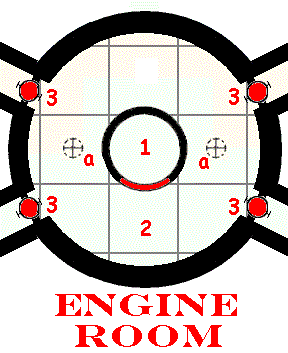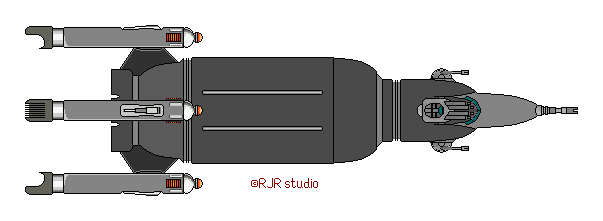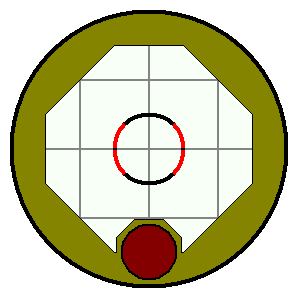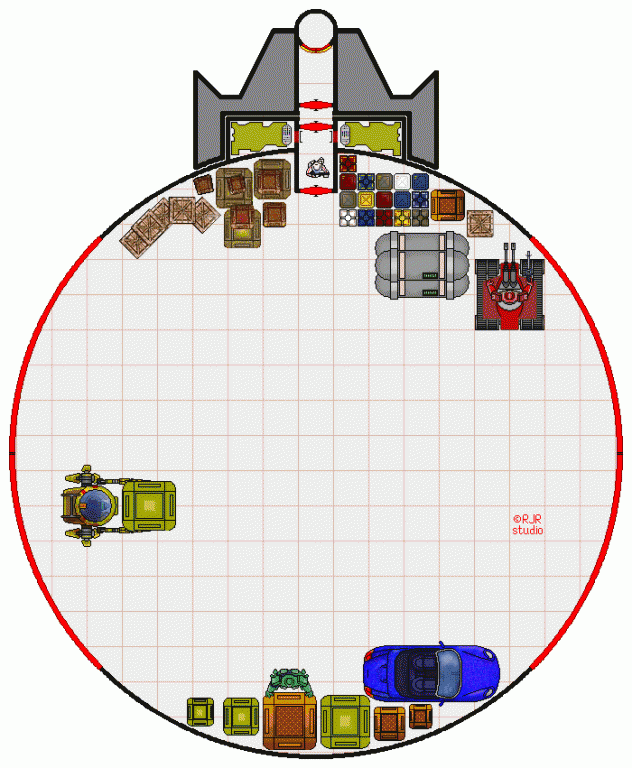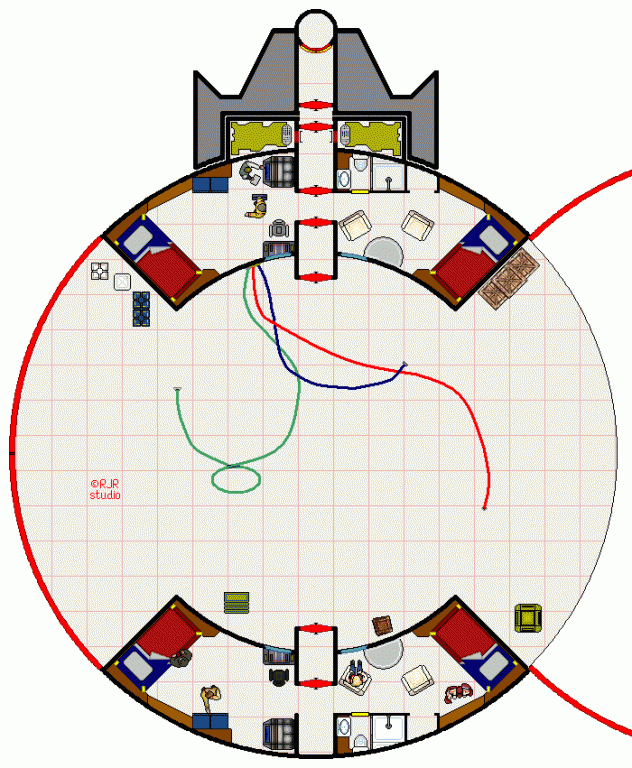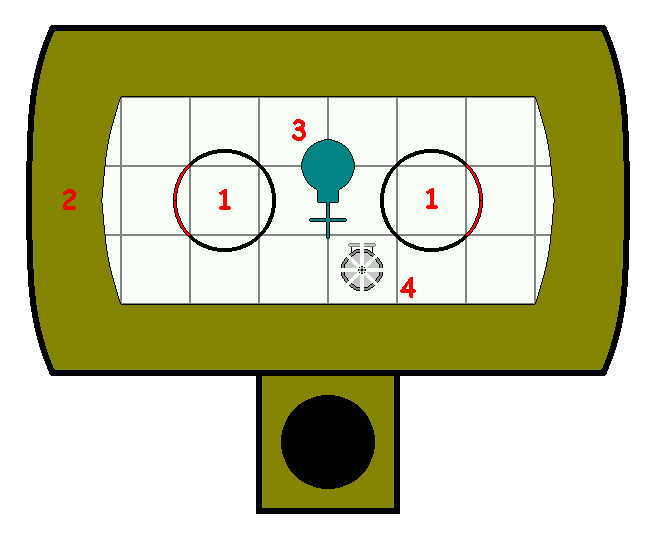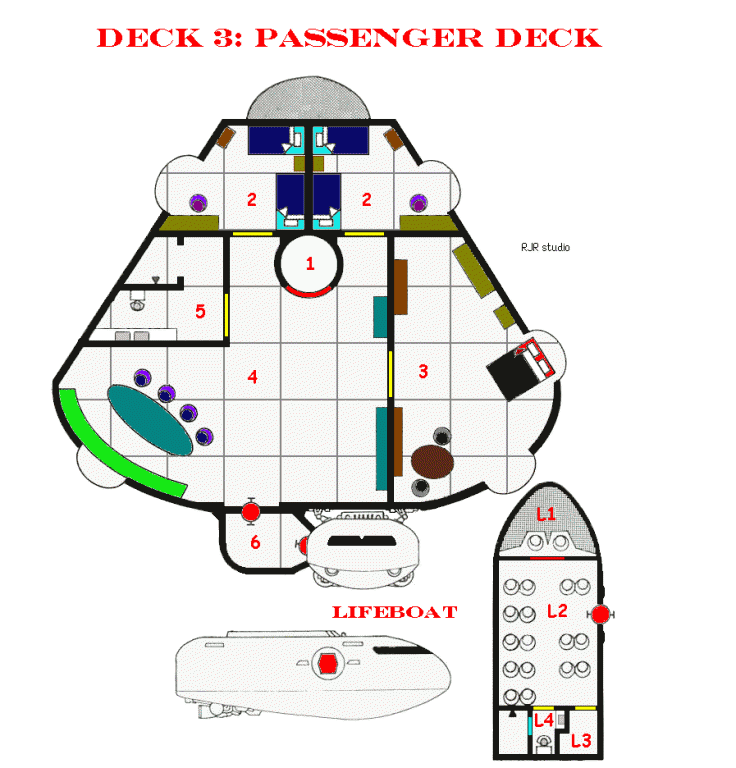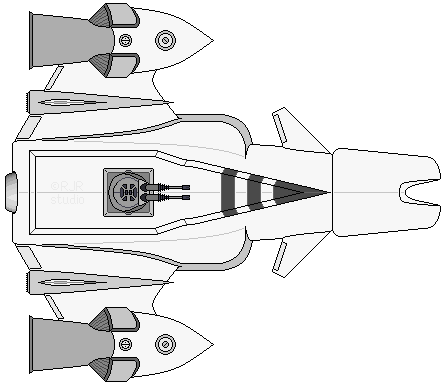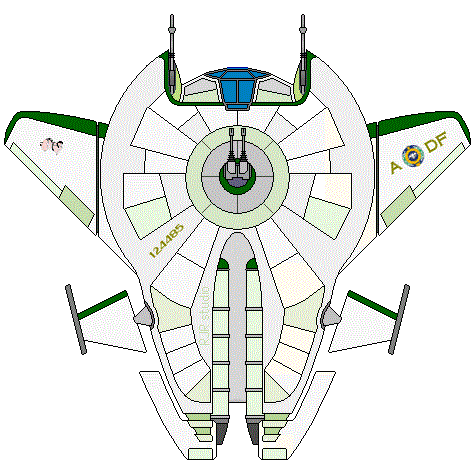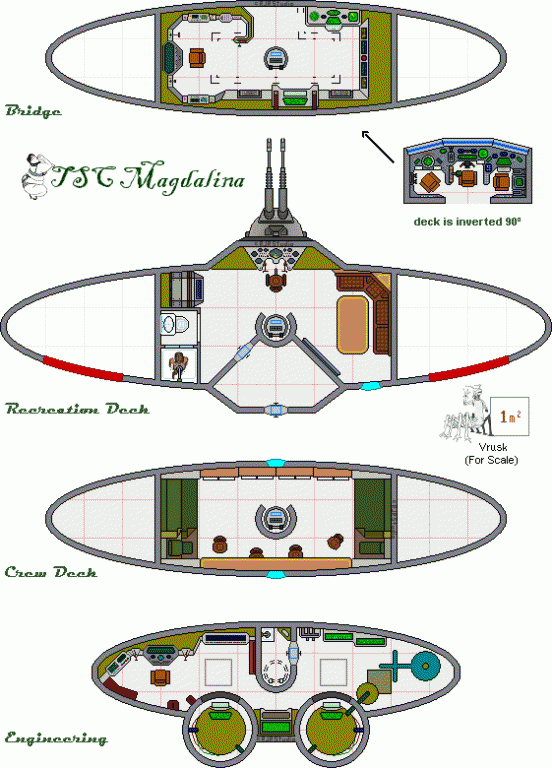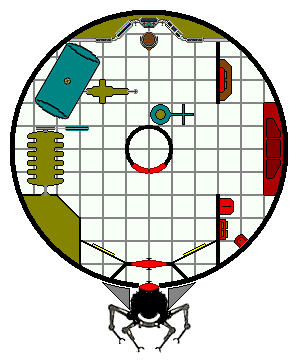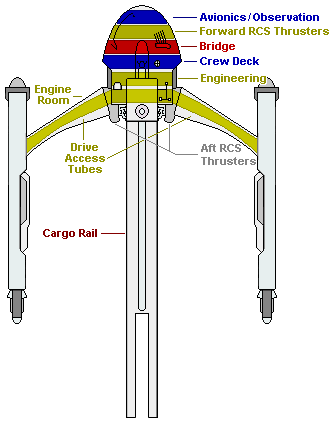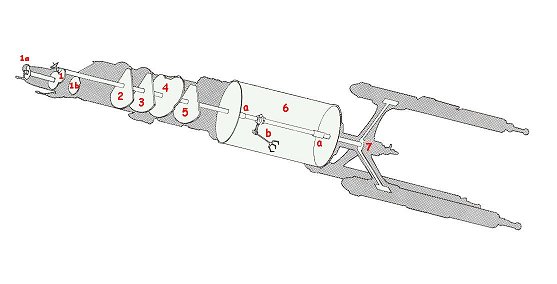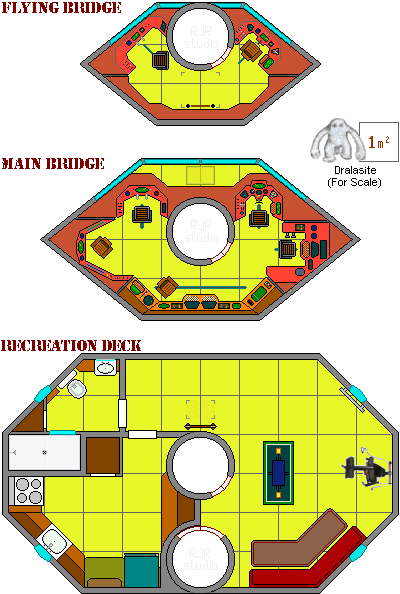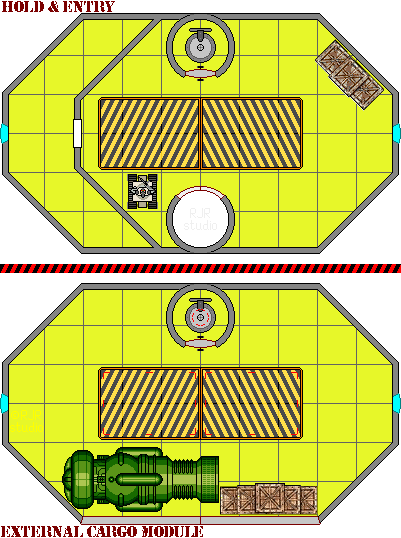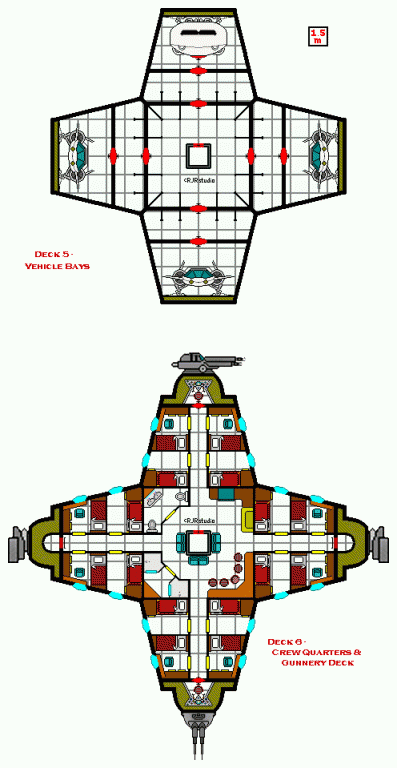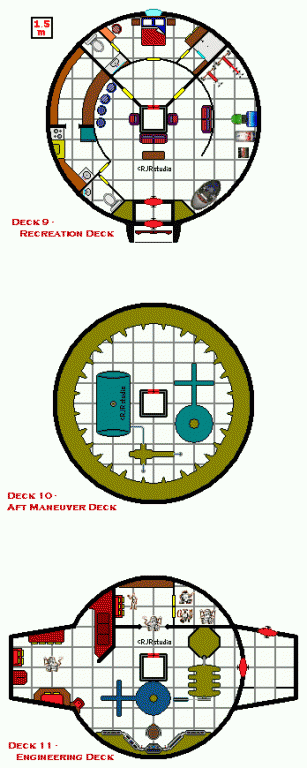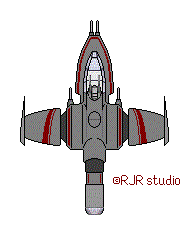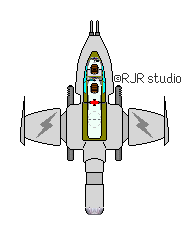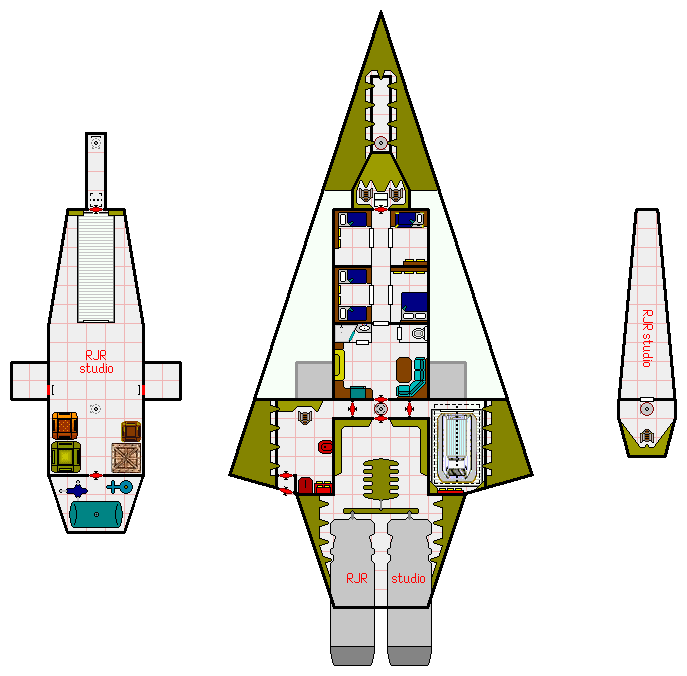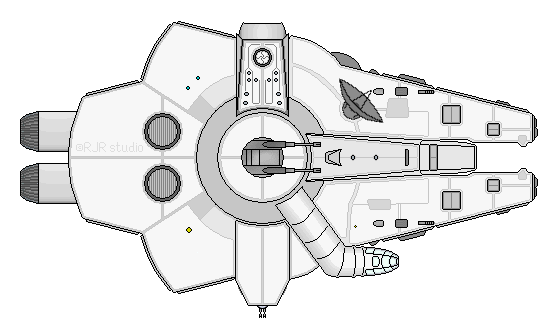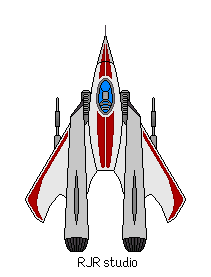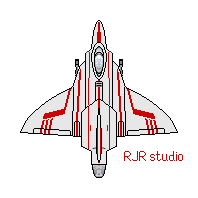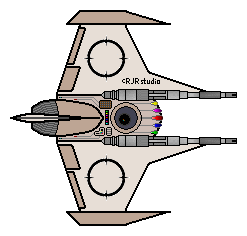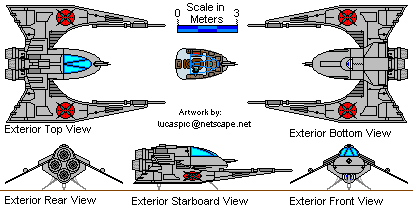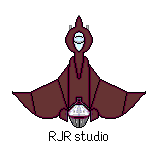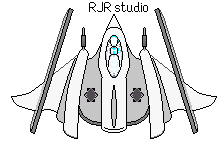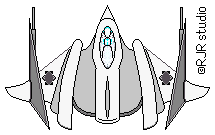Document container for project design documents. Feel free to browse and/or upload deck plans here.
Guide to Sathar Ships
Small Craft & Fighters
Attack Class Fighters
HP 8, ADF 5, MR 5, DCR 30
Weapons: AR x3
Defenses: RH
Data Source: Basic Game & Advanced Game; “Battle of Ebony Eyes” Dragon 88
Scorpion Clase Robotic Fighter
HP 10, ADF 3, MR 3, DCR 29
Weapons: LB
Defenses: RH
Data Source: “Day of the Juggernaut” Dragon #91
System Defense Class Shuttle
HP 10, ADF 4, MR 4, DCR 26
Weapons: n/a
Defenses: n/a
Data Source: War Machine
System Defense Class Fighter
HP 8, ADF 5, MR 5, DCR 23
Weapons: AR x3
Defenses: RH
Data Source: War Machine
Scout Ships
Clan Y Class Scout Ship
HP 10 (HS 3), ADF 6, MR 5, DCR 29
Weapons: n/a
Defenses: RH
Data Source: Face of the Enemy
Cutters
HP , ADF , MR , DCR ?
Weapons:
Defenses: RH,
Data Source: Blister Pack 5811
Frigates
Disease Class Frigate
HP 40, ADF 3, MR 3, DCR ?
Weapons: LC, LB, RB x4, Torp x1,
Defenses: RH, Masking Screen x2, ICM x4
Data Source: “Battle of Ebony Eyes” Dragon 88- SAV Disease, SAV Apocalypse
Stinger Class Frigate
HP 40, ADF 3, MR 3, DCR ?
Weapons: LC, RB x4, Torp x1,
Defenses: RH, Masking Screen x1, ICM x2
Data Source: Basic Game
Destroyers
Bludgeon Class Destroyer
HP 50, ADF 3, MR 3, DCR 75
Weapons: LC, LB, RB x 4, Torp x2, EB
Defenses: RH, Masking Screen x2, ICM x5
Data Source: Advanced Game- SAV Bludgeon, SAV Viper; WoWL- SAV Vampire (with only 4 ICM); “Raid on Theseus” Polyhedron #13- SAVs Villainous, SAV Maggot, SAV Assassin
Deathwind Class Destroyer
HP 50, ADF 3, MR 3, DCR 75
Weapons: LC, LB, RB x 4, Torp x2, EB
Defenses: RH, ICM x4, Decoy x1
Data Source: WoWL
Devastator Class Destroyer
HP 50, ADF 3, MR 3, DCR 75
Weapons: LC, LB, EB, RB x 4, Torp x3
Defenses: RH, Masking Screen x2, ICM x4
Data Source: WoWL
Nemesis Class Destroyer
HP 50, ADF 3, MR 3, DCR 75
Weapons: LC, LB x2, RB x 4, EB
Defenses: RH, Masking Screen x2, ICM x5
Data Source: Advanced Game
Pestilence Class Destroyer
HP 50, ADF 3, MR 2, DCR ?
Weapons: LC, RB x4, Torp x2,
Defenses: RH, Masking Screen x2
Data Source: Basic Game
Venomous Class Destroyer
HP 50, ADF 3, MR 2, DCR ?
Weapons: LC, LB, Torp x2,
Defenses: RH, Masking Screen x2
Data Source: Basic Game- SAV Venomous, SAV Vicious, SAV Doomfist
Minelayers
Light Cruisers
Deathstroke Class Light Cruiser
HP 70, ADF 3, MR 2, DCR 100
Weapons: DC, LB, EB, PB, RB x6, Torp x4
Defenses: RH, ES, SS, ICM x8
Data Source: Advanced Game- SAV Deathstroke; “Battle of Ebony Eyes” Dragon 88- SAV Famine
Flamewind Class Light Cruiser
HP 70, ADF 3, MR 2, DCR 100
Weapons: DC, LB, EB, PB, RB x8, Torp x4, S x2
Defenses: RH, ES, SS, ICM x5
Data Source: Advanced Game
Hellion Class Light Cruiser
HP 70, ADF 3, MR 2, DCR 120
Weapons: DC, LB x2, EB, PB, RB x6, Torp x4
Defenses: RH, ES, PS, SS, ICM x8
Data Source: “Raid on Theseus” Polyhedron #13
Heavy Cruisers
Carrion Class Heavy Cruiser
HP 80, ADF 2, MR 1, DCR 120
Weapons: DC, LB x2, EB, PB, RB x8, S x2, Torpx4
Defenses: RH, ES, PS, SS, ICM x8
Data Source: Advanced Game- SAV Carrion; “Battle of Ebony Eyes” Dragon 88- SAV Blood War; “Raid on Theseus” Polyhedron #13- SAV Ghoul, SAV Spectre
Perdition Class Heavy Cruiser
HP 80, ADF 1, MR 1, DCR 108
Weapons: LB x2, RB x4, Torp x2,
Defenses: RH, ICM x2
Data Source: Basic Game- SAV Perdition; War Machine- SAV Firestorm
Star Scourge Class Heavy Cruiser
HP 80, ADF 1, MR 1, DCR ?
Weapons: LC, LB x2, RB x4, Torp x4,
Defenses: RH, ICM x6
Data Source: Basic Game
Assault Carriers
Mothership Class Carrier
HP ?, ADF ?, MR ?, DCR ?
Weapons: LB x2, Grapples x2 (limited to HS 2-4)
Defenses: RH, Masking Screen ?, ICM x?
Plus 4-6 scout craft
Data Source: Face of the Enemy
Infamous Class Assault Carrier
HP 75, ADF 2, MR 1, DCR 105
Weapons: LB x2, RB x6,
Defenses: RH, ICM x4
Plus 5 fighter craft
Data Source: Basic Game SAV Infamous; War Machine- SAV Predator
.
Maelstrom Class Assault Carrier
HP 75, ADF 2, MR 1, DCR 150
Weapons: LB, PB, RB x8
Defenses: RH, Masking Screen x4, ICM x10
Plus 6 fighter craft
Data Source: Advanced Game
Stations
Nova Class Fortified Space Station
HP 300, DCR 150
Weapons: LB x5, RB x16
Defenses: RH, Masking Screen x4, ICM x12
Data Source: “Battle of Ebony Eyes” Dragon 88
Experimental
SAV Juggernaut
HP 480, ADF 1, MR 1, DCR 300
Weapons: DC, LB x 8, PB x2, EB x4, Torp (space to Ground missiles) x16, RB x20
Defenses: RH, ES, PS, SS, ICM x24
Plus 20 Scorpion robotic craft
Data Source: “Day of the Juggernaut” Dragon #91
Knight Hawks Deck Plans
See the menu below to view or upload new deck plans
Class:3 Space Station
Akyna class light freighter
PGCF-425 Akyna class Light Freighter
HS:4 HP:24 Powerplant:4 atomic A
ADF:4 MR:4 DCR:32 Crew: up to 8
Armament: 2 Laser Pod Turrets
Defenses: RH
Communication/Detection: SubSpace Radio, Radar, Intercom
Misc: Light Hull Armor, Streamlined
Computer (LVL:4 fp:115 SP:100)
Alarm(4), Analysis(4), Astrogation(4), Commerce (1), Communication (1), Damage Control (4), Drive (4), Industry (1), Life Support, cap:8 (1), Maintenance (4)
Cargo Capacity:3 (two 1.5u bays)
Crew Accomodations:4 double bunk cabins
Passenger Accommodations: N/A
Ship's Vehicles: N/A
Base Price: 1,821,730
Minimal Crew Requirements: Pilot/Captain, Astrogator, Engineer, 2 Gunnery officers
The Akyna is a versatile freight hauler that many a ship owner has cast a lustful eye upon. And for good reason, the ship is small enough for most able crews to operate in a wide variety of situations, fairly well armed and armored boasting the lighter grade hull armor along with a pair of laser turrets, and a readily expandable mainframe computer (with additional space allotted for the hardware makes future upgrades quick and easy to install).
The hull is streamlined, and all bridge and engineering deck stations are situated on rotating deck gimbals allowing them to pivot to a "main axis parallel" stance for atmospheric use. The 3-unit cargo space doesn't allow for large profits, but crews can charge a little extra for promptness in delivery along with the insurance via two laser turrets that the load will get there.
There are drawbacks to the basic design. With no workpods, any external work will have to be performed via spacesuits, specifically with the drives and wing mounted aft maneuver jet banks. As such, most populated worlds do not permit atomic drive overhaul procedures to occur in their breathable atmospheres. The craft may land and lift off at the local starport, and even perform routine maintenance...but once the reactor is exposed to the air, crews can expect a prompt visit from Star law and a resulting stiff fine and impound/quarantine fees to boot. More experienced crews are required for the ship as well, crews that may feel better suited for larger craft such as full-sized freighters and the like. Four drives to maintain & overhaul can be taxing to smaller crews, not to mention the additional fuel costs. Most owners are happy to absorb that to compensate for the additional defenses on the basic design.
The twin cargo holds are another anomaly. They are tiered for ease in loading, but are situated for space duty. This means any ground-based cargo acquisitions will take extra time to load (figure double the usual time). Note the partial decks on each level may also be folded up against the main hull to accommodate larger items. The ventral turret must also be positioned correctly for any landing (space station or starport), as the ground clearance is minimal with the landing gear. That said, atmospheric landings in rough or uneven terrain can cause damage to the ventral guns.
Also note the lack of emergency vehicles. No lifeboat, escape pods, or workpods means any attempt of escape would have to be executed in a launch, meaning launching oneself from an airlock. The two crew decks do not offer much privacy, so being friendly is a must. And despite new technology in the drives and other systems, the main artery between decks is a standard ladder well with airtight hatches on each deck. The upside to this is during atmospheric groundings, characters may easily walk between decks. All hatches are designed to open towards the ventral side so there is no hampering on opening hatches, although it may take a little extra effort to close them once opened.
Finally, the aft outer hull hatch is not easily defended when it comes to boarders. Crew members can find solace within the hold airlock hatchways for hard cover, and heavy weapon mounts on either side of said hatches are common upgrades. Additional crew may find cover behind any crates and such stored here, assuming such loads are present. Incoming baddies will also benefit from hard cover until they fully emerge from the side hatches as well. Lobbing grenades is the best bet for repelling intruders here. Most owners station a few robots here to meet additional security needs.
Customizing is an immediate option most owners perform. A Universal Docking Collar is easily affixed to the aft airlock, thus allowing one additional level of security measure for would be boarders that opt for standard entry. Up-gunning an additional 20 cubic meters worth of weaponry can be performed as well at a -1 ADF or MR penalty, either by adding a forward firing laser pod system or upgrading to full-fledged laser batteries. The computer maintenance shaft running between the bridge and recreation decks is a common hidey-hole used by smugglers, and oftentimes has been expanded to port for more space to indulge in such “small package trading”.
Deck plans are rendered in 1-meter squares
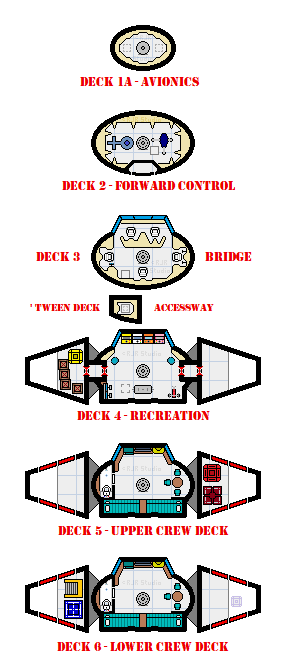
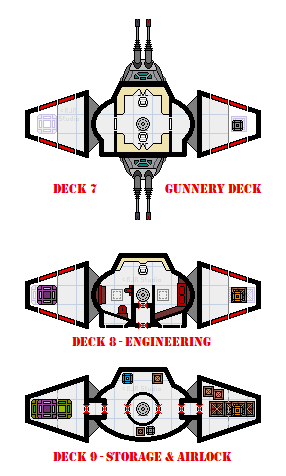
Aquilian Starling
SS Aquilian Starling (REVISED)
Salvaged/Reconstructed Starling class Light Transport
HS:3 HP:18 Powerplant: 2 Atomic A
ADF:5 MR:3 DCR: 30
Armament: LB
Defenses: RH
Comm/Detect: SubSpace Radio, VideoCom. Radar, Energy Sensor, Intercom, WNB
Misc Equipment: Streamlined, Light Hull Armor
COMPUTER ( LVL:4 fp:167 mass/SP:100 )
Alarm: 2
Analysis: 4
Astrogation: 4
Bureaucracy: 3
Commerce: 1
Computer Lock-Out: 4
Computer Security: 4
Cyber/Slave Interface: 2
Damage Control: 2
Drive (Atomic A): 4
Industry: 1
Information Storage: 1
Installation Security: 4
Laser Battery: 1
Life Support: 1 (cap:20)
Maintenance: 2
Robot Management: 4
Transportation: 1
Cargo Capacity: 3
Crew Accomodations: Captain's Suite + 4 dbl cabins
Passenger Accomodations: 1 First Class Cabin, 3 Journey Class Cabins
Ships Vehicles: none


The Aquilian Starling has a rich history, dating back before the founding of the UPF. She's an antique, the first of the series that left the SCC and entered into service back in pf:-100. A young Captain John Knightrazor (formerly Robert Kitridger) acquired it via a government contract co-signed by Streele, Inc. as a chartered privateer to counter the aggressive Mining Guild that was prevalent in Truane's Star back then.
Some time after th corporate skirmishes ended, the ship required major renovations after a near fatal encounter during the first Sathar War. The ill-fated Starling unknowingly dropped out of the void into a system that the Sathar Battle Fleet had already entered, and the ship took a severe beating. It would have no doubt been destroyed if not for the timely intervention of Admiral Morgaine's fleet, who arrived and made the unfriendlies feel most unwelcome. The Starling was taken in tow and it's crew began redesigning what they had left to work with.
When the war was officially over the Starling's crew were finally able to secure dock space for the reconstruction. The entire Chemical Thruster compartment had been destroyed along with the supporting external fuel tankage, and most of the forward starboard mandible was missing. Supplies were short and in demand so rebuilding the missing sections became a timely and costly endeavor, the crew instead opted for sealing up those sections and relocating any salvageable equipment. The original Ion Drives were replaced with Atomic Drives specced for a Class:4 hull. The replacement life support equipment that was destroyed in the fore section ended up on the open machine shop deck, while the new avionics equipment made the abbreviated starboard mandible a nearly impassible area to work in. Jonathan gifted the salvaged vessel to his son Stephen who regifted it as a trust fund to his son Jonathan after nearly ten years of freight hauling in favor of subcontracting a new RT model. Jonathan utlized it briefly after a stint in the StarFighter Corps, and he sold it to the current owner, adventurer Richard Sterling. Captain Sterling still owns and operates it today, with cyber-slave circuits installed so that Sterling's cyborg/wife could control and operate multiple systems from one location, thus allowing for a reduced crew. By this point the ship had gracefully aged to 176 years! It should be noted most of the major compnents were replaced in fy:3 so only the remaining hull is that old...but 73 year old equipment is still vintage by modern standards.
As a result of the salvage/reconstruction, the actual hull displacement ended up dropping from HS:4 to HS:3, but through clever restructuring of the cargo capacity remained the same, utilizing the original 1.5 unit detachable cargo pods. Maneuverability took a hit by retaining the pods, however much ike the stock Starling model the pods can be dropped to increase MR by one to MR:4. One additional benefit comes with the smaller size, with Class A drives designed to power a size 4 hull now powering the smaller displacement size 3 hull, the ship enjoys increased acceleration rates. In fact current owner Silver has logged some very respectable times in the Zebulon Run with "the Clunker" (as he affectionately calls her). Unfortunately that fame comes with a price for Silver, who prefers to avoid any interstellar attention...
Assault Frigate
original concept by Rob Nill, reproduced & reenvisioned with permission
HS:5 HP:40 Powerplant: 3 Class B Atomic Drives
ADF:3 MR:4 DCR:70 Crew: 24-30
Armament: AR(x12, 2 launchers), LB(x2), PLT(x4)
Defenses: RH, ICM (x12, 2 launchers)
Communication/Detection: Subspace Radio, VideoCom, Radar, Energy Sensor, WNB, Intercom network, Skin Sensors, Camera System
COMPUTER (Level:5 FP:216 Mass/SP:300)
Analysis (4)
Alarm (3)
Assault Rocket (1) x2
Astrogation (4)
Bureaucracy (3)
Communication (1)
Computer Lockout (3)
Damage Control (3)
Drive, Atomic B (5)
Information Storage (3)
Installation Security (3)
Interceptor Missile (3) x2
Life Support, cap:40 (1) x2
Laser Battery (1) x6
Maintenance (3)
Transportation (1)
Cargo Capacity: 1
Fuel Tankage: 18 plutonium or uranium fuel pellets (6/drive)
Crew Accomodations: captain's suite, 4 single officer cabins, 8 double bunk and 10 single crew cabins
Passenger Accomodations: 1 double occupancy suite
Ship's Vehicles: lifeboat, 4 escape pods; optional workpod
Constructed using a Class:5 hull, the standard UPF Frigate is the mainstay of the UPF Spacefleet. The vessel displaces 1600 tons and is staffed by up to 30 crew members. The Assault Frigate is a variant design intended for planetary militias, trading off superior acceleration for superior maneuverability. As such the spacious torpedo system is replaced with a pair of assault rocket launchers, each sporting a six rocket magazine and capable of firing two at a time. A quartet of pod laser turrets and a pair of full size laser batteries completes the weaponry, while the standard reflective hull is complimented with a pair of ICM launchers each containing six missiles. Aside from the pair of batteries, the weapons are geared for close combat and when the missile frigate achieve such ranges it is downright deadly. An optional workpod is available with docking gear on the engineering level, the second hatch gets relocated to the dorsal upper crew deck in lieu of the airlock for the 'pod.
(Editor's Note --- weapons & defenses were calculated via total cubic meters as listed on page 61 of the KH Campaign Book)
CREW ROSTER
Captain (Pilot:3+)
Co-Pilot (Pilot:3+)
Astrogator (Astrogation:1+)
Chief Engineer (Engineer:3+)
Auxiliary Engineers (x2, Engineer:1+)
Rocket Gunnery Officer (Rocket Gunnery:2+)
Energy Gunnery Officers (x6, Energy Gunnery:2+)
Communications Officer (Technician:1+)
Sensor Officer (Technician:1+)
Fire Control Officers (x4, Computer:1+)
Medical Officer (Medic:2+)
Technicians (x4, Technician:1+, Computer:1+)
Boarding Party (up to 6, Ranged Weapons:2+, Melee Weapons:1+)
Atlantic Class Freighter
submitted by Shadow Shack
Trans Travel TT5050 "Atlantic" Class Freighter
HS:5 HP:25 PowerPlant: 4 Atomic B
ADF:4 MR:3 DCR:35 Crew:up to 8
Armament: none (LB available at no penalty)
Defenses: none (RH available)
Communications/Detection: SubSpace Radio, Radar, Intercom (3 master panels, speaker/mike in each station/cabin/chamber)
Misc Equipment: Cargo Arm, Universal AirDock
Computer
(LVL:4 fp:167 SP:100)
Alarm (4)
Analysis (4)
Astrogation (4)
Commerce (1)
Communication (1)
Damage Control (4)
Drive - Atomic B (5)
Industry (1)
Information Storage (1)
Life Support cap:16 (1)
Maintenance (4)
Cargo Capacity:5
Crew Accomodations: Captain's Suite (double occupancy possible), Crew Cabin w/2 triple bunks
Passenger Accomodations: 1 First Class Cabin, 2 Journey Class Cabins (all double occupancy)
Ship's Vehicles: lifeboat, 2 workpods
Base Price: 2,489,400Cr --- does not include fuel, spacesuits, weapons/defenses, or toolkits
Trans Travel's TT5050 is a newer offering for independant haulers, she made her debut in f.y. 61 as a 20th anniversary of Trans Travel's Pacific release. Much like its sibling Pacific class freighter, the overall design makes it optimum for a wide variety of roles beyond cargo hauling, a crew can make additional income via the trio of passenger cabins as well as offering courier duties to local governments. Without drives the Atlantic measures 105 meters in length and 18 meters at its widest point (the hold). The deck arrangement is simple and straight forward, separating various duties efficiently enough. Many owners are quick to modify the basic design both during the construction phase or after acquisition. The optional Pan Galactic "Eureka" drive adds an extra 100,000Cr per drive and increases the ADF to 5. Like the Pacific, a laser battery may be added with no performance penalties.
The Atlantic hasn't caught on in terms of popularity, at least not compared to the original Pacific design from which it was cloned and reduced in size from. The additional drive and software required to operate it boosts the price above that of the Pacific and it carries less cargo. However, the higher performance is worth it to those willing to pay the price, more so with the optional Eureka drives which elevates it to scout ship performance in a freighter package.
Used samples can be had for 15 to 50% of new price, depending on condition & upkeep...but tend to be rare compared to the more frequent appearance of Pacific class samples out there (which have been in production for two more decades).
DECK PLANS FOLLOW

image edited from published material, copyright TSR
1a> Flying Bridge
1> Bridge
2> Crew Deck
3> Passenger Deck
4> Maintenance Deck
5> Cargo Hold
5a> Elevator Access Points to hold
5b> Cargo Arm
6> Aft Maneuver & Engine Room
Deck 0 - Flying Bridge
1> Flying Bridge w/positions for Pilot, copilot or computer operator, and Engineer - gimbal allows "star fighter" flight stance
2> Hydroponics
3> Avionics
8> Elevator to main bridge
Deck 1 - Main Bridge
image edited from original published material, copyright TSR
1> Main Elevator
2> Astrogator station
3> Chief Engineer station
4> Helm, position for pilot
5> Helm, position for optional copilot
6> Computer Room, 6a is a maintenance shaft. Small arms storage nearby
7> Optional Laser Battery, where applicable
8> Elevator to Flying Bridge
Deck 2 - Crew Quarters
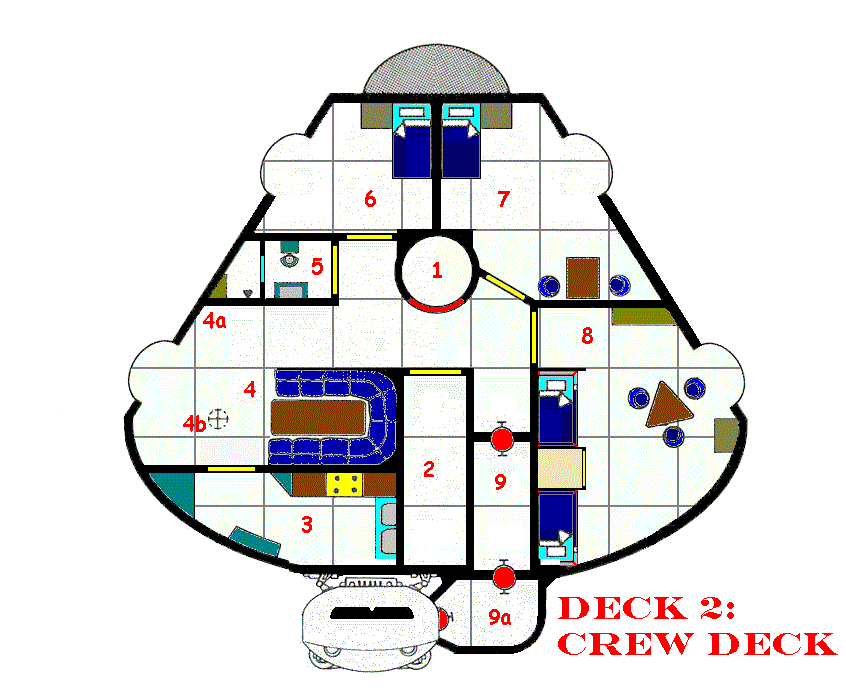
image edited from original published material, copyright TSR
1> Elevator
2> Storage Area
3> Galley
4> Common Area, 4a is the holo-entertainment console, 4b cieling hatch to computer maintennace shaft
5> Fresher/sanitation
6> Pilot's cabin
7> Captain's cabin & office
8> Crew Cabin w/2 double bunks
9> Inner airlock, 9a airlock to lifeboat
Deck 3 - Passenger Deck

image edited from original published material, copyright TSR
1> Elevator, 1a> heavy weapon mounts
2> Airlock w/Universal Docking Collar and gunports
3> Common Area
4> Fresher/sanitation
5> Journey Class Cabin
6> First Class Cabin
7> Storage closet
Deck 4 - Engineering

image edited from original published material, copyright TSR
1> Elevator
2> Engineer's Station (half of overhaul time spent here)
3> Freight Handler Station
4> Workshop - 4a is a laser/lathe. 4b is a laser drill press, 4c is a workbench w/tool storage, 4d is a foundry
5> Life Support unit, 5a floor access to water purification plant and water tanks
6> Misc Storage
7> Parts Storage
8> Workpod Airlock pens & floor access to hydroponics
9> optional back up LS unit (not standard equipment)
10> Power Relay Station
11> Generator
Deck 5 - Cargo Hold

1> Elevator
2> Airlock
3> Cargo Arm tracks
4> Hold
5> Bay Doors
Deck 6- Engine Room
1> Elevator
2> Monitor Panels, 2a is a cieling accessway to the aft maneuver jet banks above
3> Airlock/Decontamination Chambers, access to engines
half of overhaul time spent within engine room and drive accessways
Black Condor class pirate frigate
HS:5 HP:35 Powerplant: 3 Atomic B
ADF:4 MR:3 DCR:50 Crew:8-40
Armament: LC, LB(x2), RB(x4)
Defenses: RH, MS(x1), ICM(x5)
Communications/Detection: SubSpace Radio, WNB, Intercom; Radar, Energy Sensor
Misc. Equipment: optional Cargo Arm
COMPUTER
ALARM (3)
ANALYSIS (4)
ASTROGATION (4)
BUREAUCRACY (2)
COMMUNICATION (1)
COMPUTER LOCKOUT (5)
COMPUTER SECURITY (4)
DAMAGE CONTROL (3)
DRIVE (ATOMIC) (5)
INDUSTRY (1)
INFORMATION STORAGE (1)
INSTALLATION SECURITY (4)
INTERCEPTOR MISSILE (3)
LIFE SUPPORT cap:56 (1)
LASER BATTERY (1) x2
LASER CANNON (1)
MAINTENANCE (3)
ROCKET BATTERY (2)
Cargo Capacity: 2.5
Crew Accomodations: 2 single-bunk cabins (officers), 2 two-bunk cabins (crew), 2 three-bunk cabins (additional crew), 2 four-bunk cabins (troops)
Passenger Accomodations: 12 (cells @ brig)
Ship's Vehicles: 2 workpods
Deck 00 - Forward Observation
Scale is 2 meters per square
Most of the ship's avionics & sensor equipment can be maintained here along with access to the primary weapon system for diagnostics and service. The central elevator traverses the ship from stem to stern and is a common feature on each deck.
Deck 01 - Bridge

The helm is centered at the dorsal end with command chairs for a pilot and co-pilot (only one is needed but a second can assist with the cannon). To starboard (far left on the map) is the astrogator station, opposite that to port (right side of map) is the chief engineer's station. A computer technician (optional) may assist and monitor overall ship operations between the helm & astrogator stations, and an optional communications & detection officer can work betweenthe helm and engineering.
Deck 02 - Gunnery

The gunnery deck, located just aft of the bridge, is a simple lay-out with a rocket battery taking the dorsal position and a laser battery on both port & starboard positions. The ventral area is a magazine where additonal rocket battery arrays are stowed, these can be loaded into the weapon system any time during normal operating conditions (i.e. not during high grav combat maneuvers).
Deck 03 - Officer Quarters

A double bunk cabin can be found on both the port & starboard sides, typically one will accomodate the pilot/captain & co-pilot while the chief engineer & astrogator reside in the other. A lounge & dining area is on the dorsal end while a fresher and galley occupy the ventral side.
Deck 04 - Forward Maneuver Jets

This deck is surrounded the RCS maneuvering nozzle equipment, and is rarely visited unless said equipment is inneed of service or repair.
Deck 05 - Fore Crew Quarters
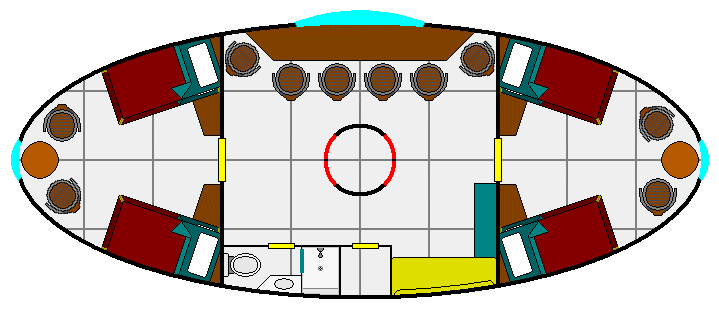
The Fore Crew Quarters occupies the first deck where the frigate begins to fatten up in size. Two cabins each furnished with a pair of double bunks along wardrobe closets and a table & chairs can be found port and starboard, typically the gunnery offices and the troop commander will occupy one while the other hosts higher ranking crew members such as medics, roboticists, and auxilliary engineers. A lounge/dining area is on the dorsal end with a fresher and galley on the ventral end.
Deck 06 - Aft Crew Quarters
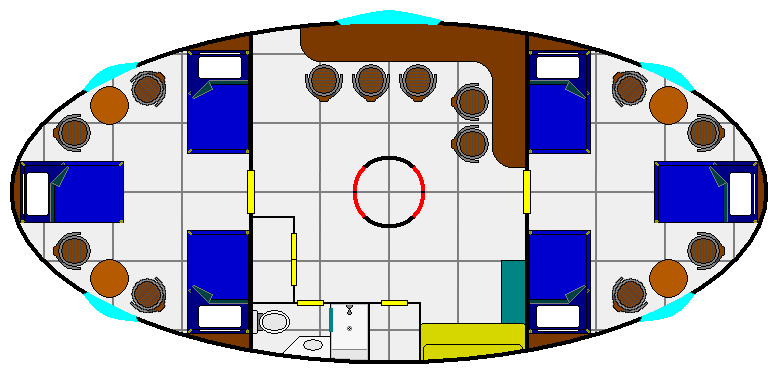
The Aft Crew Quarters is nestled just below the Fore Quarters and is basically the same albeit at a larger scale with a trio of double bunks and additional table & chairs taking up the additional space provided. A lounge & dining area occupies the dorsal side while a fresher and galley take up the ventral side. A small storage clost is adjacent to the fresher that can accomodate tool ktis and other work related items stowed by the crew. Typically the various techs that keep the ship in operation resid eher although additional troops can take up residence here as well.
Deck 07 - Troop Quarters

A quartet of double bunks with a table and chairs nestled tightly within occupy the port and starboard sides while a larger lounge & dining area takes up the dorsal side. An airlock & Universal Docking Collar takes up the ventral side and is flanked by a galley to port and a fesher to starboard. The ship's troops take up residency here regardless of overall crew size.
Deck 08 - Administration
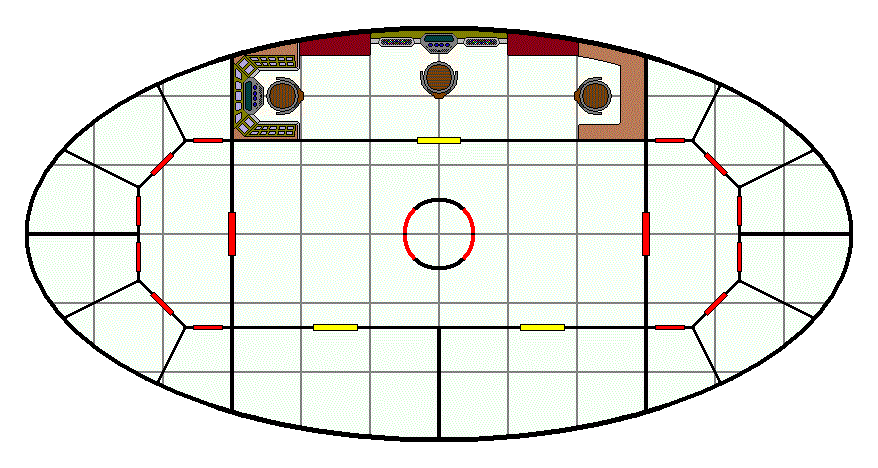
The operations center takes up the dorsal area with a computer station, surveillance station, storage racks, and a captain's desk. Brigs with six cells each are located port and starboard, each cell is furnished with a folding bunk, sink & toilet, and a chair. The two rooms on the ventral side tend to be utilized randomly by each crew, they can be converted to medical or scientific labs, storage areas, or additonal cabins (typically if the captain is not one of the bridge officers he/she will have a cabin here).
Deck 09 - Cargo Hold

The majority of the widest portion of the ship is the cargo hold. Bay doors are located both dorsally and vetrally, and airlocks are located fore/top and stern/bottom of the elevator shaft. A cargo arm can be affixed between the airlocks if the crew opts for such equipment.
Deck 10 - Aft Maneuver Jets

Like the Forward Maneuver deck, RCS maneuver nozzle equipment surrounds this area with the notable difference being the water purification plant and life support equipment found here. As such this deck gets a bit more traffic than its forward counterpart.
Deck 11 - Engineering

This is the nuts and bolts end of the pirate frigate...an engineering station occupies the ventral side of this bay and is typically manned by an auxilliary engineer around the clock (50% of the atomic drive overhaul work is spent at this analytical/coordinating center). An additional pair of techs are also stationed here around the clock and can access rumble seats on either side of the command chair for combat maneuvers. The dorsal end houses a generator and power relay station and the open areas are spaced with floor & ceiling panels that can be removed to access the various system conduits within. A workshop occupies the starboard side while a foundry can be found to port. Adjacent to each of those are the workpod pens.
Deck 12 - Engine Room

The ship's trio of atomic drives can be accessed here via combination decontamination/airlocks. Monitoring equipment for each drive encircles the main area, the other 50% of overhaul work is spent with this equipment and withinthe drives themselves. Thecentral area has a trio of techs monitoring the equipment around the clock and a rumble seat folds out of each station for combat maneuvers.
Corsair Container

Container Size: 5
Hull Points: 40
ADF/MR: 0/0 DCR: 90
Armament: PLT (x2)
Defenses: RH
Communications/Detection: SubSpace Radio, Radar, WNB, Intercom
Misc: Heavy Armor
COMPUTER
Bureaucracy (3), Computer Lockout (3), Computer Security (4), Damage Control (2), Industry (2), Installation Security (4), Laser Battery (1, x2), Life Support (1), Maintenance (3), Robot Management (4)
Cargo Capacity: 1
Crew Accomodations:
Passenger Accomodations:
Vehicles: 5 fighters
Crew Positions
commander
5 fighter pilots
1 shuttle pilot
8 gunners
chief engineer
6 aux engineer (inc 5 crew chiefs)
astrogator
6 computer operators (inc 5 fighter crew)
medic
20 technicians (inc 15 fighter crew)
6 roboticists (inc 5 fighter crew)
12 troopers
The Corsair Container is a customized CC-500 container module converted by pirates for luring unwary container ships into their midst. Any ship unfortunate enough to load such a container to their universal cargo rail is in for a nasty surprise, as the corsair's twin laser turrets come online in a perfect position for taking out the host ship's drives and maneuvering systems. And for any cautious ship approaching, TT vessel or otherwise, the container hosts a squadron of five fighter craft equipped with pod lasers and turrets that can disable such craft just as efficiently. Worse yet, any pirate fleet containing a TT container ship can incorporate this module as a mini-carrier, thus enhancing that fleet with a squadron of deadly fighter craft (although the turrets would be limited to rear firing only, being obstructed by the engine struts and hull to prevent fore, port, or starboard target acquisitions).
The container's actual hold is minimal, sufficient for storing supplies to keep the operation going more than valuable cargo. To this end, such containers pressed into service tend to orbit a derelict planet or moon (or drifting near such bodies) where actual valuables can be stored for later pick up by a parent ship, oftentimes accompanied by a small outpost set-up for additional crew and supplies. A shuttle ferries goods and crew back and forth from the settlement to the container, which is typically berthed at the surface compound (although there is a berth on the container to host the shuttle, however it is rare to encounter the module with shuttle attached as it serves to give away the station's nature).
At the fore is the command deck and administration deck, aft of that is the small hold. Five separate fighter support decks follow, each with cabins to support the fighter crews. A crew quarters deck and maintenance deck rounds out the design at the stern. A lift shft connects all decks, and is modular to accept the lift from a host container ship as well. Obviously the design of this container is to lure unsuspecting TT ships to pirate groups wishing to obtain such craft for their own use, and as such the design is a very formidable one.
Deck 1 - Command
The command deck hosts the operational centers of the corsair container module. Centrally located is the commander's station, flanked by a communcations array (NE), radar center (SE), systems op center (SW), and the mainframe computer (NW). Port and starboard are the fire control stations for the two laser turrets.
A maintenance robot is typically berthed within the mainframe computer access (adjacent to the station), and a trio of combat robots are berthed adjacent to the communcation arrays. A second maintenance 'bot is contained within the sensor array access, and the station's armory is located adjacent to the op center along with another trio of combat robots.
The dorsal side hosts the docking module/lift shaft, and a shuttle berth occupies the ventral side complete with an airlock and docking collar.
(all deck plans utilize one meter squares)
(some interior details originally from ColonialChrome.co.uk)
Deck 2 - Administration
The administration deck handles the rest of the station support. Starting at 12 o'clock on the deck plan below and going clockwise is the docking center/lift shaft access, full service galley and fresher, a recreation center with holo-entertainment and workout equipment, a brig with two double occupancy cells, seven single occupancy cells, and a pair of frozen storage rooms; a medical bay with three surgical centers plus a freeze field center, and a meeting room. Located centrally is the traffic control center used to coordinate the fighter squadron and shuttle arrival/departure.
Deck 3 - Cargo Hold
The cargo hold is an open area intended to store wares for the independant station crew. With a 10 meter ceiling it doesn't support much in the way of massive valuable collections of swag, but it holds more than enough goods to sustain the crew.
Deck 4 - Fighter Bay #1
The Corsair Container houses five separate fighter bays, taking up the bulk of the station. Each bay has quarters for eight, occupied by a pilot, gunner, a computer operator, and an engineer/deck officer plus a team of several technicians for upkeep and repairs. Each quarters section has a mini-galley and a fresher, along with a lounge and exterior atmosphere control/monitoring station. Most importantly is the open area designated to berth and secure a single fighter craft, which just fits into the confines and through the bay doors. Fortunately with the station in constant weightlessness (except during transport via a container ship), the confines aren't an issue.
Deck 5 - Fighter Bay #2
Same as Fighter Bay #1, this depicts the interior details of the two man fighter craft.
Deck 6,7, & 8 - Fighter Bays 3-5
Again, similar to Fighter Bays 1 and 2...this depiction shows a vacated bay. Bays 3, 4, and 5 are otherwise the same.
Deck 9 - Aft Quarters
This deck houses the remaining officers and crew members. Commanding officers occupy the two double occupancy cabins, crew occupy the triple and quadruple occupancy cabins. A communal lounge fills the center, circled by entertainment consoles, refrigeration unit, and a mini-galley, and a fresher rounds it out on the ventral side.
Deck 10 - Maintenance Deck
The nuts and bolts end of the station rests in the stern. Flanking the docking platform/lift shaft ont he dorsal side is a life support unit and water tankage with a purification plant. A pair of workpods reside in separate bays port and starboard, with a trio of maintenance robot berths adjacent to each bay. Located ventrally is a nuclear reactor, its chamber is flanked by a pair of airlock accessways complete with decontamination equipment and insuit storage Adjacent to port of the reactor chamber is a generator and power relay station, starboard of the chamber has a large parts egress/airlock. Located centrally is an engineering station that monitors power and operations, along with a complete workshop ventrally adjacent of the engineering station.
S-200 Assault Shuttle
armed shuttle craft

HS:2 HP:12 Poweplant: 2 chemical A
ADF:2 MR:4 DCR:26 Crew:2
Armament: PL, PLT
Defenses: RH
Communications/Detection: SubSpace Radio, Radar
Misc: Light Armor, streamlined
COMPUTER
Alarm (2), Analysis (2), Astrogation (2), Computer Lockout (3), Damage Control (2), Installation Security (3), Laser Battery (1), Laser Cannon (1), Life Support (1, capacity:12), Maintenance (2)
Cargo Capacity: 0.5 or personnel
Crew Accomodations: 2 command chairs
Passenger Accomodations: 12 folding acceleration seats
Vehicles: 0
The S-200 is an armed shuttle craft, appropriately enhanced to protect its load during transit. As such it has been upgraded with system ship astrogation equipment, intended for longer range missions beyond standard surface to orbit shuttle flights. The cargo area can be quickly adapted for goods or personnel, and the aft turret can be accessed in the hold by one of the assigned crew.
S-4 Corsair
tactical assault fighter
HS:1 HP:8 Poweplant: 2 atomic A
ADF:5 MR:4 DCR:30 Crew:2
Armament: PL, PLT
Defenses: RH
Communications/Detection: SubSpace Radio, Radar
Misc: Heavy Armor
COMPUTER
Alarm (2), Analysis (2), Astrogation (2), Computer Lockout (3), Damage Control (2), Installation Security (3), Laser Battery (1), Laser Cannon (1), Maintenance (2)
Cargo Capacity: 0
Crew Accomodations: 2 command chairs, no life support
Passenger Accomodations: 0
Vehicles: 0
The S-4 Corsair is a lethal weapon when considering civilian ship engagements. Even so, it has more than enough firepower to ward off military fighter craft as well, but acting alone they would have trouble against larger warships. Operating as a squadron, the opposition's risk increases once more.
Boasting twin atomic drives (with jump governors installed), the extra grunt permits a larger array of weaponry without affecting performance much. As a civilian design, it is actually quite remarkable despite the additional costs involved.
Even so, there are obvious corners that were cut. First and foremost being the lack of any life support equipment. Which is fine considering the nature of the craft, it's not meant as a long range patrol vessel. Also noteworthy is the lacking auto-eject module and associated stress analysis software package, which forces a pilot to think about the situation he/she is about to get into. While there is ample room for such equipment, it was left out (but shouldn't be much of a hassle to add later on). Noteworthy is the addition of a second command chair for a gunner, the unlimited firepower of the pod lasers in conjunction with the 360º laser turret makes this something of a contender in any arena.
Courier Scout
HS: 2 HP: 10 Powerplant: 2 Ion A, 4 passive Chemical A/RCS thrusters
ADF: 2 MR: 4 DCR: 26 Crew: 1-4
Armament: LB (range: 60K)
Defenses: RH
Communication/Detection: SubSpace Radio, VideoCom, Radar, Intercom
Misc Equipment: Streamlined
Computer (LVL:4 fp:90 SP/mass:100)
Alarm (2)
Analysis (4)
Astrogation (4)
Commerce* (1)
Communication (1)
Computer Lockout (3)
Damage Control (2)
Drive: Ion A (3)
Drive: Chem/RCS A (1)
Industry (1)
Information Storage* (1)
Installation Security (3)
Laser Battery* (1)
Life Support, cap:4 (1)
Maintenance (2)
Cargo Capacity: 1 (two 0.5 unit holds)
Crew Accomodations: 2 convertible single/double cabins
Passenger Accomodations: n/a
Ship's Vehicles: none
Base Price: 644,380Cr , 515,864Cr for bulk (6+ unit) orders
Demilitarized/Surplus Assault Scout
HS:3 HP:15-24 Powerplant: n/a, set up for 2 Class A drives
ADF:0* MR:4 DCR:30 Crew: up to 8
Armament: none, provision for one LB w/ no penalty
Defenses: RH (may need fresh coating...)
Communication/Detection: Subspace Radio, Radar
Misc Equipment: streamlined, possible hull armor...
COMPUTER ( LVL:3 fp:40 mass/SP:20 )
Alarm: 2
Analysis: 4
Astrogation: 4
Damage Control: 2
Life Support: 1 (cap:8)
Cargo Capacity: 0.5
Fuel Tankage: n/a
Crew Accomodations: 4 double cabins
Passenger Accomodations: 0
Ship's Vehicles: none
A typical Assault Scout sees 15-20 years of service in the UPF followed by another 15-30 years in a planetary militia (although some militias buy theirs new). After which, these well served craft are stripped down/demilitarized and offered wholesale to the public. All armor and weapons are removed along with ship's vehicles, although an armored scout does make it to market on occasion. Note the hardpoint socket remains intact so restoring the laser battery is a simple affair and will not penalize the ship's performance. It can also be modified to an observation dome if desired. The computer is wiped and reformatted, and all military related programs are purged. As such they come with a minimalist computer software package. Buyers must obtain drives and a corresponding a new A-drive program first and foremost, although on occasion a surplus scout may make it to market with well worn drives that wil need maintenance and overhauls (but will never be restored to original ADF:5 without the military drive software and enhancement packages). Figure cost at 600,000Cr minus (age X 1%) for a fully stripped model, although typically these vessels are auctioned to the highest bidder.
* ADF varies after drives and computer program are acquired
(deck plans below are rendered in 2-meter squares)
Eorna heavy fighter
E-1A Heavy Fighter
HS: 2 HP: 12 Powerplant: 2 atomic A
ADF: 5 MR: 4 DCR: 40 Crew: 3
Armament: AR(x3), PLT
Defenses: RH
Comm/Detection: SubSpace Radio, Radar, Intercom
Misc Equipment: Light Armor
COMPUTER
Alarm (2)
Analysis (4)
Assault Rocket (2)
Astrogation (4)
Computer Security (4)
Damage Control (2)
Drive, Atomic A (4)
Industry (1)
Information Storage (1)
Installation Security (4)
Laser Battery (1)
Life Support (1)
Maintenance (2)
Cargo Capacity: 0
Crew Accomodations: 0
Passenger Accomodations:0
Ship's Vehicles: none
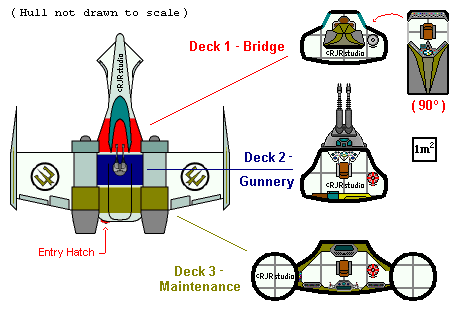
Escort Frigate (light frigate)
PGCMS-52FE Frigate/Escort
(Light Frigate)
HS: 5 HP: 30 Powerplant: 3 Pan Galactic "Eureka" Atomic B
ADF: 4 MR: 3 DCR: 60 Crew: 24
Armament: LC, LB(x2), RB(x4)
Defenses: RH, MS(x2), ICM(x4)
Communication/Detection: SubSpace Radio, VideoCom, Radar, Energy Sensor, WNB, Intercom
Misc: Light Armor
Computer
Alarm (3)
Analysis (4)
Astrogation (4)
Bureaucracy (1)
Commerce (1)
Communication (1)
Computer Lockout (6)
Computer Security (5)
Damage Control (3)
Drive (5)
Industry (1)
Information Storage (1)
Installation Security (5)
Interceptor Missile (3)
Laser Cannon (1)
Laser Battery (1) x2
Life Support, cap:32 (1) x2
Maintenance (3)
Cargo Capacity: 2.5
Crew Accomodations: 1 dbl suite, 7 dbl cabins, 2 quad cabins
Passenger Accomodations: 2 dbl suites, 2 dbl cabins
Ship's Vehicles: small launch, 2 workpods, shuttle
An updated design that was originally seen following the first Sathar War, this ship utilizes most of the structure from those original warbirds produced after said war. However, the layout is about all that remains. Modern military electronics and miniturization allows for a versatile ship that is both effective in smaller engagements as well as transport duties. The Escort Frigate, occassionally referred to as a Light Frigate, has a smaller crew than the full warbird equivilent. Ditching the torpedo system, the trade off is performance. Pan Galactic's infamous "Eureka" atomic drives push the envelope for a capital ship, offering extensive acceleration seen only in smaller craft. Naturally the Light Frigate can not tackle fleet engagement as it is somewhat lacking in terms of front line duty, but it is well armed against pirates and other smaller threats.
Space Fleet and local militias alike use these vessels (the latter being the most common), and several civilian organizations have acquired them as well via government charters. The passenger decks are not lavishly equipped but serve their purpose. The cargo hold is not large enough to be profitable either, but it accents a fleet's capacity in terms of transferring goods without dispatching a warship away from duty for such trivial pursuits. Escorts in the service of a planetary militia typically join with any Space Fleet vessels insystem as an envoy, as well as serving as a flagship for those militias that don't employ a full on warship frigate or destroyer. Space Fleet uses them as advanced scout craft to compliment the firepower of their assault scouts as well as detached duty vessels that range ahead or venture on return trips without sacraficing any warships from the current maneuvers.
It should be noted this is a para-military design and as such it is not readily available to civilians without a government contract.
Deck 01 & 02 - Forward Sensors & Maneuver Jets
Deck 1 - Forward Sensors
Deck 2 - Forward Maneuver Jets
Deck 03 - Bridge

Deck 04 - Crew Quarters

Deck 05 - Gunnery

Deck 06 - Auxiliary Crew
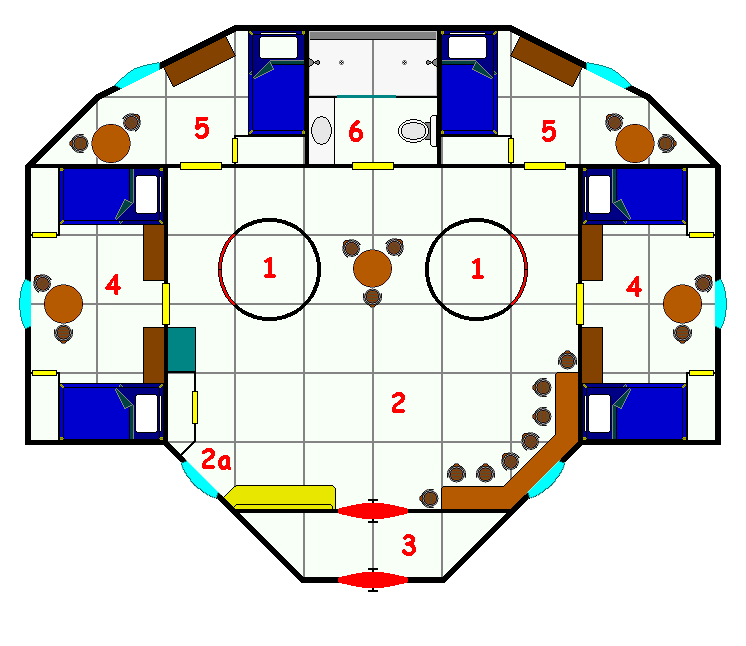
Deck 07 - Passenger Level
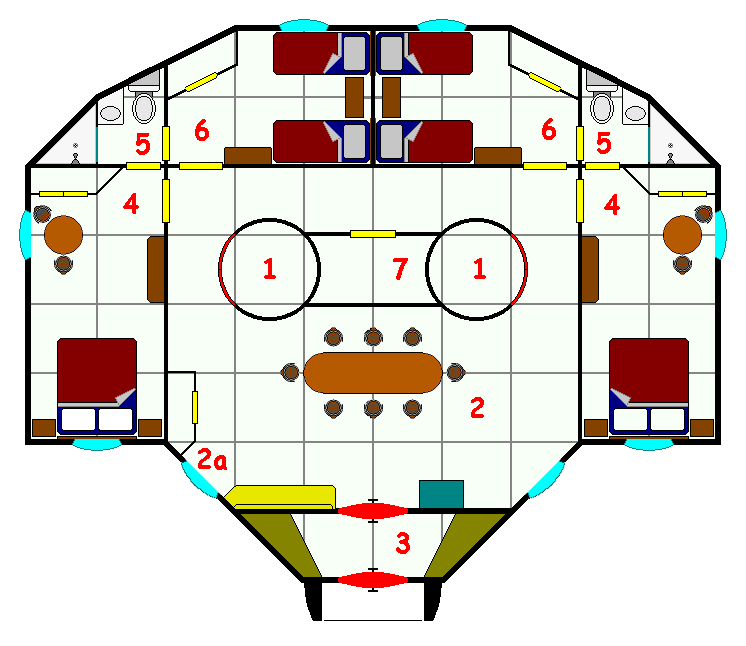
Deck 08 - Cargo Hold

Deck 09 - Aft Maneuver Jets

Deck 10 - Engineering

Gullwind
Deck Plans from the Dramune Run re-mastered project
Level B: Bridge
Level A: Crew Deck
Level C: Passenger Deck
Level D: Maintenance Deck
Gunned Scout
WarTech GS-3 Gunned Scout

HS:3 HP:15 Powerplant: 2 Atomic A
ADF:5 MR:3 DCR:50
Armament: FF-only LB, LB
Defenses: RH
Comm/Detect: subscape radio, radar, intercom
Misc Equipment: streamlined
COMPUTER ( LVL: fp: mass/SP: )
Alarm: 2
Analysis: 4
Astrogation: 4
Computer Lockout: 3
Damage Control: 2
Drive (atomic A): 4
Industry: 1
Information Storage: 1
Installation Security: 3
Laser Battery: 1
Laser Cannon: 1
Life Support: 1 (cap:8)
Maintenance: 2
Robot Management: 3
Transportation: 1
Cargo Capacity: 5000kg (personal items)
Crew Accomodations: 4 dbl cabins
Passenger Accomodations: n/a
Ships Vehicles: none
The GS-3 is the predecessor of the assault scout. The forward firing system is comprised of the guns from a laser battery fixed in a forward firing position (essentially a "light laser cannon", hence the LC program). The dorsal laser battery is a standard battery. The atomic drives have been retuned for more acceleration at the cost of reduced maneuverability. Once the assault scout was introduced, it replaced the gunned scout in SpaceFleet. However, the gunned scout is still available to planetary militias as well as civilian applications (albeit performance is standard ADF/MR: 4/4 for the latter market), which tend to favor mega-corps and the like.



HS:12 Freighter (REDUX)
TT-1200F Argosy class freighter

HS:12 HP:60 Powerplant: 4 Atomic class-B
ADF: 3 MR: 3 DCR: 56 Crew: up to 14
Armament: N/A (up to two LB at no penalties)
Defenses: RH
Communication/Detection: SubSpace Radio, VideoCom, Radar, Intercom Network
Computer (LVL:4 fp:135 SP:100)
Alarm (4), Analysis (4), Astrogation (4), Commerce (1), Communication (1), Computer Lockout (4), Damage Control (4), Drive - Atomic B (5), Industry (1), Information Storage (1), Life Support cap:20 (1), Maintenance (4)
Cargo Capacity:12
Crew Accommodations: Captain's Suite (double occupancy)
2 Crew Cabins (two single to triple bunks each)
Passenger Accommodations: 1 First Class Cabin (double occupancy) 2 Journey Class Cabins (double occupancy)
Ship's Vehicles: Lifeboat, 2 WorkPods
MISC: Medical Bay (can be converted to another Journey Class or crew cabin)
1 square = 2 meters


The Observation Dome is a small retreat deck featuring a sofa, coffee table, and a minimal bar with an entertainment center.
The Auxiliary Bridge contains additional electronics such as communications and sensors to port (left of map) and starboard (right of map) respectively, and a pair of computer monitoring stations dorsally. A ship’s locker is ventral, typically used to stow passenger items such as weapons and ammo. Crew weaponry is also typically stored here.
The Bridge level contains the operational stations for the ship. The helm is centered in the dorsal section with captain/pilot and co-pilot positions, an engineer’s station is to starboard ventral and the astrogator station is adjacent at port ventral. All three stations have a computer panel. The mainframe computer is nestled under the deck on the ventral side, accessible via the floor panel that leads to a maintenance shaft running all the way down to another panel in the ceiling of the Crew Deck. An optional pair of Laser Battery weapons systems may be added at no penalty, these mount to port and starboard of the Bridge level. The airlock and a small closet are nestled in the ventral center.
The Crew Deck is a larger area with three cabins and a common area with galley and entertainment. The double occupancy Captain’s Suite Is to port, although it is typically single occupancy barring any “special” crew relations the captain may have. A pair of convertible cabins are adjacent to the suite, each featuring a pair of one to three stacked bunks, depending upon crew size. A storage area and fresher occupy the dorsal section and the airlock and a closet are ventral.
The Passenger Deck is a mirror image of the Crew Deck, featuring a First-Class Cabin to starboard flanked by a pair of Journey Class Cabins. The Passenger Lounge and galley is to port with a fresher and Medical Bay at the dorsal position. A docking collar is ventrally centered that can accommodate a lifeboat or launch. A stewarding closet is adjacent to the ship’s boat collar.
The Maintenance Deck is the lowest deck on the ship and features monitoring equipment for the drives at dorsal/starboard, accessways to the engines themselves, life support equipment to starboard, a recharging station for robots & power packs adjacent to the elevator, a tool & machine shop to port, and a generator & power relay station at ventral/port. Floor panels can be removed to access equipment descending further into the hull. A pair of workpods are nestled between the drives, with a space suit rack between the airlocks.
A sturdy rail system extends aft of the spacecraft to which standardized cargo containers can be affixed. One to five cargo unit capacity containers can be affixed to this rail system, totaling the cargo capacity of the ship itself. Containers can be quickly offloaded and replaced on dedicated routes, although when operating independently there is no guarantee that loaded containers will be awaiting tramp freighters...as such an independently owned TT-1200F will tend to keep the largest containers mounted (a pair of 5-unit containers and a 2-unit container or a trio of 4-unit containers). Crafty independent owners tend to find ways of mating containers into one or two larger sizes, such as a pair of six unit holds or a massive twelve unit hold.
HS:20 Dreadnought Freighter
TT-2000DF Giantess class Dreadnought Freighter
HS: 20 HP: 100 Powerplant: 8 Ion class-C
ADF: 1 MR: 2 DCR: 80 Crew: up to 20
Armament: N/A (LBx2 @ no penalty)
Defenses: N/A (RH & MSx4 @ no penalty)
Communication/Detection: SubSpace Radio, VideoCom, WNB (Deluxe), Radar, Energy Sensor, Intercom Network
Misc Equipment: Camera System, Skin Sensors, Deluxe Astrogation Equipment, Chemical Fuel Tank (20 loads)
Computer (Lv-5, 429fp, 300SP)
Alarm (6), Analysis (6), Astrogation (4), Bureaucracy (4), Commerce (1), Computer Lockout (6), Computer Security (6), Damage Control (6), Drive, Ion-C (5), Industry (1), Information Storage (1), Installation Security (4), Life Support (1, capacity:48), Maintenance (6), Robot Management (4), Transportation (1)
Cargo Capacity: 20
Crew Accommodations: Captain’s Suite (double occupancy)
5 convertible single/double/triple bunk cabins
Passenger Accommodations: 10 Journey Class Cabins (double occupancy)
4 First Class Cabins (double occupancy)
Ship's Vehicles: 2 Shuttles, 4 lifeboats, 8 workpods
With a hull measuring 470 meters in length, 40m in height, and 75m wide; the Giantess class dreadnought freighter squeaks in at the lower end of Class-XX requirements and is aptly named as she is of slightly less larger stature compared to male giants. Trans-Travel has only manufactured one to date and she is the pride of their transport fleet. Her Ion Drives (which stretch out another 40m in diameter and 550 meters in overall length) allow for rapid redeployment without the overhauls a nuclear powered vessel would require so she can stay in action longer...more so with the standrdized Trans-Travel containers that can be swapped quickly at each stop.
Deck Plans @ 1 square = 3 meters
Shuttles (x2)
HS:2 HP:10 PowerPlant:1 Chemical A
ADF:1 MR:4 DCR:26 Crew:up to 2
Armament: N/A
Defenses: N/A
Communications/Detection: SubSpace Radio, Radar, Intercom (1 master panel; speaker/mike in cabin, hold, and engine room)
Misc Equipment: N/A
Computer
(LVL:2 fp:14 Mass/SP:8)
Alarm (1)
Astrogation (1)
Commerce (1)
Damage Control (1)
Drive - Chemical A (1)
Life Support cap:20 (1)
Cargo Capacity:0.5
Crew Accomodations: 2 acceleration seats
Passenger Accomodations: 18 acceleration seats
Ship's Vehicles: N/A
HS:3 Light Freighter
TT-300LF Collier class Light Freighter

HS: 3 HP: 15 Powerplant: 2 class-A Atomic, Ion, or Chemical Drives
ADF: 1 or 4 MR: 4 DCR: 29 Crew: up to 8
Armament: N/A (optional Pod Laser Turret* at no penalty)
Defenses: N/A (RH available at no penalty)
Communication/Detection: SubSpace Radio, VideoCom, Radar, Intercom Network
Misc Equipment: N/A
Base Computer (Lv-2, 22fp, 8SP)
Alarm (2), Commerce (1), Computer Lockout (3), Damage Control (2), Industry (1), Life Support (1, capacity:8), Maintenance (2)
System Ships add --- Analysis (2) & Astrogation (2), Drive, Chemical (1) @ + 11fp & Lv-3/20SP
Star Ships add --- Analysis (4) & Astrogation (4), Drive, Ion (3) @ +44fp & Lv-3/20SP
or Drive, Atomic (4) @ +64fp $ Lv-4/100SP
Laser Battery (1) @ +4fp for adding the turret
Cargo Capacity: 3
Crew Accommodations: Captain’s Suite (double occupancy)
3 convertible single/double bunk cabins
Passenger Accommodations: N/A
Ship's Vehicles: N/A
*Pod Laser Turret is a short-ranged energy weapon based on the Laser Pod system (range: 40,000km, 1d10 damage)
Deck Plans
Scale: 1 square = 1 meter
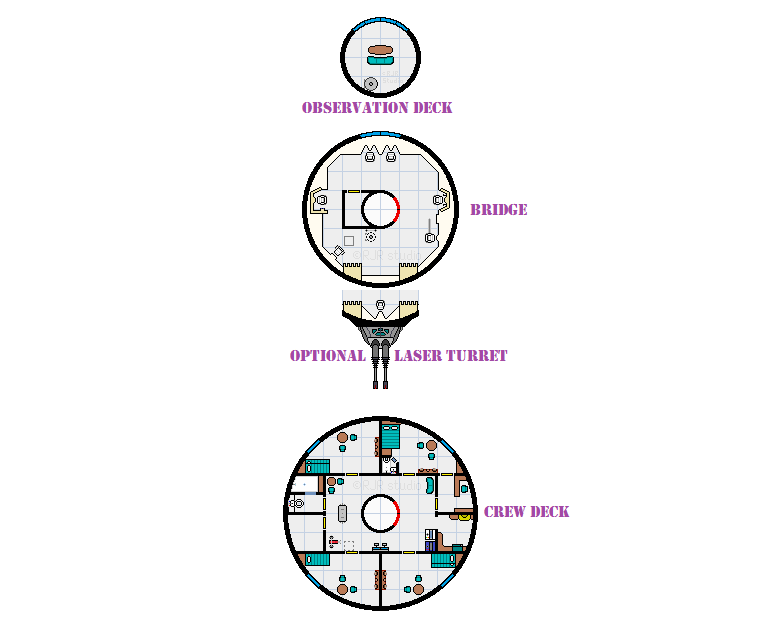

The Observation Dome is a small retreat deck featuring a sofa, coffee table, and a minimal bar with an entertainment center.
The Bridge level contains all the operational stations for the ship. The helm is centered at the dorsal position with captain/pilot and co-pilot positions, an engineer’s station is to port (right side of the map) and the astrogator station is adjacent to starboard (left on map). All three stations have a computer panel. A Computer Operator station is to starboard/ventral and a comms & sensor position is situated at port/ventral. The mainframe computer is nestled under the deck on the ventral side, accessible via the floor panel that leads to a maintenance shaft running all the way down to another panel in the ceiling of the Crew Deck.
The Crew Deck is a larger area with four cabins and a common area with galley and entertainment. The double occupancy Captain’s Suite complete with fresher is at dorsal/port, although it is typically single occupancy barring any “special” crew relations the captain may have. Adjacent to the suite is the Captain’s office. Three more convertible cabins encircle the circumference, each featuring one or two bunks depending upon crew size. A common fresher is centered at starboard, adjacent to a storage area. The galley is adjacent to the Captain’s office, and the rec/lounge area takes up the center.
The Maintenance Deck is the lowest deck on the ship and features monitoring equipment for the drives at dorsal/starboard, accessways to the engines themselves, life support equipment to starboard, a recharging station for robots & power packs adjacent to the elevator, a tool & machine shop to port (the tool rack has the equivalent of a TechKit, RobComKit, and Engineer’s Toolbox). A generator & power relay station are positioned to ventral/port. Floor panels can be removed to access equipment descending further into the hull. Airlocks and decontamination stations are situated in each “wing” along with a ventral outer hull airlock in the port side.
Up to three one-unit capacity Cargo Pods can be affixed to the stern, each clamps on to the prior pod with the first pod clamped to the aft of the freighter hull. Exterior elevator extensions allow for access to each pod and feature an airlock when accessing the interior from the elevator. Unlike Standardized Containers, pods are not as common; with the exception being for system ships pods get recycled at each end of a local route since they remain in-system at all times. Otherwise, a TT-300 starship will tend to service neighboring systems to a “home port” and in some cases, run a continuous “circuit route” such as Prenglar and the three Yazirian systems (not including Scree Fron). As such, detached pods will be encountered by rolling doubles on 2d10.
While the TT-300LF design suggests it is streamlined, it does not make planetary landings as it lacks any landing gear or the ability to mount a landing module. Even if such equipment were made available, it would not be capable of atmospheric use with cargo pods attached.



HS:5 Freighter (REDUX)
TT-500F Lighter class freighter

HS: 5 HP: 25 Powerplant: 2 Atomic class-B
ADF: 3 MR: 3 DCR: 35 Crew: up to 8
Armament: N/A (LB @ -1 ADF or MR and –1 Cargo)
Defenses: RH
Communication/Detection: SubSpace Radio, VideoCom, Radar, Intercom Network
Misc Equipment: Camera System, Skin Sensors
Computer (Lv-4, 122fp, 100SP)
Alarm (2), Analysis (4), Astrogation (4), Commerce (1), Computer Lockout (4), Damage Control (2), Drive (5), Industry (1), Life Support (1, capacity:8), Maintenance (2)
Cargo Capacity: 5
Crew Accommodations: Captain’s Suite (double occupancy)
2 convertible single/double/triple bunk cabins
Passenger Accommodations: n/a
Ship's Vehicles: Lifeboat or Launch
Scale: 1 square = 2 meters

The Observation Dome is a small retreat deck featuring a sofa, coffee table, and a minimal bar with an entertainment center. An optional Laser Battery system can be installed on this deck in lieu of the luxury items. This penalizes performance by a factor of one to either the ADF or MR (owner’s choice) as well as a cargo reduction of one unit. A four function point program must also be uploaded to the mainframe computer.
The Bridge level contains all the operational stations for the ship. The helm is to port (right side of the map) with captain/pilot and co-pilot positions, an engineer’s station is to starboard (left side of the map) and the astrogator station is adjacent to far starboard. All three stations have a computer panel. The mainframe computer is nestled under the deck on the ventral side, accessible via the floor panel that leads to a maintenance shaft running all the way down to another panel in the ceiling of the Crew Deck.
The Crew Deck is a larger area with three cabins and a common area with galley and entertainment. The double occupancy Captain’s Suite Is to port, although it is typically single occupancy barring any “special” crew relations the captain may have. A pair of convertible cabins is to starboard, each featuring one to three stacked bunks depending upon crew size. A docking collar outside the airlock can accommodate a lifeboat or launch.
The Maintenance Deck is the lowest deck on the ship and features monitoring equipment for the drives at dorsal/starboard, accessways to the engines themselves, life support equipment to starboard, a recharging station for robots & power packs adjacent to the elevator, a tool & machine shop to port, and a generator & power relay station at ventral/port. Floor panels can be removed to access equipment descending further into the hull. A single workpod is nestled between the drives.
A sturdy rail system extends aft of the spacecraft to which standardized cargo containers can be affixed. One to five cargo unit capacity containers can be affixed to this rail system, totaling the cargo capacity of the ship itself (five if standard, four if a laser battery was added). Containers can be quickly offloaded and replaced on dedicated routes, although when operating independently there is no guarantee that loaded containers will be awaiting tramp freighters...as such an independently owned TT-500F will tend to keep the largest container mounted.


Light Transport
Starling class Light Transport

HS:4 HP:24 Powerplant: 2 Ion A + 2 chemical A
ADF:1 MR:4 DCR:40
Armament: LB
Defenses: RH
Comm/Detect: subspace radio, radar, intercom
Misc Equipment: streamlined, light hull armor
COMPUTER ( LVL:4 fp:108 mass/SP:100 )
Alarm: 4
Analysis: 4
Astrogation: 4
Bureaucracy: 2
Commerce: 1
Damage Control: 4
Drive (Chemical A): 1
Drive (Ion A): 3
Industry: 1
Information Storage: 1
Laser Battery: 1
Life Support: 1 (cap:22)
Maintenance: 4
Transportation: 1
Cargo Capacity:
Crew Accomodations: Captain's Suite + 4 dbl cabins
Passenger Accomodations: 1 First Class Cabin, 4 Journey Class Cabins
Ships Vehicles: none
Price: 900,050Cr (Class:I SCC)/1,140,050 (Class:II SCC)
The Starling class light transport is a vintage design dating back a century before the formation of the UPF. Streele, Incorporated (before they dropped the silent “e” and became a mega-corp) originally designed and constructed this ship in pf-100 with the first one serving as a privateer to disrupt the Mining Guild established by Pan-Galactic at the time.
The Ion Drives are supplemented by a pair of over-sized Chemical Thrusters along with detachable external fuel tanks. This arrangement permits planetary landings and take-offs as per a system ship of the same size, whereas ion drives alone would not be possible for such tasks. The external tanks hold 20 loads of fuel (5,000Cr to fill), plus a load in the drives themselves. This allows 21 planetary take-offs and landings, or 1 take-off and 20 turns worth of acceleration that adds +1 ADF to the existing Ion Drives for a total of ADF:2, or 10 turns worth of +2 ADF for a total of ADF:3. Note that after exhausting this fuel supply, the Ion Drives can still decelerate for an atmospheric landing with the reserve Chem Drive fuel supply for re-entry.
The external cargo pods each hold 1.5 units of cargo for a total of 3 units. There is no direct ship-to-hold access, once loaded the crew won't see the inside of the hold until reaching the destination. The cargo pods can be ejected to increase the Ion Drive performance by +1 ADF, and this boost is cumulative with the temporary Chem Thruster boost allowing a maximum ADF of four. The pods cost 75,000 credits each to replace and will require 45 days each for construction...there was a time when these pods were more common and readily available but those days are long gone. While the external fuel tanks can be detached as well, there is no performance gain, this is merely a safety feature should the tanks get ruptured in combat. Replacing the tanks costs 20,000 credits and requires 30 days of construction time (cost and time is for both tanks).
The ship is a paramilitary design boasting light hull armor and increased weaponry and defenses; however, it only comes standard with a laser battery. A single charge Masking Screen and a pair of forward firing Laser Pods (for two 1d10 shots or one 2d10 shot per turn) can be added with no performance penalty.
Because this is a vintage design, there can be used samples to be had that are over 100 years old. While the current design has been updated a few times since inception, some of these older ships may still be utilizing vintage hardware and/or software...feel free to offer sub-standard components for such craft, such as a laser battery with a shorter range, an oversized mainframe computer that takes up more space than a modern design, or life support equipment that by original design only lasts half as long.


EDITOR'S NOTE --- Back in merry old 1982 when Star Frontiers debuted, one of the first things my group lamented was the lacking rules for ships...so I drafted some house rules by "reverse engineering" the deck plans found in Traveller Supplement 7 Traders & Gunboats. It was all I had access to back then, and we had a working set of guidelines afterwards. My first ship was the Aqulian Starling, which can be seen remastered here:
SS
Pacific class freighter
submitted by Shadow Shack
edited from previously published official material as seen in SF/KH:1 "Dramune Run"
(credit to Troy Terrel for coining the name "Pacific" as a class of freighter based on the Gullwind design)
Trans Travel TT6150 "Pacific" Class Freighter
 image courtesy of Art @ SF.org forums --- edited by Shadow Shack
image courtesy of Art @ SF.org forums --- edited by Shadow Shack
HS:6 HP:30 PowerPlant: 3 Atomic B
ADF:3 MR:3 DCR:38 Crew:up to 8
Armament: none (LB available at no penalty)
Defenses: none (RH available)
Communications/Detection: SubSpace Radio, Radar, Intercom (3 master panels, speaker/mike in each station/cabin/chamber)
Misc Equipment: Cargo Arm, Universal AirDock
Computer
(LVL:4 fp:127 SP:100)
Alarm (3)
Analysis (4)
Astrogation (4)
Commerce (1)
Communication (1)
Damage Control (3)
Drive - Atomic B (5)
Industry (1)
Information Storage (1)
Life Support cap:16 (1)
Maintenance (3)
Cargo Capacity:6
Crew Accomodations: Captain's Suite (double occupancy possible), Crew Cabin w/2 triple bunks
Passenger Accomodations: 1 First Class Cabin, 2 Journey Class Cabins (all double occupancy)
Ship's Vehicles: lifeboat, 2 workpods
Base Price: 2,249,400Cr --- does not include fuel, spacesuits, weapons/defenses, or toolkits
Trans Travel's TT6150 is a popular choice for independant haulers, designed in the early f.y. 40s the ship has been around for a while. As such it has been tried, tested, and found to be true. The overall design makes it optimum for a wide variety of roles beyond cargo hauling, a crew can make additional income via the trio of passenger cabins as well as offering courier duties to local governments. The deck arrangement is simple and straight forward, separating various duties efficiently enough. Many owners are quick to modify the basic design both during the construction phase or after acquisition. In fy:61, one such famous example dubbed the SS Gullwind made what has been historically referred to as "the Dramune Run", running an illegal cargo from Clarion to Inner Reach thus exposing a criminal organization which kicked off the third Dramune War. Rumor has it an earlier model was used by the Star Devils in taking the Serena Dawn as well.
These fine craft, with a rich history of service in the independant field, are the envy of many freight haulers. Small, fast, and agile, they make up for smaller payloads by proving rapid delivery. With the advent of Pan Galactic's "Eureka" drive, added acceleration has made it moreso for such equipped Pacifics (adding 100,000Cr per drive and an ADF:4). The optional laser battery, perhaps not the most offensively minded possibility, ensures that such loads can be protected to say the very least.
Used samples can be had for 15 to 50% of new price, depending on condition & upkeep.
DECK PLANS FOLLOW
image edited from published material, copyright TSR
1a> Flying Bridge
1> Bridge
1b> Forward Maneuver Jets
2> Crew Deck
3> Passenger Deck
4> Maintenance Deck
5> Cargo Hold
5a> Elevator Access Points to hold
5b> Cargo Arm
6> Aft Maneuver & Engine Room
Pacific DECK:0 --- Flying Bridge
1> small hydroponic bins
2> Communications & Sensor equipment
3> Avionics
4> Flying Bridge, positions for Pilot, copilot or computer operator, and Engineer
9> Elevator to main bridge
Pacific DECK:1 --- Bridge level
image edited from original published material, copyright TSR
1> Main Elevator
2> Helm, positions for pilot and copilot
3> Chief Engineer station
4> Astrogator station
5> Computer Operator/Asst. Astrogator position
6> Computer Room, 6a is a maintenance shaft. Small arms storage nearby
7> optional radar operator station
8> optional communications officer station
9> Elevator to Flying Bridge
10> Optional Laser Battery, where applicable
Pacific DECK:1b -- Forward Maneuver Jets
1> Elevator
2> Maneuver Jet Banks
3> Water Tank
4> Water Purification/Sewage Management
Pacific DECK:2 --- Crew Deck
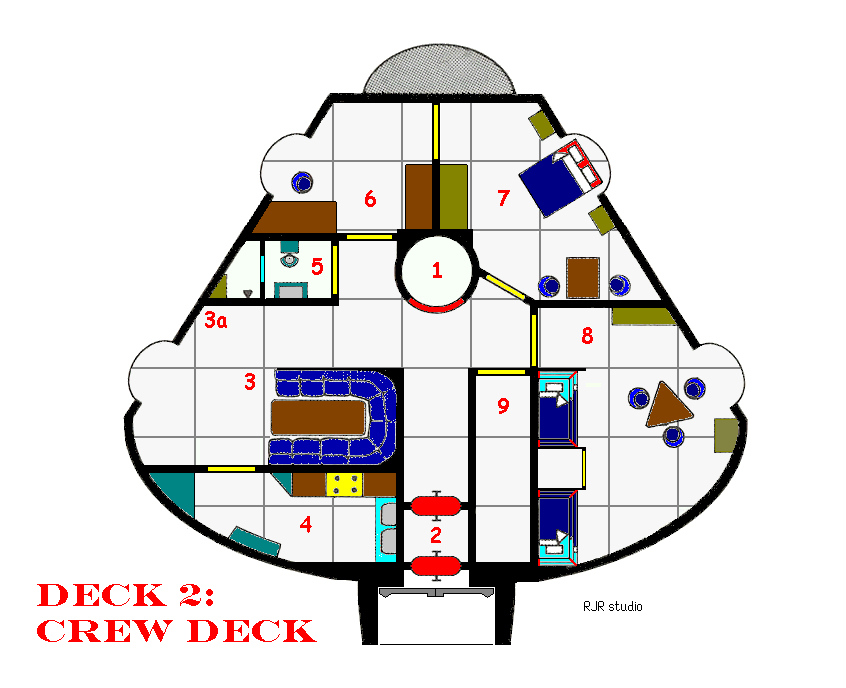 image edited from original published material, copyright TSR1> Elevator
image edited from original published material, copyright TSR1> Elevator
2> Airlock/Outer Hull Hatch (Universal AirDock)
3> Common Area, 3a is the holo-entertainment console
4> Galley
5> Fresher/sanitation
6> Captain's Office
7> Captain's Suite
8> Crew Cabin
9> Storage Area
Pacific DECK:3 --- Passenger Deck
image edited from original published material, copyright TSR
1> Elevator
2> Journey Class Cabin
3> First Class Cabin
4> Common Area
5> Fresher/sanitation
6> Lifeboat/airlock
L1> Lifeboat Helm
L2> Passenger Area
L3> Emergency Equipment Storage/LS equipment
L4> Fresher/sanitation
Pacific DECK:4 --- Maintenance Deck
image edited from original published material, copyright TSR 1> Elevator
2> Engineer's Station (half of overhaul time spent here)
3> Freight Handler Station
4> Workshop - 4a is a laser/lathe. 4b is a laser drill press, 4c is a workbench w/tool storage, 4d is a foundry
5> Life Support unit
6> Misc Storage
7> Parts Storage
8> Workpod Airlock pens
9> optional back up LS unit (not standard equipment)
10> Power Relay Station
11> Generator
Pacific DECK:5 --- Cargo Hold
1> Elevator
2> Airlock
3> Cargo Arm tracks
4> Hold
5> Bay Doors
Pacific DECK:6 --- Engine Room
1> Elevator
2> Monitor Panels, 2a is a cieling accessway to the aft maneuver jet banks above
3> Airlock/Decontamination Chambers, access to engines
half of overhaul time spent within engine room and drive accessways
PGC-291M Cargo Courier

HS:3 HP:15 Powerplant:2 atomic A
ADF:4 MR:4 DCR:35
Armament:LB
Defenses:RH
Communication/Detection: Radar, Subspace Radio, Intercom System
Misc Equipment: Streamlined
Computer "DAME" (Dynamic Access Memory Emulator)
Level:4 FP:83 SP:100
Alarm(2)
Analysis(4)
Astrogation(4)
Commerce(1)
Communication(1)
Damage Control(2)
Drive:atomic"A"(4)
Industry(1)
Laser Battery(1)
Life Support(1)
Maintenance(2)
Cargo Capacity:1 (stern bay)
Crew Accomodations:up to 5 (2 double bunk cabins + one single bunk)
Passenger Accomodations: 0
Ship's Vehicles:none
Base Price: 913,730Cr (does not include fuel, sapce suits, or toolkits etc)
The PGC-291M is one of Pan Galactic's earliest atomic driven production vessels, dating back to before they elevated themselves into mega-corp status. The ship utilizes a slightly diminished size:3 hull that hails from their pre-UPF "Pan Galactic Conglomerates" era Courier system ship. While the design is dated by modern standards, the PGC-291M is still a versatile civilian light hauler capable of moving small loads quickly and efficiently.
The ship is designed for a four position crew: a pilot, astrogator, engineer, and a gunner; although the fifth bunk in the engineering area allows an additional crew member if needed. PGC no longer manufactures these ships although like all of their products, they continue to offer replacement parts (which can be had at any class 1 or 2 SCC). If someone really wanted a new one, it would not be difficult for an SCC build crew to reverse engineer the design.
The uppermost deck is the bridge with positions for a pilot on the dorsal side flanked by an astrogator and engineer station. Ladders on either side of the helm allow access to a flying bridge that is positioned parallel to the ship's main axis for atmospheric operation. The upper hatch leads to the avionics, forward maneuver jet banks, and sensor array in the nose cone above.
Below the bridge is the crew quarters with a double bunk cabin both port and starboard. The cabins are equipped with a water closet, small sofa & table, and wardrobe areas in addition to the bunks themselves. A galley is positioned between the cabins on the ventral side and the laser battery controls are on the dorsal side.
Further aft is the largest deck, the engineering deck. It is equipped with a diagnostic center on the dorsal side where 50% of overhaul work is performed. Port & starboard are the drive access & decontamination airlocks to access the atomic drives where the other 50% of overhaul work is performed. The landing gear bays are adjacent to the decon-airlocks. Also present are the water tank w/purification plant, life support equipment, power relay station & generator (w/powerpack/para-battery recharging station), the main frame computer adjacent to the floor/ceiling hatch, and a tool shop flanking the diagnostic center featuring a bench, tool storage area, laser-lathe,and laser drill press to port and a foundry is starboard. A single bunk is nestled in the ventral side that can double as a medical bunk, and a crew lounge is present adjacent to the bunk featuring a Starplay Enterpsies ceiling-retractable table w/stools and entertainment package that offers numerous interactive hologames. Floor and ceiling access plates permit access to additional equipment and systems such as the aft maneuver jet banks and various circuitry. To port is an airlock with a boarding ramp.
The stern hold is a tiered deck with loading bay doors located both aft for space station use and dorsal for crane loading/unloading at a planet's star port. The bay slants outward as it extends up/fore and each tiered sub-deck is larger than the lower, with a total of three tiers.
Pirate Assault Scout
submitted by Shadow ShackModified from the Assault Scout deck plans found at Dundjinni forums ---
Black Diamond class piate assault scout
HS:3 HP:15 Powerplant: 2 atomic A
ADF:5 MR:4 DCR:40 Crew: up to 24 (8 officers, 16 troops)
Weapons: Pod Laser, Laser Battery
Defenses: RH
Communication/Detection: Subspace Radio, Radar, Intercom
Misc: streamlined hull
COMPUTER
Alarm (2)
Analysis (4)
Astrogation (4)
Communication (1)
Computer Lockout (3)
Damage Control (2)
Drive, atomic A (4)
Industry (1)
Information Storage (1)
Installation Security (3)
Laser Battery (1)
Laser Cannon (pod laser) (1)
Life Support, cap:24 (1)
Maintenance (2)
Cargo Capacity: 0.5
Crew Accomodations: 4 single/double occupancy cabins
Passenger Accomodations: 16 person barracks (troops)
Ship's Vehicles: none
1> Central lift shaft w/access to outer hull hatch
2> Storage Deck, 2a is the cargo hatch
3> troop barracks
4> Engineering
5> port and starboard drive monitor stations
6> ladderwell to generator & power relay station access
7> engineering stations, w/deck access to life support, hydroponics, and water purification systems
8> Crew Deck
9> laser battery controls
10-13> crew cabins, single or double occupancy permitted
14> Recreation Deck, a) rec equipment, b) lounge area, c) holo-entertainment system, d) weight bench
15> fresher w/shower at a
16> galley, a) dining area, b) pantry, c) auto cooker, d) freezer/refrigerator
17> Secondary lift shaft, limited access to officers
18> Main Bridge, a-b) helm with stations for pilot and co-pilot/rocket gunner, c) chief engineer station, d) astrogator sation, e) computer/communications/detection station with maintenance shaft to mainframe below
19> Flying Bridge, a) helm, b) comm/radar station, c) computer station, d) remote gunnery station
RCS Dark Shadow
recommissioned freighter
(depicted with CT-250 container)

SCT-401 Container Ship
HS: 4 HP: 20 Powerplant: 2 retrofitted PGC Eureka Atomic B
| Cargo | 0 | 1.25 | 2.5 | 3.75 | 5 |
| ADF | 5 | 4 | 4 | 3 | 3 |
| MR | 4 | 4 | 3 | 3 | 2 |
DCR: 32 Crew: up to 8
Armament: concealed laser battery*
Defenses: RH, MS(x1)
Communication/Detection: SubSpace Radio, VideoCom, Intercom, Radar, Energy Sensor, Skin Sensors
Misc. Equipment: modular cargo container rail, camera system
Computer
Alarm (2)
Analysis (4)
Astrogation (4)
Bureaucracy (2)
Commerce (1)
Communication (1)
Computer Lockout (3)
Computer Security (3)
Damage Control (2)
Drive, atomic B (5)
Industry (1)
Installation Security (3)
Laser Battery (1)
Life Support, cap:8 (1)
Maintenance (2)
Robot Management (2)
Cargo Capacity: varies, see Cargo Containers below
Crew Accomodations: 4 dbl cabins
Passenger Accomodations: none
Ship's Vehicles: workpod, large launch
The Dark Shadow is a freighter that the Royal Marines impounded after discovering contraband within its cargo hold. Once the crew had been sentenced, the ship ended up being claimed by the ruling government.
The Shadow is a Streel Corporation Transport Model:401, cloned from the Trans Travel 456 modular freight hauler. Peaking at 13 meters at its widest point (not counting engine struts and drives, which give it a total width of 23 meters) but a mere 18 meters in length (not counting the cargo rail, which adds another 52 meters), the basic hull itself rates at a size-4 designation. However, hauling capacity via detachable containers mandates the use of size:B drives. Naturally with lighter loads performance is quite beneficial, and even when fully loaded the ship is no pushover.
To this end, Leotus swapped out the stock Streel thrusters with Pan Galactic "Eureka" drives in order to upgun the ship a little without sacraficing performance. The Shadow's original concealable nose battery was retained, and a masking screen launcher was added. Software upgrades were incorporated as well, beyond that the ship is little different than the one they "inheritred".
Much like the TT-456 it was cloned from, the Streel cargo containers (see below) are a fast and easy matter of loading or unloading. Universal rail clamps are fitted to the containers and readily available at any station utilizing the containers, and are efficiently affixed to the ship's cargo rail. Even the elevator sections are easily spliced in with each and every configuration for inter-crew access. It takes about 30 minutes to load a container onto the rail, and no more than ten to remove one. This means pre-loaded containers merely await for an inbound modular freighter, rather than taking the time to load and unload the craft prior to loading the new cargo. This of course significantly reduces layover time, permitting the ship to re-enter the spacelanes more efficiently.
* It should be noted that the location of the battery prevents it from utilizing the standard 360º field of fire. Being mounted in the nose, and due to the flexible nature to conceal its barrels, it can fire across the sloped hull at a 270º field of fire (with safety mechanisms to prevent striking the drives), so it can fire at any target that is not in the rear flank.
DECK PLANS

SCT Cargo Containers
| Container type | CT-125 | CT-250 | CT-500 |
| Cargo Capacity | 1.25 units | 2.5 units | 5 units |
| Hull Points | 3 | 6 | 12 |
| DCR | 10 | 20 | 30 |
Crew: up to two (only with high risk cargo, must utilize host ship quarters)
Armament: n/a
Defenses: optional RH
Misc: Subspace Transmitter Beacon, Intercom (links to host ship)
Computer
Bureaucracy (1)
Commerce (1)
Communication (1)
Computer Lockout (2)
Damage Control (1)
Installation Security (2)
Maintenance (1)
Also cloned from the Trans Travel CC-125/250/500 containers, these Streel counterparts are interchangeable with the TT units so either ship can utilize either container. Streel simply doesn't dump as much currency into their version...meaning it's cheaper.
When a hull hit is determined during combat, there is a chance that damage will be applied to a container rather than the ship itself. As such, should the container be destroyed adjacent containers or the ship itself is subject to taking half of the damage that the container itself incurs. See table below for damage application:
| Container Type | CT-125 | CT-250 | CT-500 |
| Damage Probability | 15% | 30% | 50% |
The ship may, at the crew's discretion, jettison a container to improve performance. Of course, any crew assigned to the container may have something to say about this act, and any computer experts in said crews can become involved in a virtual cyber battle with the host ship crew in over-riding the other system to prevent such acts. As mentioned, it takes but ten minutes (one combat turn) to jettison a container, and the containers can only be jettisoned in reverse order in which they are loaded. In other words, if a CT-250 is loaded first and a pair of CT-125 containers are placed aft, the stern-most 125 must be jettisioned first, followed by the next 125, and finally the 250 can be dropped (thus taking a minimum of three combat turns to drop all three).
All non drive, maneuver, weapon, and defense hits are applicable to containers in a similar manner. Container module DCR may be applied toward ship repairs and vice versa, hence the container's DCR may be added to the host ship's DCR.

RT-3100 Merchant Scout
submitted by Shadow Shack
HS: 3 HP: 15 Powerplant: 2 Atomic A
ADF: 4 MR: 4 DCR: 30 Crew: 4-8
Armament: LB
Defenses: RH
Communication/Detection: SubSpace Radio, VideoCom, Radar, Intercom
Misc Equipment: Streamlined, Universal AirDock
COMPUTER (Level:4 FP:89 Mass/SP:100)
(Control panels in each bridge station, flying bridge, and engineering)
ALARM (2)
ANALYSIS (4)
ASTROGATION (4)
COMMERCE (1)
COMMUNICATION (1)
DAMAGE CONTROL (2)
DRIVE (Atomic) (4)
INDUSTRY (1)
INFORMATION STORAGE (1)
LIFE SUPPORT cap:8 (1)
LASER BATTERY (1)
MAINTENANCE (2)
Cargo Capacity: 2
Crew Accomodations: 4 double cabins
Passenger Accomodations: n/a
Ship's Vehicles: none
Rayax Transport is a subsidiary of Pan Galactic and Trans Travel located on Hentz in the Araks system. Named after a small and swift carnivorous mammal native to the world, as the name implies they specialize in surface & aerial cargo & passenger transportation vehicles. The RT-3100 is their first foray into space going vessels, with a debut in fy-64 this entry level craft has become popular with adventurers and business owners alike. Their holds are too small for true freight hauling, but the smaller crews and higher performance capabilities make them desirable for small loads that need to be at their destinations much sooner than the big ships can manage. It should be noted that the 3100 quickly became popular with smugglers, the 'tween decks accessways can be easily modified with false panels for hiding contraband...not to mention the numerous other possibilities with the maintenance panels in Engineering and the forward mandibles. Several RT-3100 models have had artificail secondary life support units made to hide contraband up near the mandibles. Alas these areas only permit minimal amonts of "small package trade" measured in kilograms rather than cargo units.
Essentially reverse engineered from a decommissioned/surplus assault scout, the merchant scout retains a fair amount of the original design. However, due to design constraints the weaponry and performance packages are limited to civilian grades. Still, the single laser battery is added without any adverse effects to performance. The ship is unique in that the underbelly cargo section which runs most of the length of the craft, thus expanding carrying capacity. Lower mass is made up by shortening the overall length, the ship is often referred to as a "snub scout".
The forward mandibles contain ladders rising up through access plates to the communications and sensor equipment, as well as water tankage and a purification plant. Space is allocated for an optional back up life support unit as well. Conduit ducts are located to port and starboard.
Aft of that is the flying bridge with a 90º tilted control booth for the pilot, copilot, computer operator, and engineer to assume a "fighter jockey" stance for atmospheric landings or the simple different style of space flight. The avionics are also accessible on this deck, along with the ventral hydroponics area.
Behind that is the main bridge featuring a pilot & copilot/ rocket gunner helm, astrogation and engineer stations, and a computer station with a floor access panel to the mainframe. The main hold terminates to this point "below".
The next deck down is the recreation deck, sporting a galley with autocooker, refrigeration/freezer unit, pantry, and sanitary station. A lounge and recreation area is adjacent, and a fresher with shower facilities rounds out the deck. Ceiling panels allow access to the computer maintenacne shaft and emergency bridge ladderwell.
Sternward from there is the crew deck with four cabins that can be tailored to single or double occupancy as desired. Controls to the laser battery are in the foyer along with a lounge area.
Aft from the crew deck is the engineering deck with full analysis equipment for the drives and maintenance aspects, along with a tool shop and access to the main life support unit and generator/power relay station. Port & starboard maintenance hatches lead to the RCS thrusters.
Finally, the bottom-most deck is the aft storage area with airlock to the Universal Docking Collar and hatches to the main hold. The dorsal area is for space suit storage with the ventral areas typically used as weapon lockers. The remaining trio of rooms can be utilized as the crew sees fit: a medical bay, equipment storage, robot closets, labs, and/or additional cabins for more crew or passengers.
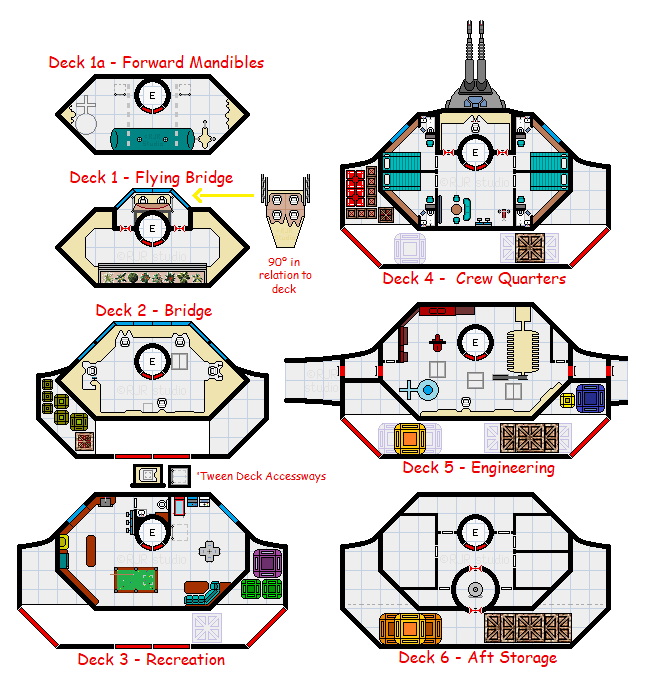
SC-181 Courier
TSC Magdalina
SC-181 Courier
HS: 2 HP: 12 Powerplant: 2 Atomic A
ADF: 4 MR: 3 DCR: 30 Crew: up to 4
Armament: Pod Laser, Pod Laser Turret
Defenses: RH
Communication/Detection: SubSpace Radio, Radar, Intercom
Misc. Equipment: streamlined, light hull armor
Cargo Capacity: Port & Starboard 0.5u holds (1u total)
Crew Accomodations: 2 dbl bunks
Passenger Accomodations: n/a
Ship's Vehicles: 0
Computer
Alarm (2)
Analysis (4)
Astrogation (4)
Commerce (1)
Communication (1)
Damage Control (2)
Drive (4)
Industry (1)
Information Storage (1)
Laser Battery (1)
Laser Cannon (1)
Life Support, cap:4 (1) x2
Maintenance (2)
The SS Magdalina is a decommissioned courier vessel acquired by her current owner via government auction. She is a relic dating back a century before the UPF and has been retrofitted numerous times. Ironically she was absorbed by the same government that initially commissioned the ship as the result of chartered debt, utilized for government business, and subsequently retired & decommissioned. She now operates as a privateer under the Palean government. The ship has an aerodynamic/streamlined hull and is atmospheric capable. If the forward firing pod laser system were removed, performance could be restored back to the stock ADF:4/MR:4 ratings...however the current crew justifies the slight loss of maneuverability as a good trade off for more firepower, more so in light of the fact that cargo capacity could not be increased by ditching the weapon system.
The upper/fore deck is the Bridge Deck. The helm, poised 90º above the astrogation/mainframe computer center and accesible via a ladder extending above the dorsal side of the hatch, has three command chairs but can typically be operated alone via the center seat.
The Rec Deck is outfitted with an autocooker/refrigeration unit, dining area, hygiene facilities, holo-entertainment, gunnery station, and outer hull hatch & airlock. Port and starboard hold bay doors flank the ventral side, the holds extend fore & aft (up and down) and the bay doors are the only access. The central ladderwell extends up and down the entire ship, with manual hatches closing off/securing each deck.
The Crew Deck has four folding bunks along with personal effects storage areas and a lengthy desk/table area.
The Engineering Deck houses access to the twin atomic drives along with a workshop area, life support equipment, recharging equipment for powerpacks & parabatteries, and an engineer station to monitor maintenance & overhauls. Floor panels can b removed to access additional equipment that wouldn't fit on the deck such as the power relay station and internal power generator. A decontamination station is in the central ladderwell/airlock access to the deck.
Scout Ship
(pf:100 era)
(artwork courtesy of Marvel Comics, courier ship from their Star Wars series)
HS: 3 HP: 18 Powerplant: 2 Chemical A, 4 Ion A
ADF: 2 MR: 3 DCR: 30 Crew: 4-8
Armament: LT
Defenses: RH
Communication/Detection: SubSpace Radio, Radar, Intercom
Misc Equipment: Streamlined, light armor
Fuel: 72u S-Ox , 4000u L-Hyd
Max Speed: 18, unlimited
COMPUTER --- 2 linked mainframes
Mainframe #1 (LVL:6 fp:271 Mass/SP:1000/600)
Alarm* (6) 64
Analysis* (4) 16
Astrogation* (4) 32
Bureaucracy* (3) 12
Computer Security* (4) 24
Damage Control* (6) 96
Drive: Chemical A (1) 4
Drive: Ion A* (3) 16
Laser Battery (1) 5
Life Support, cap:8 (1) 2
Mainframe #2 (LVL:6 fp:195 Mass/SP:1000/600)
Bureaucracy* (3) 12
Commerce (1) 4
Communication (1) 4
Computer Security* (4) 24
Computer Lockout* (4) 16
Industry (1) 4
Information Storage (1) 3
Installation Security* (4) 32
Maintenance* (6) 96
Cargo Capacity: 0.1
Crew Accomodations: 4 double cabins
Passenger Accomodations: n/a
Ship's Vehicles: none
DECK PLANS
Streel Corporate Vessels
Streel CF-5000 Corporate Frigate
Corporate Capital Ship

CLICK FOR LARGER VERSION
HS: 5 HP: 40 Powerplant: 4 Streel "Big Bang" Atomic B
ADF: 4 MR: 3 DCR: 50 Crew: up to 30
Armament: LB(x2), RB
Defenses: RH, MS(x1)
Communication/Detection: SubSpace Radio, VideoCom, Radar, Energy Sensor, WNB, Intercom
Misc. Equipment: heavy armor
Computer
Alarm (4)
Analysis (4)
Astrogation (4)
Communication (1)
Computer Lockout (5)
Damage Control (4)
Drive (5)
Industry (1)
Installation Security (4)
Laser Battery (1) x2
Life Support, cap:32 (1)
Maintenance (4)
Rocket Battery (2)
Cargo Capacity: 2
Crew Accomodations: 12 dbl cabins
Passenger Accomodations: 2 Journey Class & 1 First Class Cabins
Ship's Vehicles: 2 workpods, SNUB (see below) docking facility, optional External Docking Facility (4 S-series fighters)
______________________________________________________________________________________
Streel Nominal Ultra Boat (SNUB) Scout
Corporate Scout ship

HS:3 HP:15-24 Powerplant: 2 Atomic "A"
ADF:4 MR:4 DCR:29 Crew:4-12
Armament:LB, optional swap for PL & PLT @ MR:-1
Defenses:RH
Comm/Detection: SSRadio, Radar, Intercom
Misc Equipment: Streamlined, Universal Air Dock, variable aft bay* , possible armor upgrades
COMPUTER
Alarm (2)
Analysis (4)
Astrogation (4)
Damage Control (2)
Drive (4)
Industry (1)
Laser Battery (1)
Laser Cannon (1)
Life Support cap:12 (1)
Maintenance (2)
Cargo Capacity: 1*
Crew Accomodations: 4 single, double, or triple cabins
Passenger Accomodations: 0
Ship's Vehicles: 0
Timeon Clipper
Timeon Clipper class freighter
Armed Freight Transport

HS:7 HP:56 Powerplant: 3 Streel "Big Bang" Atomic B
ADF:3 MR:2 DCR:50 Crew:8-15
Armament: LB
Defenses: RH, MS (x1)
Communication/Detection: Subspace Radio, Radar + aux. Radar in stern
Misc: heavy armor, 2 cargo arms (1/hold)
Computer
Alarm (3), Analysis (4), Astrogation (4), Commerce (1), Computer Lockout (6), Damage Control (3), Drive (5), Industry (1), Information Storage (1), Laser Battery (1), Life Support (1); capacity:15 Maintenance (3)
Cargo Capacity: 7 (3.5 x 2 holds)
Fuel Tankage: 18 uranium pellets, 6/drive
Crew Accomodations: 2 suites (single or double occupancy), 6 cabins cabins (single or double occupancy)
Passenger Accomodations: 0
Ship's Vehicles: Workpod, Large Launch
Streel Shipbuilding designs and constructs these lower end freight haulers. Using a class:7 hull as a starting point, these freighters aren't designed for massive profits like the larger haulers may reap, but rather their faster nature allows them to enjoy hauling cargoes that need to be there quicker than the big barges can travel. Also noteworthy is the extra heavy hull armor plating invoked, allowing the Timeon Clipper to absorb damage akin to craft nearly twice the size can take. Further additions include a single laser battery to help ward off any of that damage.
Obviously anything this high in mass requires a little extra boost to propel it to standard performance levels. To this end Streel's own "Big Bang" line of class:B atomic drives offer superior thrust over the PGC "Eureka's" offered on the Pacific class freighters (eg: the SS Gullwind) with only marginally higher costs, and adding a third drive to the equation also helps retain stock ship performance. The improved efficiency of the Big Bangs along with the increased cargo capacity over the standard smaller freighters sized from class:3 to 6 hulls will maximize profit potential for those independant haulers and greater expansion potential for mid-sized firms with fleets of several ships.
These craft are meant to slip in to the market where larger craft could never operate, such as limited markets where a larger ship would burn up all the profits in her reaction chambers. Aforementioned smaller worlds no longer have to pay premium prices for goods hauled to them. With twice the room of smaller atmospheric capable haulers they will be able to flood the markets with thier own goods and take over the runs they are used on, leaving only the "absolutely positively has to be there right away" market to the smaller craft.
Few owners opt to ditch the single laser battery in favor of improved performance (thereby allowing MR:3), most freight captains enjoy some form of self defense when the nay-sayers show up looking for some free swag to lift. Massive amounts of hull integrity can go a long way in preventing unwanted boarders, but a battery weapon goes even further by adding an offense to an established defense.
Original concept by Parriah, deck plans drafted by Shadow Shack
Deck 1 - Bridge
The bridge level includes a helm with pilot & copilot stations (center), computer operator (left of pilot station), astrogation control (far left), communications/detection officer (right of pilot station), engineer station (far right), Executive Officer/co-owner station (center left) and Captain/owner station (center right). A locker is centered between the command stations, intended for spacesuits and/or personal weaponry. Also on the deck are the Captain's suite and XO's suites (the latter of which may be occupied by a pilot in the absence of an XO), and a briefing room rounds it off along with an adjacent bay that accomodates a large launch.

Deck 2 - Forward Crew Deck
The forward crew deck has three cabins which can be furnished for single or double occupancy. Also on the deck is a galley and lounge area, as well as the controls for the ship's laser battery. Typically the gunner will reside in one of the cabins on this deck, along with any bridge personnel not residing on the Bridge deck.
Deck 3 and 5 - Fore & Aft Holds
These twin decks depict the standard hold, each capable of storing 3.5 cargo units. The central elevator shaft has been expanded outward to accomodate a cargo arm on each level. Bay doors open on four sides of the hexagonal shaped deck for expedient cargo loading and unloading.
Deck 4 - Mid Crew Deck
Sandwiched between the twin cargo holds is the mid crew deck, containing three more cabins that may be furnished for single or double occupancy. A galley and lounge flank the Universal Docking Collar. Timeon Clippers that are staffed by smaller crews will typically lease these cabins out for passengers or permit security guard residence for valuable loads.
Deck 6 - Engineering
This deck represents the business end of the craft, containing an engineering station (where 50% of overhaul time is spent), water tankage and a purification plant, life support equipment, a generator and power relay station, tool shop, spacesuit lockers, and a workpod bin.
Deck 7 - Engine Room
This deck contains readout stations for each of the Clipper's atomic drives, along with airlock/decon stations and accessways to the actual drives. The remaining 50% of overhaul time is spent on this deck, and many crews typically keep a few maintenance bots here as well.
TT-456 Container Ship
(modular freight hauler)

HS: 4 HP: 20 Powerplant: 2 Atomic B
| cargo | 0 | 1.25 | 2.5 | 3.75 | 5 |
| ADF | 5 | 4 | 4 | 3 | 3 |
| MR | 4 | 4 | 3 | 3 | 2 |
DCR: 32 Crew: up to 8
Armament: optional pod laser turret at no penalty
Defenses: optional RH
Communication/Detection: SubSpace Radio, VideoCom, Radar, Intercom
Misc. Equipment: modular cargo container rail
Computer Alarm (2)
Analysis (4)
Astrogation (4)
Bureaucracy (3)
Commerce (1)
Communication (1)
Computer Lockout (4)
Computer Security (4)
Damage Control (2)
Drive, atomic B (5)
Industry (1)
Installation Security (4)
Laser Battery (1)
Life Support, cap:8 (1)
Maintenance (2)
Cargo Capacity: varies, see Cargo Containers below
Crew Accomodations: 4 dbl cabins
Passenger Accomodations: none
Ship's Vehicles: workpod, small launch
Trans Travel released a hit with their 456 model freight hauler. Peaking at 14.5 meters at its widest point (minus engine struts and drives,which give it a total width of 42 meters) but a mere 18 meters in length (minus the cargo rail, which adds another 48 meters), the basic hull itself is too small for a class:5 designation. However, hauling capacity via detachable containers mandates the use of size:B drives. Naturally with lighter loads performance is quite beneficial, and even when fully loaded the ship is no pushover either.
When the ship docks at a station or takes up orbit, containers are a fast and easy matter of loading or unloading. Universal rail clamps are fitted to the containers and readily available at any station utilizing the containers, and are efficiently affixed to the ship's cargo rail, and even the elevator sections are easily spliced in with each and every configuration for inter-crew access. It takes about 30 minutes to load a container onto the rail, and no more than ten to remove one. This means pre-loaded containers merely await for an inbound TT-456, rather than taking the time to unload the craft prior to loading the new cargo. This of course significantly reduces layover time, permitting the ship to re-enter the spacelanes more efficiently.
Deck Profile
Deck Plans
(1 meter squares) 
Cargo Containers
| container type | CC-125 | CC-250 | CC-500 |
| Cargo Capacity | 1.25 units | 2.5 units | 5 units |
| Hull Points | 3 | 6 | 12 |
| DCR | 10 | 20 | 30 |
Crew: up to four
Armament: n/a
Defenses: optional RH
Misc: Subspace Transmitter, Intercom, Cargo Arm
Bureaucracy (1)
Cargo Arm (2)
Commerce (1)
Communication (1)
Computer Lockout (4)
Damage Control (1)
Installation Security (3)
Life Support, cap:4 (1)
Maintenance (1)
Crew Accomodations: 2 dbl cabins
Cargo Containers are available in three sizes (1.25, 2.5, and 5 unit capacity) and as such can be universally affixed in a variety of configurations, totalling no more than five units together for the TT-456. Trans Travel intends to expand this concept with larger vessels in the future sporting multiple cargo rails (allowing a total of ten, fifteen, or twenty total units carried), coupled with the ease of application and numerous participating stations across the Frontier, as such they have mass produced these containers. As such expect most stations to have a variety of these containers available for an outbound cargo.
When a hull hit is determined during combat, there is a chance that damage will be applied to a container rather than the ship itself. As such, should the container be destroyed adjacent containers or the ship itself is subject to taking half of the damage that the container itself incurs. The ship may, at the crew's discretion, jettison a container to improve performance. Of course, any crew assigned to the container may have something to say about this act, and any computer experts in said crews can become involved in a virtual cyber battle with the host ship crew in over-riding the other system to prevent such acts. All non drive, maneuver, weapon, and defense hits are applicable to containers in a similar manner. See table below for damage application:| container type | CC-125 | CC-250 | CC-500 |
| Damage probability | 15% | 30% | 50% |
Container module DCR may be applied toward ship repairs and vice versa, hence the container's DCR may be added to the host ship's DCR.
Cargo Container layout
various container configurations
 (original image provided by w00t, re: "KH TOC Freighter", rendered from the SF/KH arriors of White Light module. Original renditions modified and updated for use in this deck plan)
(original image provided by w00t, re: "KH TOC Freighter", rendered from the SF/KH arriors of White Light module. Original renditions modified and updated for use in this deck plan)
TT-6150P Pacific Class Para-Military/Privateer
HS: 6 HP: 36 Powerplant: 3 Pan Galactic "Eureka" Atomic B
ADF: 4 MR: 3 DCR: 50 Fuel: 18
Armament: 3 Laser Batteries
Defenses: RH, MS(x2)
Communication/Detection: SubSpace Radio, Videocom, Intercom network, Radar
Misc. Equipment: Light Hull Armor, Cargo Loading Arm
Computer Level:4 FP:141 Mass/SP:100
Alarm (3)
Analysis (4)
Astrogation (4)
Commerce (1)
Communication (1)
Damage Control (3)
Drive (5)
Industry (1)
Information Storage (1)
Laser Battery (1) x3
Life Support, cap:18 (1) x2
Maintenance (3)
Transportation (1)
Cargo Accomodation: 4.5 (+ potential for 0.5 secret hold)
Crew Accomodation: 3 cabins, up to 12
Passenger Accomodation: 6 (2 Journey Class Cabins, 1 First Class Cabin)
Ship's Vehicles: Lifeboat, 2 workpods
Base Price: 2,894,900Cr --- does not include fuel, soacesuits, or toolkits
The TT-6150P is the next evolutionary step of the original Pacific design. Restricted to construction under para-military contractors, the basic ship has been considerably upgraded for combat, featuring light hull armor and a trio of laser batteries. The cargo hold is reduced by 25% to accommodate the additional hull integrity and additional weaponry. Ideal for planetary militias and government sponsored privateering, the P model does the job well.
The captain's suite is lost, replaced by a pair of crew cabins. Typically the captain will opt for the 1st class cabin when it is not in use, otherwise he will bunk with the rank and file.
Smugglers were quick to identify a design quirk, namely a hollowed section between the Engineering deck and the hold. With a minimal amount of effort the "secret deck:5" can be enabled via bulkheads and hidden access doors or plates to creat a 0.5 unit hold, restoring total capacity closer to the base Pacific rating. This modification can be performed by any level:3+ Engineer at a cost of 50,000Cr and takes two tendays worth of dry dock time.
The ship is otherwise identical to the standard Pacific design.
TT-6150P Deck:0 Flying Bridge

TT-6150P Deck:1 Bridge

TT-6150P Deck:1a Forward Maneuver

TT-6150P Deck:2 Crew Deck

TT-6150P Deck:3 Passenger Deck
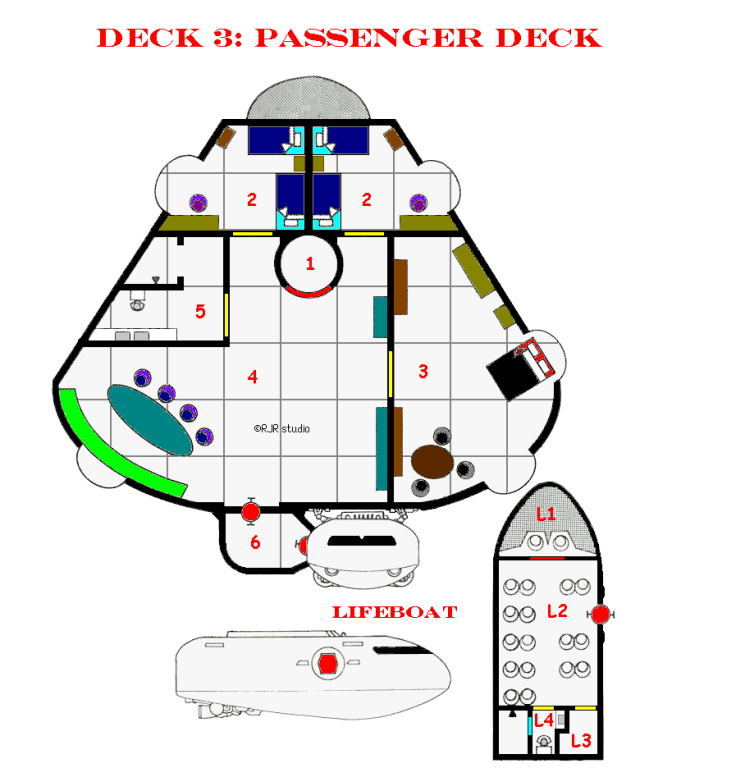
TT-6150P Deck:4 Engineering

TT-6150P Deck:5 (Optional) Secret Hold

TT-6150P Deck:6 Cargo Hold

TT-6150P Deck:7 Engine Room

UPF Assault Scout (remastered)
WarTech AS-3 markII Assault Scout
HS:3 HP:18 Powerplant: 2 Atomic A
ADF:5 MR:4 DCR:50
Armament: LB; AR(x4) or AR(x1)+PL
Defenses: RH
Comm/Detect: subscape radio, radar, intercom
Misc Equipment: streamlined, light hull armor
COMPUTER ( LVL: fp: mass/SP: )
Alarm: 2
Analysis: 4
Assault Rocket: 1
Astrogation: 4
Computer Lockout: 4
Damage Control: 2
Drive (atomic A): 4
Industry: 1
Information Storage: 1
Installation Security: 4
Laser Battery: 1
Laser Cannon: 1
Life Support: 1 (cap:8)
Maintenance: 2
Robot Management: 3
Transportation: 1
Cargo Capacity: 0.5 per cargo module/1.5 maximum
Crew Accomodations: 4 dbl cabins
Passenger Accomodations: n/a
Ships Vehicles: none
The mark2 AS-3 is a lightly modified design of the original assault scout. The convertible forward firing system was lifted from the F-40 Vulcan starfighter, the magazine can be converted to accomoate the standard issue of four rockets or it can be reduced to one with the addition of a pod laser system. Defensively, light hull armor was added with no restrictions to performance. While the UPF did not wish to sacrafice the scout's exceptional performance with heavier armor grades, at least one planetary militia has pre-ordered scouts with the beefier medium armor while taking an acceleration hit.
The most notable change is the addition of a stern mounted cargo module connection. Streamlined lengths of hull that match the shape of the assault scout's stern section can be affixed, each module measuring sixteen meters in length. Modules can be linked to each other in trains, their bay doors and airlocks lining up with each other and the host scout. Ventral bay doors permit access to cargo in modules that are sandwiched between other modules or their host scout.
Each module can accomodate one half unit of cargo, and unladen they restrict performance by a factor of one maneuver point per module, thus rendering the assault rocket system useless (one reason for the convertible PL system). Full modules restrict acceleration by a factor of one each as well. Filled or empty, no more than three containers may be affixed to an assault scout. Modules can be affixed or detached at a rate of one per ten minute combat turn, however previously assembled trains can be affixed (or detached) in one turn.
While being a streamlined extension of the scout hull itself, only one module can be affixed to an assault scout whose captain intends on practicing planetfall...additional modules have proven to be too extensive of a load to the host structure for atmospheric use.
In combat, any hull hits have a 20% chance (cumulative per module) of hitting a cargo module instead of the host scout. Cargo modules can abosorb 5 hull points of damage before being destroyed, damage above and beyond five is divided between any adjacent module and/or the host ship. Each module adds five to the host ship's DCR for effecting repairs.
DECK PLANS
1 meter scale
Deck 1 - Flying Bridge
Deck 2 - Main Bridge
Deck 3 - Recreation Deck
Deck 4 - Crew Deck
Deck 5 - Maintenance Deck
Deck 6 - Hold & Entry
_______________________
External Cargo Modules (up to three, tenatively decks 7-9 when utilized)
UPF Destroyer

HS:6 HP:50 Powerplant: 2 Atomic "B" drives
ADF:3 MR:3 DCR:75 Crew:40-50
Armament-Type CC: LC, T(x2), RB(x4), LB, EB
Armament-Type FE: LC, T(x2), LB(X2), EB(X2)
Defenses - Type CC:: RH, MS(x2), ICM (x6)
Defenses - Type FE:: RH, MS(x2), ICM (x4)
Communications/Detection: SubSpace Radio, Videocom, Radar, Energy Sensor, WNB, Intercom network, Skin Sensors
Cargo: 1.5
Passenger Accomodation: 8 single occupancy cabins, 5 suites (single or double occupancy), 18 double occupancy cabins, 2 triple occupancy cabins; 2 first class suites
Ships Vehicles: Lifeboat, 3 lg Launches, 2 workpods
The Destroyer design is an older one and as such its usefulness in Spacefleet has become questionable...Frigates are nearly as capable in combat yet faster at the same time. However, what a Destroyer lacks in speed it makes up for in armor, it can take a more severe beating than the Frigate. It is also the smallest Spacefleet vessel that features a cargo hold, useful for transporting smaller amounts of supplies as needed or reacquiring the "swag" from pirates.
Constructed with a Class 6 hull, the Destroyer measures 148 meters without cannon or drives, and 24 meters in diameter at the widest point without taking into consideration of any weapons or drives. Displacement comes in at 5400 tons. The UPF Destroyer is currently available in two configurations, the Type:CC (close combat) or the Type:FE (Fleet/Escort).
Destroyer Deck Arrangement

Fore Decks
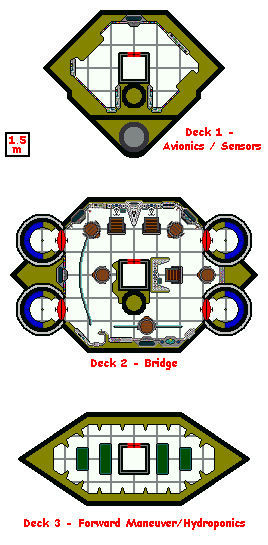
Deck 1 Key: Forward Sensors & Avionics --- This deck houses the access for various flight control systems and a diagnostic center, along with access to the communications and sensor arrays
Deck 2 Key: Bridge --- This deck is the operations command center, featuring a two station helm at the center for a pilot and a co-pilot/energy gunner to assist with the cannon, to the left of that an astrogation center (with movable command chair), to the right of the helm is the chief engineer's station. The Captain's station is behind the engineer, and the XO is stationed behind the captain. A computer operator with another movable command chair can oversee the communications and sensor equipment, and an eigth command chair is reserved for a rocket gunnerry expert to operate the torpedo launching system. A quartet of escape pods can be accessed from this deck. An access plate in the deck near the computer station permits access to the mainframe for maintenance and repair work.
Deck 3 Key: Forward Maneuver Drive --- The forward maneuver jets can be accessed here for service, along with the ship's hydroponics bins

Deck 4: Officer Quarters --- Three single occupancy cabins are on this deck, typically occupied by a pilot, co-pilot/energy gunner, and chief engineer. A lounge area is adjacent to the lift shaft and the dorsal section contains a full service galley with a sink, auto cooker, refrigerator, and pantry. Viewports in each room permit visual access to the exterior.
Deck 5: Forward Gunnery Deck & Officer Quarters --- Two single occupancy cabins lacking viewports (the masking screen launchers occupy the external positions where a viewport would normally be) are typically occupied by the XO and a rocket gunnery expert. The ventral area is the captain's suite, the dorsal area contains a galley, lounge area, and fire control for the rocket battery. Masking screen launchers flank the port & starboard sides.
Deck 6: Officer Quarters --- Similar to Deck 4 with different decor, these single cabins are typically occupied by the astrogator, a computer operator (who may also possess astrogation skills), and an officer proficient in rocket gunnery.

Deck 5 Alternate Floor Plan (Type: FE) --- The type FE destroyer replaces the space hoarding rocket battery with a pair of laser batteries, and the former laser battery on the main gunnery deck is upgraded to an electron gun. This cuts down on the officer cabins on this deck, reserving passage for the captain and XO while the gunners reside in one of the officer cabins on deck 9.
Mid-Decks

Deck 7 Key: Vehicle Bays - The dorsal bay houses a lifeboat, the other three bays contain one large launch each. All are typically kept in a vaccuum. Each bay is accessible via an airlock (with vacc suit racks). The central area is also comprised of spacesuit racks.
Deck 8 Key: Main Gunnery/Crew Quarters - Eight double occupancy cabins occupy this deck, each furnished with a bunkbed, wardrobe, and table & chair along with a viewport. The central area is a lounge, small galley, laundry room, and washrooms. Battery controls are found dorsally and ventrally, the former eing the electron gun and the latter the laser. ICM launcher access can be found on the port and starboard ends.

Deck 9 Key: Crew Quarters - Eight more double cabins similar to those found on Deck 8 are here, with different decor. Also similar to deck 8 is the central lounge, washrooms, and galley. Occupying the end of each section is an officer's cabin.
Deck 10 Key: Administration - The central area has a lounge and galley, along with two double occupancy cabins. The dorsal section is the brig, with eight frozen berth cells (which may also be left as live occupancy for minor offenses by crew members) and a watch station. The ventral section contains the captain and XO offices along with a meeting room. Portside has an arsenal/armory (complete with powerpack recharging equipment) and surveillance center. Starboard is the medical bay with office, a full medical laboratory with three surgical stations, and a recovery room.

Deck 11 is a two tier 1.5u hold, with dorsal and ventral bay doors.
Deck 12 contains access to the stern maneuver jets along with a back up life support unit, main water tanks, and a purification plant.
Stern Decks

Deck 13: Recreation Deck - Where the crew unwinds...complete recreation facilities include a three station simulation center, gym, arcade, lounge, and a bar & grill that is typically named after the craft (re: "the Allison May Lounge")
Deck 14: Passenger Deck - two double occupancy first class cabins are on this deck for transporting government officials, planetary emmisaries, or other such passengers. They are flanked by a pair of triple occupancy cabins typically housing marines. A galley, lounge, and washroom round out the deck, along with the main airlock and universal docking collar. Heavy weapon mounts are at positions "w" intended to repel boarders.
Deck 15 - Engineering - The engineer station is where 50% of overhaul time is spent, a secondary engineer is typically stationed here while the chief is on the bridge. Also present are the ship's primary life support unit, a generator and power relay station, two robot closets, and a robotics repair room with tool rack, workbench, parts, and parabattery recharging equipment. Starboard is a full toolshop with laser drill press, laser lathe, foundry, workbench, and toolracks. The port airlock permits outer hull access and has a spacesuit closet.

Deck 16: Engine Room - Port and starboard decontamination/airlocks permit access to the atomic drives, where the remaining 50% of overhaul time is spent. Dorsal monitoring banks assist in this work, ventral closets contain insuits and two spacesuits. A pair of workpod pens flank the ventral side.
Deck 17: Aft Sensors - the stern mounted radar and energy sensor arrays can be accessed here for service and repair.
UPF Frigate
HS:5 HP:40 Powerplant: 2 Class B PGC "Eureka" Atomic Drives
ADF:4 MR:3 DCR:40 Crew: 12-30
Armament (Type:CC): LC, LB, RB(x4), T(x2)
Armament (Type:FE): LC, LB, EB, T(x2)
Defenses (Type CC): RH, MS(x2) ICM (x6)
Defenses (Type FE): RH, MS(x2) ICM (x4)
Communication/Detection: Subspace Radio, VideoCom, Radar, Energy Sensor, WNB, Intercom network, Skin Sensors, Camera System
Cargo Capacity: 1
Fuel Tankage: 12 plutonium or uranium fuel pellets (6/drive)
Crew Accomodations: captain's suite, 4 single officer cabins, 8 double bunk and 10 single crew cabins
Passenger Accomodations: 1 double occupancy suite
Ship's Vehicles: lifeboat, 3 large launches, 2 workpods

Constructed using a Class:5 hull, the UPF Frigate is the mainstay of the UPF Spacefleet. The vessel displaces 1600 tons and is staffed by up to 30 crew members. The Frigate is most commonly used for patrol and escort duty, but thanks to speed and integrity they are flexible enough for just about any mission UPF High Command can dish out. Some of the larger planetary militias incorporate a Frigate for use as a capital ship. Thanks to versatility and a proven record, this design won't be phased out anytime soon.
The UPF Frigate is currently available in two configurations, the Type:CC (close combat) or the Type:FE (Fleet/Escort), with the only differences between the two being the gun battery systems and ICM capacities.
Fore Decks
Deck 1 Key
This deck houses the communications and forward sensor arrays along with the various avionic equipment and diagnostic stations.
Deck 2 Key
The bridge is located on deck two. Command stations for the pilot and co-pilot/energy gunner in the dorsal center, to the left is the astrogator station, and the chief engineer takes up the position to the right. Adjacent to the engineer station is the captain and executive officer centers. Opposite of those two positions is the torpedo command center and a computer operator station which also includes the communication and detection panels. Adjacent to the computer station is additional astrogation equipment nestled into the starboard ventral side.
Deck 3 Key
Deck three contains the forward maneuver modules and access for maintenance and repair, along with a pair of hydroponics bins.
Deck 4 Key
Four single suites and a captain's suite occupy this deck. The captain's suite has a private fresher and shower facility, a communal fresher and shower flank the galley/lounge area. Typically the pilot, astrogator, chief engineer, and the XO occupy the four single suites.
Mid Decks
Deck 5 Key
Four enclosed vehicle bays are positioned here, along with respective airlocks and spacesuit lockers. Each bay has bay doors positioned overhead. Additional spacesuit lockers are located inside surrounding the elevator shaft. The bays are typically kept in a state of vaccuum.
Deck 6 Key
Each of the four outer sections contains a pair of single occupancy cabins and a pair of double occupancy bunk/barracks. Offensive and defensive stations are at the end of each section the dorsal and ventral sides have a rocket battery and laser battery station respectively (the Type:FE version exchanges the RB for an Electron Gun Battery), and the port and starboard sides each have an interceptor missile launcher and maintenance hatches to access them. The central portion of this deck contains the common freshers and shower facilities along with the crew galley and lounge.

Deck 7 Key
A six cell (frozen/live storage) brig and guard center is located in the dorsal section here, to port is the security/surveillance center and armory (along with a security robot closet), the ventral side contains the captian and XO offices along with a meeting room, and the starboard side has teh medical lab with a three bed surgical center, recovery room, and office. The central area contains a small galley and lounge area along with a fresher and laundry room. The two dorsal single cabins are typically occupied by a medical officer and chief of security.
Deck 8 Key
This is the 1U cargo hold with dorsal and ventral loading bay doors.
Stern Decks
Deck 9: Recreation > Features a bar & grill, lounge, fresher, arcade/sim chamber, and workout stations. A first class suite is sectioned off in the dorsal side for UPF/government passengers. A universal docking collar islocated in the ventral portion.
Deck 10: Aft Maneuver > The stern RCS thrusters are accessible here along with water tankage, purification plant, and, a back-up life support unit.
Deck 11: Engineering > The engineer's station is located here, where half of the overhaul time is spent. An assistant to the chief engineer is typically stationed here. Also present is the primary life support unit, a generator and power relay station, a full workshop with tool racks, laser lathe, laser drill press, and foundry, and a robotics room with corresponding tool rack and a robot storage area. An airlock is located in the port chamber.

Deck 12: Engine Room > features pressurized/decontamination chambers for entry into the aft atomic drive section, in order to perform maintenance and repair from inside. Monitoring equipment is located onthe dorsal side, a spacesuit locker is centered in the ventral side. Flanking the locker is a pair of workpod bins with airlocks. The other half of overhaul time is spent in these areas.
Deck 13: Aft Sensors > the stern mounted radar and energy sensor is accessible on this deck.
Wicked Wench
pirate freighter
HS:6 HP:30 PowerPlant: 3 PGC Eureka Atomic B
ADF:4 MR:3 DCR:38 Crew:up to 18
Armament: PLT (x2)
Defenses: RH
Communications/Detection: SubSpace Radio, Radar, Intercom (3 master panels, speaker/mike in each station/cabin/chamber)
Misc Equipment: Cargo Arm, Universal AirDock
Computer
(LVL:4 fp:135 SP:100)
Alarm (3)
Analysis (4)
Astrogation (4)
Commerce (1)
Communication (1)
Damage Control (3)
Drive - Atomic B (5)
Industry (1)
Information Storage (1)
Laser Battery (1) x2
Life Support cap:16 (1)
Maintenance (3)
Cargo Capacity:6
Crew Accomodations: Captain's Suite (1st class, double occupancy possible), 2 Crew Cabins w/2 triple bunks each, 2 officer cabins (double occupancy)
Ship's Vehicles: heavy fighter, 2 workpods
The SS Wicked Wench is an upgunned Pacific Class Freighter operating under pirate charter. She has been modified by her crew, as can be the case with any Pacific, although the current modifications arent as practical as a civilian ship might incorporate. For piracy, the mods can't be disputed...most notably a pair of Pod Laser Turrets take residence port and starboard on the crew deck and the lifeboat has been exchanged for a Sovereign Virtue I-76 Enforcer.
The typical upgrade to Pan Galactic Eurekas was invoked during construction along with the addition of a Universal Air Dock.
"Mourning Star"
Heavy Fighter
HS:2 HP:16 Powerplant: shielded inboard/outboard Atomic A drive
ADF:4 MR:3 DCR:40
Armamament: PL (x2, linked), PLT
Defenses: RH
Communication/Detection: Subspace Radio, Radar, Videocom, AEM, Streamlined
Crew:2
Computer
Alarm (1)
Analysis (4)
Astrogation (4)
Auto Eject (2)
Computer Lockout (4)
Damage Control (1)
Drive (4)
Information Storage (1)
Laser Battery (1)
Laser Cannon (1)
Life Support (1)
Maintenance (1)
The Mourning Star is an altered I-76 Enforcer with minor modifications that include swapping the assault rocket system out for a second pod laser system (which can e fired separately from the original system or linked to fire simultaneously for extra damage) and a pod laser turret repacing the ion gun. While the ion gun would make sense for disabling prey, the crew feels the additional firepower of a laser is beneficial for occasions where the long arm of the law catches up with them. With the assault rocket system removed, acceleration was favored over maneuverability so the craft performs differently than the standard I-76.
Interior Layout
Wicked Wench deck plans follow.
Wicked Wench deck 1: Bridge

1> Central Elevator: the central elevator accesses all decks. It will take d10-3 turns to call the elevator (zero or less means the car is already on that deck), depending on what deck it was on last. Command officers (captain, pilots, engineers, astrogators, and gunnery officers) can halve that time by overriding the elevator with their ID (command officers have priority so the elevator won't stop at other decks while called upon). The elevator will sound an alarm tone when sensing a vaccuum outside, two buttons on opposite sides of the door must be pressed to open the door into a vaccuum (the elevator will depressurize and then open).
2> Pilot Station ***COMPUTER ACCESS*** command chairs for pilot and co-pilot, all piloting functions can be performed from either position. Also access to the ship's intercom, radar, and skin sensors.
3> Chief Engineer station ***COMPUTER ACCESS*** An engineer can direct and perform the Damage Control and Stress Analysis functions here.
4> Astrogator Station ***COMPUTER ACCESS*** An astrogator performs any/all astrogation functions here. A second astrogator can assist from the Computer Station nearby.
5> Computer Operator station ***COMPUTER ACCESS*** This is the primary control board for accessing the mainframe computer, all programs can be accessed from here. The Computer Operator can also assist the astrogator assuming he/she possesses the astrogation skills.
6> Mainframe Computer and Storage: any station marked ***COMPUTER ACCESS*** can tap into the mighty krays of the mainframe (access can be attained on the mainframe itself as well). 6a is a computer maintenance shaft access. Individual access stations can only access programs related to that station, for example the pilot station has access to all the piloting functions along with any other supporting systems, such as the ICM launcher and info storage and such, but not the engineering or astrogation programs. The lockers on the port bulkhead can store small arms, defensive suits, and other personal items.
7> Detection Officer: The officer positioned here has access to the radar and energy sensor, along with the skin sensors on the hull. This position can be eliminated for a skeleton crew, with these features manipulated by the pilot(s). The main radar is located on the other side of the hull from this station, the energy sensor is mounted further forward.
8> Communications Officer: the crew member positioned here operates the ship's subspace radio, videocom, and intercom. This position can be eliminated for a smaller crew, with these features manipulated by the pilot(s)
Wicked Wench deck 2: Officer Deck

1> Central Elevator: the central elevator accesses all decks. It will take d10-3 turns to call the elevator (zero or less means the car is already on that deck), depending on what deck it was on last. Command officers (captain, pilots, engineers, astrogators, and gunnery officers) can halve that time by overriding the elevator with their ID (command officers have priority so the elevator won't stop at other decks while called upon). The elevator will sound an alarm tone when sensing a vaccuum outside, two buttons on opposite sides of the door must be pressed to open the door into a vaccuum (the elevator will depressurize and then open).
2> Officer Cabins: 2 single beds (modular, can be arranged as a double) along with wardrobes for two and a desk.
3> Captain's Cabin: one double bed positioned along the porthole compliments luxurious furnishing and decor, including wardrobes for two, a desk, and table w/three chairs.
4> Officers' Lounge: food is prepared and served from the crew galley on Deck 3. The spacious lounge has a table and chairs for 4, two more chairs can be added as needed. A holovid projector is available for entertainment purposes as well.
5> Fresher: toilet, 2 sinks, and a shower/steamroom
6> Airlock: this airlock is utilized to space-walk to the heavy fighter moored outside.
7> Fighter Mooring Dock: the Mourning Star is secured here when not in use. Space-walks to the dorsal access hatch on the fighter craft can be accomplished by the use of a detachable tether that connects the airlock to the fighter craft.
Wicked Wench deck 3: Crew Deck

1> Central Elevator: the central elevator accesses all decks. It will take d10-3 turns to call the elevator (zero or less means the car is already on that deck), depending on what deck it was on last. Command officers (captain, pilots, engineers, astrogators, and gunnery officers) can halve that time by overriding the elevator with their ID (command officers have priority so the elevator won't stop at other decks while called upon). The elevator will sound an alarm tone when sensing a vaccuum outside, two buttons on opposite sides of the door must be pressed to open the door into a vaccuum (the elevator will depressurize and then open).
2> Universal Airdock/Airlock: all hatches are protected by security devices, and the pressure can be controlled within the airlock or overridden from the bridge at either the computer or pilot stations.
3> Crew Lounge: 3a> heavy weapon mounts, in the event of invasion armored sections slide out of the floor and cieling to protect the elevator and prevent harmful ricochet off the rounded surface for the concealed heavy weapon operators. 3b> Holovid projector, can also be used as a decoy for intruders.
4> Galley: all food storage and prep equipment is here, with capacity for ten day supply of fresh food concentrate (with the remainder of six months in the life support equipment on the Engineering Deck).
5> Fresher: contains a toilet, sink, and shower/steamroom for the crew.
6> Starboard Turret & Barracks: triple bunk allows for three crew members, along with the controls for the Starboard turret. Wardrobe cabinets for three.
7> Port Turret & Barracks: triple bunk allows for three crew members, along with the controls for the Port turret. Wardrobe cabinets for three.
8> Crew Barracks: two triple bunks allows for six crew members. Closet allows for four wardrobes along with another wardrobe for two on the port bulkhead and a dresser along the dorsal bulkehad. Table and chairs for three.
9> Storage Room: this is where larger items of personal interest can be stored by the crew members, including heavy weapons and space suits to ward off intruding boarders. 9a - gunports to airlock, any character utilizing these has a -40 modifier to be hit from intruders on the other side. Any character firing a weapon from a port can only shoot at beings in the 2 meter square on the other side, they can't shoot at beings in other port ranges. Any character on the other side can only shoot at port operators within said port range as well.
Wicked Wench deck 4: Engineering Deck

1> Central Elevator: the central elevator accesses all decks. It will take d10-3 turns to call the elevator (zero or less means the car is already on that deck), depending on what deck it was on last. Command officers (captain, pilots, engineers, astrogators, and gunnery officers) can halve that time by overriding the elevator with their ID (command officers have priority so the elevator won't stop at other decks while called upon).
2> Engineer's Station: ***COMPUTER ACCESS*** Panel and controls for monitoring the engines. Approximately half of the engine overhaul routine is spent at this station, with the other half in the engine room. Position can be eliminated for a smaller crew, with monitoring performed at the engineer station on the bridge.
3> Freight Handler Station: ***COMPUTER ACCESS*** Any technician w/LVL:3 Operate Machinery or higher can use this equipment to load or unload the cargo hold via the cargo arm, as well as opening or closing the bay doors.
4> Tool Room: a> Lase b> Drill Press c> Foundry d> tool cabinets
5> Life Support: regulates oxygen, air temperature, and food/water supply with a six month capacity for up to 20 persons, including the two 1st class occupants. Restocking the six month supply costs 750Cr.
6> Robot Closet
7> Storage Area: used for various small parts for the ship along with larger personal items, including spacesuits, armor, and rocketpacks and a LPT.
8> Workpod Bins: a pair of workpods is accsible via their respective airlocks.
9> Back-up Life Support: same as the main LS unit, with a second six month supply.
10> Power Relay Station: this unit transforms the energy from the atomic drives to electricity to run the various starship components via the generator located next to it. A large parabattery (equivillent to 10 type-4 parabatteries) can be used in emergency topower the primary systems in the event of engine failure or shut-down for up to 80 hours. This battery recharges once the drives are activated again, acquiring a full charge soon afterwards.
11> Generator
Wicked Wench deck 5: Cargo Hold
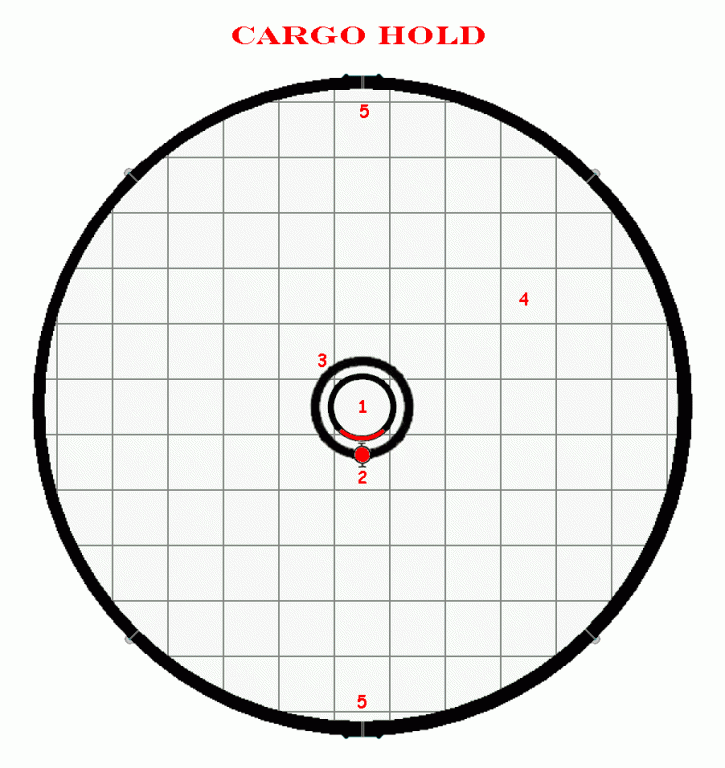
1> Central Elevator: the central elevator accesses all decks. It will take d10-3 turns to call the elevator (zero or less means the car is already on that deck), depending on what deck it was on last. Command officers (captain, pilots, engineers, astrogators, and gunnery officers) can halve that time by overriding the elevator with their ID (command officers have priority so the elevator won't stop at other decks while called upon). The elevator will sound an alarm tone when sensing a vaccuum outside, two buttons on opposite sides of the door must be pressed to open the door into a vaccuum (the elevator will depressurize and then open). 2> Cargo Hold Elevator Airlock: there are two such accessways into the hold, one on each end of the hold (floor and cieling). The pressure can be controlled in each airlock or overridden in the bridge. 3> The Cargo Arm travels along this entire reinforced outer shell of the elevator shaft. 4> Cargo Hold: this section is tiered into five sections for ease in cargo loading and location. The hold can be pressurized, but only with both bay doors secured. Unless the hold is filled with unsealed/unprotected agricultural products, it is typically in a state of vaccuum to prevent loss of cargo in the event of combat. 5> Exterior Bay Doors: these can be opened from the Freight Handler Station on the Engineering Deck. Each set of bay doors open to expose a 90 degree cross section of the hull to allow cargo transfer. |
|
Wicked Wench deck 6: Engine Room
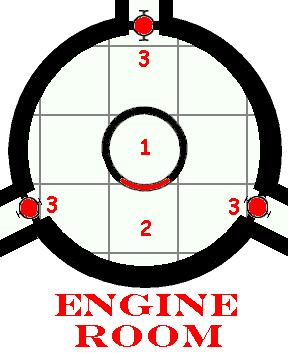
1> Central Elevator: the central elevator accesses all decks. It will take d10-3 turns to call the elevator (zero or less means the car is already on that deck), depending on what deck it was on last. Command officers (captain, pilots, engineers, astrogators, and gunnery officers) can halve that time by overriding the elevator with their ID (command officers have priority so the elevator won't stop at other decks while called upon). The elevator will sound an alarm tone when sensing a vaccuum outside, two buttons on opposite sides of the door must be pressed to open the door into a vaccuum (the elevator will depressurize and then open).
2> Parts and tool storage: there are cabinets along each wall for small parts and tools, along with monitoring gauges for each engine.
3> Engine Access: Each engine strut has a two part accessway, with an airlock/decontamination chamber followed by the access tunnel. These accessways slope down (at a 30 degree angle) and away from the hull.
Approximately 50% of the overhaul time will be spent in the engine room/accessways, with the remaining 50% in the Engineering Deck.
Parallel to main axis plans
This section will house non-conventional KH type deckplans, such as those found in other "cinematic" genres such as Star Trek, Star Wars, or Traveller. Such craft, when equipped with chemical drives, make for fine system ship deck plans.
MRX-8
--- work in progress ---
pf-100 era scout ship
HS:2 HP:10 Powerplant: 3 Chemical A
ADF:3 MR:4 DCR:16 Crew: up to 2
Armament: optional LC (mark 1) @ -1 ADF or MR penalty
Defenses: optional RH
Communication/Detection: Subspace Radio, Radar, Intercom
Misc: Streamlined
Computer
Alarm (3)
Analysis (2)
Astrogation (2)
Commerce (1)
Computer Lockout (3)
Computer Security (3)
Damage Control (3)
Drive, Chemical A (1)
Information Storage (1)
Life Support, cap:2 (1)
Maintenance (3)
Cargo Capacity: personal gear
Crew Accomodations: 1 two-bunk cabin
Passenger Accomodations: 0
Ship's Vehicles: 0
The MRX-8 scout ship saw extensive service as a survey & research vessel during the first corporate war. The small craft would ferry two crew members around the system on their various prospecting missions. Some of these vessels were pressed into spy missions against the Mining Guild, equipped with surveillance equipment and prototype sensor jammers developed by Streel, hence the rebadging as a scout ship.
* Adapted from the WEG Star Wars RPG system
Aquilian Starling
Privateer (pf:100 system ship, owned by Robert Kitridger)
HS:4 HP:24 Powerplant: 3 SC Chemical A
ADF:4 MR:4 DCR:25 Crew: 3-8
Armament: LB(x2)
Defenses: RH
Comm/Detection: SubSpace Radio, Radar, Intercom, WNB
Misc Equipment: Streamlined, Light Armor, Back-up LS unit, Mk-X5 fuel tankage
COMPUTER ( LVL:6 fp:237 Mass/SP:1000kg/600 )
Alarm (3) 8
Analysis (3) 8
Astrogation (2) 8
Bureaucracy (3) 12
Commerce (1) 4
Communication (1) 4
Computer Lockout (5) 32
Computer Security (4) 24
Damage Control (3) 12
Drive - Chem A (1) 4
Industry (1) 4
Information Storage (1) 3
Installation Security (5) 64
Laser Battery x2 (1) 2 x 5
Life Support cap:8, x2 (1) 2 x 2
Maintenance (3) 12
Robot Management (4) 24
Cargo Capacity: 2 (Main:1.25, Forward: 0.25, Aft: 0.5)
Crew Accomodations: 3 bunk cabin, double suite
Passenger Accomodations: 0
Ship's Vehicles: AWD Ground Car, Ground Cycle
Fuel: 180u S-Ox ( +3 x 12u ExTanks)
Max Safe Velocity: 30 (+6)
The MAIN DECK features a two person helm, 6 person bunk barrack, two person suite, all adjacent to the crew lounge/computer which doubles as the forward hold. A ladderwell runs up to the dorsal gun and down to the main hold & ventral gun. A fresher fills the gap behind the bridge accesway and a shower unit flanks the ladderwell. Fore of the crew lounge are the forward "mandibles" featuring most of the avionics, communication, sensors, and electronics. Aft of the crew lounge is the engine room, with RCS thruster banks, generator & power relay station, life support equipment (including water tank and purification plant) and work stations. Starboard of the lounge is the cargo loading dock and boarding ramp, along with a defensive anti-personnel gun. The aft hold is adjacent to the loading dock.

The LOWER DECK is comprised of the main hold w/loading ramp and access to the landing gear. To port is a computer maintenance shaft that connects the main computer to the helm. Below the Main Hold is the ventral gun position.
A cross sectionof the ladderwell details the deck arrangement. Note the gunnery positions boast lower cielings, minimizing aerodynamic drag and producing only mild comfort issues when not seated at the command chair.____________________
Post Sathar War 1 version, wrecked/salvaged/revived by John Knightrazor, currently owned by Richard Sterling:
HS: 3* HP: 18 Powerplant: 3 Pan-Galactic "Eureka" Atomic A
ADF: 5 MR: 3 DCR: 32 Crew: 2, can accomodate up to 9
Armament: LB (x2)
Defenses: RH
Communication/Detection: SubSpace Radio, Radar, Energy Sensor, Intercom
Misc Equipment: Light Hull Armor, Skin Sensors, Delux Astro, Camera System, Cybernetic Uplink Slave Circuits
Computer
(LVL: 4 fp: 198 sp:100)
Alarm (3), Analysis (6), Astrogation (4), Bureaucracy (5), Commerce (1), Communication (4), Computer Lockout (6), Computer Security (6), Cyber-link (3), Damage Control (3), Drive (4), Information Storage (3), Installation Security (6), Language (6), Laser Battery (1) x2, Life Support - cap:9 (1) x2, Maintenance (3), Robot Management (6)
Cargo Capacity: 2.5 (0.9 lower hold, 1.6 aft hold)
Fuel Tankage: 9 uranium pellets, 3/drive
Crew Accomodations: 1 double cabin, 1 six-bunk cabin, 1 bunk in rec area
Passenger Accomodations: n/a
Ship's Vehicles: 0
* Actual displacement is HS:3, vessel was reduced by damage/reconstruction from original HS:4
Crew: Richard Sterling (mH) Pilot:3, Engineer:3, "Glasya" Carolina Sterling (cybernetic fH) Pilot:2, Astrogator:2, Engineer:1, Energy Gunner:4 --- Glasya may multi-task via the cyberlink connections, thus operating both battery weapons simultaneously as well as performing co-pilot & astrogator operations and coordinating engineer functions.
The Starling has a rich history, dating back before the founding of the UPF. A young Captain John Knightrazor (formerly Robert Kitridger) acquired it via a government contract co-signed by Streele, Inc. Later the ship required major renovations after a near fatal encounter during the first Sathar War. The ill-fated vessel unknowingly dropped out of the void into a UPF system that the Sathar Battle Fleet had already entered, and the ship took a beating. It would have no doubt been destroyed if not for the timely intervention of Admiral Morgaine's fleet, who arrived and made the unfriendlies feel most unwelcome. The Starling was taken in tow and it's crew began redesigning what they had left to work with.
When the war was officially over the Starling's crew were finally able to secure dock space for the reconstruction. The entire engine compartment had been destroyed, as well as a portion of the forward starboard side. Supplies were short and in demand so rebuilding the missing sections became a timely and costly operation, the crew instead opted for sealing up those sections and relocating the salvageable equipment. The drives were relocated from their original inboard location to an outboard set up, with one drive on both the dorsal and ventral sections of the aft section and the third replacement drive was attached via struts off to the portside, thereby filling in that missing section. All the replacement equipment that was destroyed in the fore section ended up on the port side of the forward hull, making it a nearly impassible area to work in. Jonathan gifted the salvaged vessel to his son Stephen who sold it after nearly ten years of freight hauling in favor of subcontracting a new RT model. It was later re-gifted to Stephen's son Jonathan who sold it to the current owner, adventurer Richard Sterling. Captain Sterling still owns and operates it today, with cyber-slave circuits installed so that Sterling's cyborg/wife could control and operate multiple systems from one location, thus allowing for a reduced crew
.
As a result of the salvage/reconstruction, the actual hull displacement ended up dropping from HS:4 to HS:3, but through clever restructuring of the interior the cargo capacity remained the same, what with the drives being converted to outboard this opened up some extra unused deck space. One additional benefit comes with the smaller size, with Class A drives designed to power a size 4 hull now powering smaller displacement size 3 hull, the ship now performs a little better. In fact current owner Silver has logged some very respectable times in the Zebulon Run with "the Clunker" (as he affectionately calls her). Unfortunately that fame comes with a price for Silver, who prefers to avoid any interstellar attention...
Deck Plans

Main Deck
Lower Hold
Assault Courier
(pf:100 system warship)

HS:3 HP:18 Powerplant: 4 SC-Chemical A
ADF:3 MR:4 DCR:24 Crew: 4-16
Armament: LC(mk1), LT
Defenses: RH
Comm/Detection: SubSpace Radio, Radar, Intercom
Misc Equipment: Streamlined, light hull armor, mk:3 fuel tankage
COMPUTER
Alarm (4)
Analysis (2)
Astrogation (2)
Commerce (1)
Communication (1)
Computer Lockout (3)
Damage Control (4)
Drive - Chem A (1)
Industry (1)
Information Storage (1)
Laser Cannon (1)
Laser Battery (1)
Life Support cap:16 (1)
Maintenance (4)
Cargo Capacity: 0.5
Crew Accomodations: 4 cabin (single or double occupancy), 2 lg cabins (single to quadruple occupancy)
Passenger Accomodations: 0
Ship's Vehicles: varies, ground/atmo vehicle bay
Fuel: 92u S-Ox (+2 x 12u ExTanks)
Max Safe Velocity: 24 (+12)
DECK PLANS
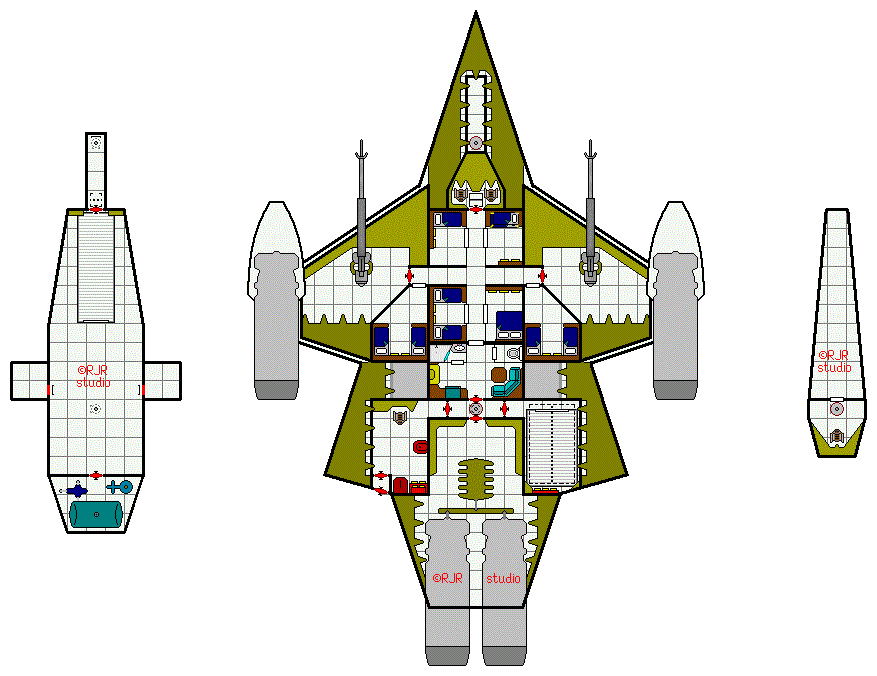
Derived from the tried & true PGC Courier, the SI/C-300 Assault Courier variant is the result of what happens when the Streele, Incorporated military contractors get a hold of the design. Outboard sections flank each side of the craft to which an additional pair of drives have been attached, allowing for a quartet of supercharged Chem-drives which triples the standard Courier's performance ratings. Additional RCS maneuver jets were also added in these new section to increase the nimble nature of these craft. Two more cabins were added in the outboard sections, thereby increasing the possible crew size (these cabins tend to have a pair of bunkbeds to allow for eight troops in addition to the standard crew quarters). Additional flight control equipment is mandated for such performance increases, and this too is packed within these outboard sections.
The rest of the design retains the original donor ship's features: the lower cargo hold & life support, crew lounge area & galley along with the original four cabins, vehicle bay, engineering bay, and equipment storage attic. These warships were not mass produced, seeing service strictly among the Pale & New Pale militias along with Pan Galactic Conglomerates' Mining Guild (although more than one of the Guild's craft were seized by pirates).
Basic Shuttle
HS:2 HP:10 PowerPlant:1 Chemical A
ADF:1 MR:4 DCR:26 Crew:up to 2
Armament: N/A
Defenses: N/A
Communications/Detection: SubSpace Radio, Radar, Intercom (1 master panel; speaker/mike in cabin, hold, and engine room)
Misc Equipment: N/A
Computer (LVL:2 fp:14 Mass/SP:8)
Alarm (1)
Astrogation (1)
Commerce (1)
Damage Control (1)
Drive - Chemical A (1)
Life Support cap:20 (1)
Cargo Capacity:0.5
Crew Accomodations: 2 acceleration seats
Passenger Accomodations: 18 acceleration seats
Ship's Vehicles: N/A
Cr:196,680
C-37 Courier
HS:2 HP:12 Powerplant: 2 Chemical A
ADF:1 MR:4 DCR:24 Crew: up to 4
Armament: optional LT
Defenses: optional RH
Communication/Detection: Subspace Radio, Radar, Intercom
Misc: Streamlined, Light Armor, Mk:x3 Fuel Tankage
Computer
Alarm (2)
Analysis (2)
Astrogation (2)
Commerce (1)
Computer Lockout (3)
Computer Security (3)
Damage Control (2)
Drive, Chemical A (1)
Information Storage (1)
Life Support, cap:6 (1)
Maintenance (2)
Cargo Capacity: 1
Crew Accomodations: 4 single crawl-bunks
Passenger Accomodations: 0
Ship's Vehicles: varies
Fuel Tankage: 72u S-Ox (plus two 12u ExTanks)
Max Speed: 18 (+6)
The C-37 was a fine courier craft offered to the general public during the first corproate war in Truane's Star. Many a civilian crew found fortune with this small ship, running errands for or against the Mining Guild during that dark era. The small craft offered fair quarters and a decent sized hold, although not large enough to be profitable. However, these craft earned a notorious reputation with smugglers who were hiding contraband within the various access plates in the deck and other convenient hidey-holes found throughout the craft...
The C-37's wings and drives rotate 90º on a gimbal to permit VTOL operation...it lifts off the ground like a helicopter and as the drives & wings are angled it begins to move forward like a plane, eventually building enough velocity to break the atmosphere. Planet fall is conducted in the opposite direction: it enters the atmosphere tail first and uses thrust to decelerate, eventually rotating the wings/engines to vertical for a soft landing. The external fuel tanks mount dorsally over the cargo section.

* Adapted from the WEG Star War RPG system
Courier
(pf:100 system ship)
adapted from the Traveller RPG Scout/Courier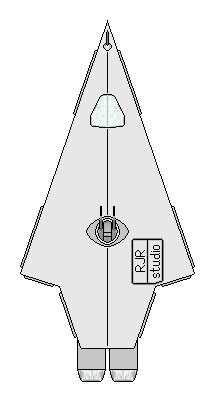
HS:3 HP:15 Powerplant: 2 Chemical A
ADF:1 MR:3 DCR:24 Crew: 3-8
Armament: LT
Defenses: RH
Comm/Detection: SubSpace Radio, Radar, Intercom
Misc Equipment: Streamlined, Mk:X2 Fuel Tankage
COMPUTER
Alarm (2)
Analysis (2)
Astrogation (2)
Commerce (1)
Communication (1)
Computer Lockout (3)
Damage Control (2)
Drive - Chem A (1)
Industry (1)
Information Storage (1)
Laser Battery (1)
Life Support cap:8 (1)
Maintenance (2)
Cargo Capacity: 0.5
Crew Accomodations: 4 cabins, single or double occupancy
Passenger Accomodations: 0
Ship's Vehicles: varies, ground/atmo vehicle bay
Fuel: 48u S-Ox (+ two 12u ExTanks)
Max Safe Velocity: 12 (+6)
DECK PLANS
Pan Galactic Conglomerates designed this extremely versatile system ship which has seen use in many systems, and they can still be found in service within systems employing multiple orbital space stations and civilized planets.
The Lower Deck (left) is the cargo hold with boarding ramp and access to the landing gear. Aft is the life support equipment, including water tank and purification plant.
The Main Deck (center) has a forward avionics/RCS thruster bank area accessible from below. The bridge also has a maintenance hatch leading below and command chairs for two (a pilot and navigator). Aft of the bridge are four cabins that can be arranged for single or double occupancy as the crew desires. Behind the cabins is the crew lounge with galley, fresher, and washroom. The lounge connects to a four way access chamber with hatches leading port to the engineering section, starboard to the vehicle bay (an open hover transport is depicted), and stern to the engine room. A floor hatch in the center leads to the cargo bay, a cieling hatch leads to the gunnery position above.
The Upper Deck (right) has the gunner position above the vertical hatch with controls for the ship's laser turret. Forward of the gunnery position is an attic containing the sensors and communication equipment.
Fair Trader/Fast Trader
Merchant Vessel (pf:100 system ship)
HS: 4 HP: 20 Powerplant: 3 Chemical A (SC for Fast Trader)
ADF: 1(2) MR: 3 DCR: 27 Crew: up to 8
Armament: LT(x2)
Defenses: RH
Communication/Detection: Subspace Radio, Radar
Misc: Streamlined. Mk:X4 Fuel Tankage
COMPUTER
Alarm (3)
Analysis (2)
Astrogation (2)
Commerce (1)
Computer Lockout (3)
Computer Security (3)
Damage Control (3)
Drive, Chemical A (1)
Industry (1)
Laser Battery (1) x2
Life Support, capacity:22 inc 4 1st class (1)
Maintenance (3)
Cargo Capacity: 2.5
Fuel Tankage: 144u S-Ox (+ three 12u ExTanks)
Max Speed: 24 (+6)
Crew Accomodations: Captain's double suite, 3 double cabins
Passenger Accomodations: 2 double 1st Class cabins, 4 double journey class cabins
Ship's Vehicles: small launch
DECK PLANS
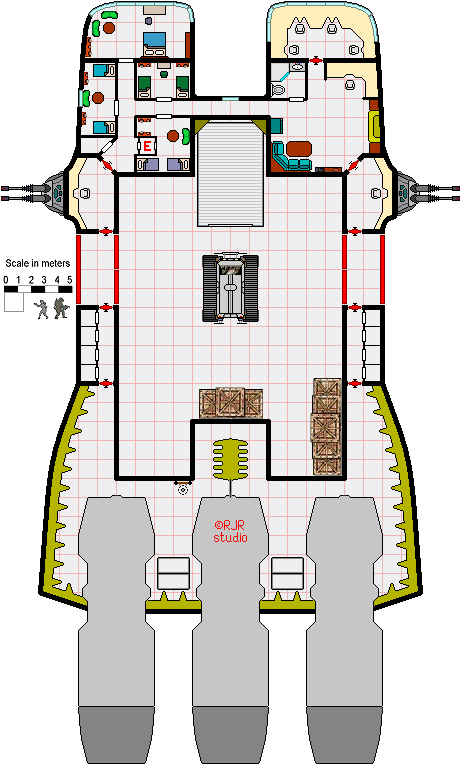
The Main Deck is accessible via the cargo bay, by a loading ramp at the fore and airlocks boasting large bay doors port and starboard. Aft of the airlocks are crew lockers, behind that is the engine room with a generator and RCS thruster banks. Forward of the airlocks are the port and starboard gunnery positions with controls to the ship's two laser turrets. The ship is divided into two parts fore of the guns, the port side sporting three double occupancy crew cabins, elevator to upper deck, and a captain's suite. Located starboard is the crew lounge (with galley, fresher, and shower), computer console, and the bridge.

The
Upper Deck is divided into three sections. At the fore are the passenger cabins, including a quartet of double occupancy Journey class cabins and a pair of 1st class suites positioned over the bridge and captain's suite. The launch bay divides the cabins port and starboard, aft of the bay is the passenger lounge. A trio of smaller rooms are positioned aft of the lounge that can serve as a variety of functions, normally the two smalelr rooms serve as storage space and the larger as an office. The midsection is comprised of avionics, electronics, and the communication & sensor arrays, all accessible only via the engineering section. Stern is the maintenance deck with the engineer station, life support equipment (including water tank and purification plant), power relay station, and workshop.
adapted from the Traveller RPG "Far Trader"
HWIS Planeteer
retro-fitted pre-UPF era scout ship
HS:3 HP:15 Powerplant: 2 Ion A, 4 Chemical A
ADF:1 (2) MR:4 DCR:24 Crew: up to 4
Armament: optional LT
Defenses: optional RH
Communication/Detection: Subspace Radio, Radar, Intercom
Misc: Streamlined
Computer
Alarm (6)
Analysis (4)
Astrogation (4)
Commerce (1)
Computer Lockout (3)
Computer Security (3)
Damage Control (6)
Drive, Chemical A (1)
Drive, Ion A (3)
Information Storage (1)
Life Support, cap:6 (1) x2
Maintenance (6)
Cargo Capacity: 0.5
Crew Accomodations: 2 double occupancy cabins
Passenger Accomodations: 0
Ship's Vehicles: varies
Fuel Tankage: 72u S-Ox (plus two 36u ExTanks), 20K LiqH
Max Speed: 18 (+18) (chemical drive only, unlimited w/Ion)
This Hepplewhite, Inc. scout ship is an old design predating the UPF, this particular sample has been updated with modern conveniences. Hepplewhite has never been shy about spending credits on their business ventures, and the Planeteer is no exception. Utilizing a pre-UPF design, this pricy vessel sports a pair of Ion star drives in addition to a quartet of chemical thrusters to permit planetary landings. The dated decks-parallel is an inconvenience during jump acceleration, the crew needs to be belted in for the entire accel.deceleration phase and can only travel about during zero-G movement via free fall. However once parked on a planetary surface the decks are naturally simple for such duty. This particular vessel crash landed and was discovered by a group of novice adventurers, the sole survivor of the crew being a Yazirian child.
Pan Galactic Conglomerates Gunned Scout
PGC2650 Scout/Invader
HS:3 HP:15 Powerplant: 2 Quad-Chemical A
ADF:4 MR:4 DCR:30 Crew: up to 8
Armament: FFR(x4), LT
Defenses: RH
Communication/Detection: Subspace Radio, Radar, Intercom
Misc: Streamlined, Mk:X8 Fuel Tankage
Computer
Alarm (6)
Analysis (2)
Astrogation (2)
Commerce (1)
Computer Lockout (3)
Computer Security (3)
Damage Control (6)
Drive, Chemical A (1)
Forward Firing Rockets (2)
Information Storage (1)
Laser Turret (1)
Life Support, cap:8 (1)
Maintenance (6)
Cargo Capacity: 0.5
Crew Accomodations: 4 double occupancy cabins
Passenger Accomodations: 0
Ship's Vehicles: n/a
Fuel Tankage: 768u S-Ox (plus four 24u ExTanks)
Max Speed: 48 (+6)
Misc: streamlined
Pan Galactic Conglomerates needed a swift armed craft to further their agenda in Truane's Star via the Mining Guild. To this end their shipwrights designed a sleek atmospheric capable vessel armed to the teeth with forward firing rockets and a laser turret. A quartet of chemical thrusters are perched at the end of each wing to provide starfighter-grade acceleration, and an ample fuel supply guarantees that it will reach velocities sufficient to catch any fleeing craft.
A century and a half later WarTech would utilize the basic design in their Stilleto class Assault Scout.
Deck plans are rendered in 2m square scale
Pirate Scout Ship
system scout ship
HS: 3 HP: 18 Powerplant: 4 SC Chemical A
ADF: 3 MR: 3 DCR: 30 Crew: up to 6
Armament: FFR(x2), LT(x2)
Defenses: RH
Communication/Detection: SubSpace Radio, Radar, Intercom
Misc Equipment: Streamlined, Light Armor
Fuel: 144u S-Ox (+4 x 36 ExTanks)
Max Speed: 18 (+18)
Computer
Alarm (4)
Analysis (2)
Astrogation (2)
Commerce (1)
Communication (1)
Computer Lockout (4)
Computer Security (4)
Damage Control (4)
Drive: Chemical A (1)
Forward Firing Rockets (2)
Industry (1)
Information Storage (1)
Installation Security (4)
Laser Turret (1) x2
Life Support, cap:8 (1)
Maintenance (4)
Cargo Capacity: 0.5
Crew Accomodations: 2 triple bunks
Passenger Accomodations: n/a
Ship's Vehicles: none
Typical example of a pirate craft found during the first corporate war in Truane's Star. Streel captured several of these and revamped them for special missions against the Mining Guild, dropping the forward firing rocket systems in favor of a light laser cannon and extra fuel tankage (and a resulting performance gain).
In their stock guise, the pirate scouts packed a good punch. A pair of laser turrets to disable their target craft were complimented by the rocket systems that would ward off escort craft, and their small holds could carry away some valuables afterwards (although not much, hence these vessels were often encounted in groups of more than one).

*Adapted from the WEG Star Wars RPG system
PT-250 Stratus class transport
(pf:100 era system ship)
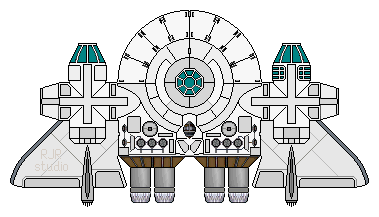
HS:2 HP:14 Powerplant: 4 Chemical A
ADF:3 MR:4 DCR:26 Crew: minimum 2, up to 6
Armament: optional LT(x2) @ -1 ADF or MR each/max:2
Defenses: RH
Communication/Detection: Subspace Radio, Radar, Intercom
Misc: streamlined, medium hull armor, Mk:X4 Fuel Tankage
Fuel Capacity: 192u S-Ox (plus four x 12u ExTanks)
Max Speed: 24 (+6)
COMPUTER
Alarm* (4)
Analysis (2)
Astrogation (2)
Bureaucracy* (2)
Computer LockOut* (3)
Computer Security* (3)
Commerce (1)
Communication (1)
Damage Control* (4)
Drive - Chem A (1)
Life Support, cap:6 (1) +6 Journey class (type P/T) or +8 1st class (type Y)
optional Laser Battery (2) x2
Maintenance* (4)
Cargo Capacity: 1 (type T), 0.5 (type P/T), or 0 (type Y)
Crew Accomodations: 1 dbl suite + 4 single cabins
Passenger Accomodations: 0 (type T) or 3 Journey Class cabins (type P/T) or 4 1st class suites (type Y)
Ship's Vehicles: n/a
DECK PLANS rendered in 1.5 meter squares

The port pod contains a helm with four command chairs, a two person captain's cabin, a computer room/rec area, a storage closet, and life support equipment. The starboard pod contains a crew galley & rec area, access to the life support equipment, and a fresher. The forward area is an open cargo hold with a loading ramp, aft of the hold is the four single occupancy crew cabins. Aft of the cabins is a narrow hallway with a boarding ramp and outer hull hatch (thus doubling as an airlock), flanked by maintenance panels leading to the port & starboard twin thrusters. Centered in the ship is a ladderwell leading up and down to observation rooms, the ventral chamber is inverted with everything mounted "upside down" in relation to the rest of the ship allowing occupants to look "up" to the stars through the "overhead" viewport. These observation rooms can be easily converted to laser turret hardpoints, with the ventral unit remaining inverted under such construction.
Two variants of the PT-250 can be ordered: the Type Y replaces the forward hold with a quartet of two person suites along with a lounge and storage areas (thus designating it as a yacht). The Type P/T divides the forward hold into a half hold (½ unit capacity) and a trio of two person cabins (two journey class and a suite).
Regardless of variation, smaller crews may opt to offer passage via unused crew cabins.adapted from the WEG Star Wars RPG
SI/F-432 "Strider" class Light Freighter (work in progress)
(pf:100 era system ship)
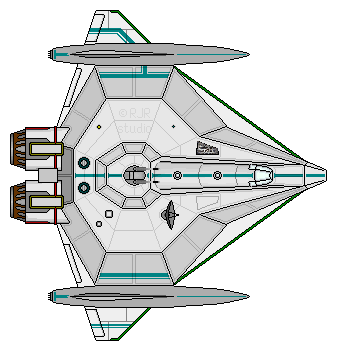
HS:4 HP:24 Powerplant: 4 Chemical A
ADF:1 MR:3 DCR:32 Crew: 3-8
Armament: LB
Defenses: RH
Comm/Detection: SubSpace Radio, Radar, Intercom
Misc Equipment: Streamlined, light hull armor, Mk-3 fuel increase
COMPUTER
Alarm (4)
Analysis (2)
Astrogation (2)
Commerce (1)
Communication (1)
Computer Lockout (3)
Damage Control (4)
Drive - Chem A (1)
Industry (1)
Information Storage (1)
Laser Battery (1)
Life Support cap:8 (1)
Maintenance (4)
Cargo Capacity: 3
Crew Accomodations: 4 cabins, single or double occupancy
Passenger Accomodations: 0
Ship's Vehicles: varies, ground/atmo vehicle bay
Fuel: 192u S-Ox (+4 x 12u ExTanks)
Max Safe Velocity: 24 (+12)
When Streele, Incorporated designed the SI/F-432 they did so with the concept of a "space pick-up truck" in mind. As such they went with the size:4 "biggest of the small ship hulls" for maximum scale at a minimum price. Like a pick-up, the cab offers comfort and the cargo bed offers...space for cargo. The Strider class light freighter is no different, it has just enough comfort in the living area while maintaining a dedicated space for hauling anything and everything. Light hull armor makes it tough without impeding performance, which is a far cry from sporty but still respectable for what it is: a simple design dedicated to a simple purpose. That said, anyone wishing to explore the boundaries of performance can always remove the laser battery to restore MR back to 4, but the threat of pirates has captains trending to retain the long range defensive system.
Deck Plans TBA
SI/M-250 Merchant Courier
(pf:100 system ship)
HS:3 HP:15 Powerplant: 2 Chemical A
ADF:1 MR:4 DCR:24 Crew: up to 6
Armament: optional LT (in lieu of upper hold)
Defenses: optional RH
Communication/Detection: Subspace Radio, Radar, Intercom
Misc: Streamlined, Mk:X3 fuel increase
COMPUTER
Alarm (2)
Analysis (2)
Astrogation (2)
Commerce (1)
Computer Lockout (3)
Computer Security (3)
Damage Control (2)
Drive, Chemical A (1)
Information Storage (1)
Life Support, cap:6 (1)
Maintenance (2)
Cargo Capacity: 1.5 (1 main hold + 0.5 forward hold), optional 0.25 upper hold in lieu of turret
Crew Accomodations: 1 dbl suite, 1 two-bunk cabin
Passenger Accomodations: 0
Ship's Vehicles: varies
Fuel Tankage: 72u S-Ox (plus two 12u ExTanks)
Max Speed: 18 (+6)
Streele, Incorporated reverse engineered the classic PGC Courier to create a more trade oriented variant which has been dubbed as a Merchant Courier. While much of the donor ship's DNA has been preserved, everything forward of the engineering & vehicle bays has been revamped. With the base disc shape taking over the former wedge, additional space was permitted for a larger ventral hold. Cutting the point off the nose and splitting it into a pair of "mandibles" mandated moving the helm from center to port side, and said additional disc space opened up some additonal acreage for a secondary hold. While the fore to stern equipment attic was lost, the additional upper deck saucer space allowed for the ease of installation for a turret weapon and fire control, although some owners who trust in the protection offered by the Mining Guild sacraficed this in lieu of additional cargo stowage.
DECK PLANS
The Main Deck commences with a cargo loading dock located starboard, complete with boarding ramp and bay doors. A second set of bay doors leads to the forward hold and access to the starboard electronics/avionics. A hatch fromthe loading dock leads inward to a semi-circular accessway that circles around to a forward communication/sensor array, mainframe computer, and the crew cabin. Access to the port avionics/electronics is near the mainframe. The semi-circular accessway continues around to the portside with access to the bridge and captain's suite, occassionally spotted with other maintenance hatches. The semi-circular accessway terminates at the crew lounge, sporting a galley, fresher/shower room, and a storage room. A ladderwell centered in the lounge leads up to the gunnery position and down to the main hold. A hatch in the stern bulkhead leads to engineering (port), the engine room (stern), and vehicle bay (starboard, open ground transport depicted).
The Lower Deck is comprised mostly of the mainhold and has maintenance access to the landing gear and a hatch leading to the life support equipment (including a water tank and purification plant).
The Upper Deck is a low cieling chamber with controls to the ship's laser turret and a small attic.

ST-260 light freighter
(pf:100 era system ship)
HS:3 HP:15 Powerplant: 2 Class A SC Chemical drives
ADF:2 MR:4 DCR:30 Crew: up to 6
Armament: LT(x2); dual machine gun turret over entry ramp
Defenses: RH
Communication/Detection: Subspace Radio, Radar, Intercom
Misc: streamlined hull, mk:4 fuel tankage
Cargo Capacity: 2 (1.25 main hold + 0.75 forward hold)
Fuel Tankage: 96u Solid Oxygen (plus two 12u external tanks)
Maximum Safe Velocity: 24 (+6)
Crew Accomodations: 1 double suite + 4 bunks + medical bunk
Passenger Accomodations: 0
Ship's Vehicles: 0
 lower deck
lower deck
The ST-260 was originally a one-off custom production loosely based on the SI/M-250 in conjunction with Streele, Incorporated's shipyard and a private contractor. Eventually negotiations opened the door to model production for others that desired the new design.
Whereas the SI/M-250 introduced a saucer shape into the classic wedged hull of the PGC Courier, the ST-260 centered the design around the disc and added the wedge to its extremities. The main deck hosts the helm to starboard, a forward galley/lounge with four bunks (this area doubles as a secondary hold), an elaborate captain's suite, medical bay, and a vast engineering/engine room taking up a majority of the stern. An airlock takes up the port side while an atmospheric boarding ramp with a heavy weapon turret takes up the starboard side. Down below is the main hold with access to the landing gear. Turret weapons are mounted in both the dorsal and ventral positions.
ST-2850T Transport
Trans Travel ST-2850T
system transport vessel
HS:3 HP:15 Powerplant:4 chemical A
ADF:2 MR:4 DCR:
Armament:LB
Defenses:RH
Communication/Detection: Radar, Subspace Radio
Misc Eqipmewnt: System Astrogation
Computer
Alarm(4)
Analysis(2)
Astrogation(2)
Commerce(1)
Communication(1)
Computer Lock-out(4)
Damage Control(4)
Drive:chemical"A"(4)
Industry(1)
Installation Security(3)
Laser Battery(1)
Life Support(1) cap:24
Maintenance(4)
Crew Accomodations: captain's suite (double occupancy) + 7 single cabins
Crew Positions: pilot, navigator, engineer, technicians(x2), gunner, medic, steward
Passenger Cabins: 14 single cabins
Cargo Capacity:3 (2 x 1.5u detachable cargo modules)
DECK PLANS
Lower/Main Deck
1> Bridge
2> Captain's stateroom
3> Fore Lift Shaft
4> Crew Galley
5> Crew Cabins
6>Passenger Galley
7> Passenger Cabins (a-d)
8> Purification Plants
9> Aft Lift Shaft & Locker
10> Engineering
11> Lower Engine Room & Airlock
12> Life Support
13> Port Cargo Bay
14> Starboard Cargo Bay
Upper Deck
7> Passenger Cabins (e-n)
13> Port Cargo Bay
14> Starboard Cargo Bay
15> Fore Lift Shaft
16> Locker
17> Infirmary
18> Pasenger Galley
19> Lateral Accessway
20> Aft Lift Shaft & Locker
21> Upper Deck Engine Room
22> Aft Airlock
ST-3000
light freighter
HS: 3 HP: 15 Powerplant: 2 Chemical A
ADF: 1 MR: 4 DCR: 24 Crew: up to 4
Armament: optional LT @ no penalty
Defenses: optional RH
Communication/Detection: SubSpace Radio, Radar, Intercom
Misc. Equipment: streamlined
Fuel: 72u S-Ox (+ 2 x 36u ExTanks)
Speed: 18 (36)
Computer
Alarm (2)
Analysis (2)
Astrogation (2)
Commerce (1)
Communication (1)
Damage Control (2)
Drive-Chemical A (1)
Industry (1)
Life Support, cap:4 (1)
Maintenance (2)
Cargo Capacity: 1.5 (2 x 0.6 main holds, 6 x 0.05 holds)
Crew Accomodations: 2 single cabins, 2 bunks
Passenger Accomodations: n/a
Ship's Vehicles: 0, bridge module is an escape pod
The ST-3000 is a Streel designed system freight hauler hailing from the first corporate war. These craft ferried supplies between the two civilized planets as well as running supplies to distant mining operations in the system. As the Mining Guild became more aggressive, captains began to upgun these craft at no penalty with a single dorsally mounted laser turret, as such many of these armed light freighters saw extended service as blockade runners.
 ST-3000 lower deck (entry amp/crew cabins)
ST-3000 lower deck (entry amp/crew cabins)
 ST-3000 Main Deck (bridge, main holds, crew lounge, cabins, and engineering)
ST-3000 Main Deck (bridge, main holds, crew lounge, cabins, and engineering)

ST-3000 Upper Deck (storage)
* Adapted from the WEG Star Wars RPG system
TSEF Serena Dawn
Serena Dawn main deck
Serena Dawn upper deck
Z-10 Modular Hauler
system freight transporter
HS:1 HP:5/8/11 Powerplant: 4 Chemical A
ADF:4/2/1 MR:4/3/2 DCR:24 Crew: up to 2
Armament: none
Defenses: optional RH
Communication/Detection: Subspace Radio, Radar, Intercom
Misc: Streamlined
Computer
Alarm (4)
Analysis (2)
Astrogation (2)
Commerce (1)
Computer Lockout (3)
Computer Security (3)
Damage Control (4)
Drive, Chemical A (1)
Information Storage (1)
Life Support, cap:2 (1)
Maintenance (4)
Cargo Capacity: 2 (two modular 1U containers)
Crew Accomodations: 2 single bunk cabins
Passenger Accomodations: 0
Ship's Vehicles: 0s
Fuel Tankage: 144u S-Ox (plus four 36u ExTanks)
Max Speed: 18 (+18)
Cargo Container: 1u capacity, adds 3 HP to total hull points, performance affected depending on number of containers --- ADF & MR of 4 & 4 respectively for an unladen Conveyor, 2 & 3 for one container, and 1 & 2 for two containers. Accrued damage may be applied to either the host ship or container, any time 3 or more points of damage are sustained roll 50% to determine if it applies to the container or the host ship. Any containers taking 3+HP damage are destroyed along with their contents, however if the host ship is destroyed (absorbing all the damage toward the total) there is a 25% chance per container that each container will survive.
The ZS-205 was an efficient method of supply transport during the earliest corporate wars at Truane's Star. Consisting of a basic hull with a helm, crew lounge, and quarters; the ZS-205 was unique that it had a pair of detachable U-shaped cargo nacelles that fit snug around the main hull. Fully loaded, the pair of chem drives accelerates at the slower rate (1), with one nacelle it can accelerate at the middle rate (2), and unladen it can move at maximum acceleration (4). MR is likewise affected accordingly, reduced to the consecutive lower figure per container. More importantly, these craft could arrive and depart quickly assuming waiting nacelles were already loaded, it was a simple matter of detaching the full container for a new one and shoving off.
DECK PLANS
( rendered in one meter squares )

The bridge has a single command chair, aft is the mainframe computer. A door leads to the airlock hatch and a storage closet. Aft of that is the crew galley & lounge along with a fresher and two single bunk cabins. There is no access to the cargo nacelles from within the ship, they may only be accessed by taking a space walk. The four drives must also be addressed from the exterior as the craft is too small for an engineering section. The dashed lines running the length of the main axis repsresent where the cargo nacelles overlap the main hull.
* Adapted from the Z-10 Modular Hauler WEG Star Wars RPG system
Star Fighters
This document will host various fighter craft that can be used in the KH campaign. Typical HS:1 craft do not require deck plans, as they will usually consist of a one or two person cockpit. Instead, techs & specs will be included for KH play.
ARC-71 Intruder (pf:100 era)
Streele, Inc. Advanced Recon/Combat heavy fighter

HS:2 HP:14 Powerplant: 3 Class A SC Chemical drives
ADF:3 MR:4 DCR:30 Crew: 1-2
Armament: LC(mk:1), SM(x2)
Defenses: RH
Communication/Detection: Subspace Radio, Radar, ½ camera system
Misc: streamlined hull, medium armor, mk:3 fuel tankage
Fuel Capacity: 108u S-Ox (plus six 6u external tanks)
Maximum Safe Velocity: 18 (+6)
COMPUTER
single mainframe - LVL:5 fp:102 Mass:350kg SP:250
Alarm* (3) 8
Analysis (2) 4
Astrogation (2) 8
Bureaucracy* (2) 6
Computer LockOut* (4) 16
Damage Control* (3) 12
Drive - Chemical A (1) 4
Industry (1) 4
Installation Security* (3) 12
Laser Cannon (1) 4
Maintenance (3) 12
Robot Management* (3) 12
* linked programs
Cargo Capacity: 0
Crew Accomodations: 2 (command stations)
Passenger Accomodations: 0
Ship's Vehicles: 0 (1 maintenance robot, typically LVL:3)
A relic from the first corporate wars, the venreable design of the ARC-71 opened the doors for the I-76 Enforcer during the early UPF era. Updated versions of this fighter craft are still in service today, albeit with a pair of sub-atomic drives instead of the trio of chem drives. Modern craft filled the external tanks with sensor packages, and oftentimes the armor was upgraded as well.
The Intruder was Streel's answer to Pan Galactic's Shadow Star during the first corporate war. While not as nimble or fast, it packed a considerably more generous punch without sacraficing performance and could absorb more damage along the way.
F-20 Arrow
WarTech F-20 Arrow
light fighter
HS: 1 HP: 7 Powerplant: 2 sub-Atomic A
ADF: 6 MR: 5 DCR: 30 Crew: 1
Armament: PL (x2)
Defense: RH
WarTech's latest entry in the light fighter arena will be the Arrow, a well armed and snappy accelerator. Rumors lead to a possible Defletor Screen system as well, assuming it can be added without infringement on the performance. They will be submitting this design along with the F-42 Vulcan when the Council of Worlds decides on a replacement for the current F-40C s a mainstream fighter craft. Sadly neither meets the price criteria of the venerable F-40C, but WarTech is hedging their bets that space superiority will trump bean counting.
F-40C Vulcan
WarTech F-40C Vulcan
(updated version of the standard UPF Fighter from SF/KH game)
HS:1 HP:8 Powerplant: single sub-Atomic A
ADF:5 MR:5 DCR:30 Crew: 1-2
Armament: Assault Rocket (x3) or Pod Laser (LR) or PL, AR(x1)
Defenses: RH
Communication/Detection Equipment: Subspace Radio, Radar, Videocom, Auto-Eject Module, Streamlined
Computer
Alarm (1)
Analysis (3)
Assault Rocket (1)
Astrogation (1)
Auto Eject (2)
Computer Lockout (4)
Damage Control (1)
Drive (4)
Information Storage (1)
Laser Cannon (1)
Life Support (1)
Maintenance (1)
Upon graduation from the Star Fighter Corps academy, players will see service with an updated version of the F-40. The F-40C convertible fighter can switch weapon systems according to the missions between a long range pod laser system, a trio of assault rockets or a standard pod laser and single assault rocket; along with the software to run these various system configurations.
A twin hull version has also been in limited production, the F-40C2 designation. SFC has turned it down seeing no need for a second pilot, although some militias utilize the twin fuselage craft for long range patrols.
F-40C2 Vulcan
twin hull F40C
HS:2 HP:10 Powerplant: two sub-Atomic A
ADF:5 MR:4 DCR:30 Crew: 2-4
Armament: Assault Rocket (x2), Pod Laser
Defenses: RH
Communication/Detection Equipment: Subspace Radio, Radar, Videocom
Misc: Heavy Armor, Auto-Eject Module, Streamlined
Computer
Alarm (2)
Analysis (3)
Assault Rocket (1)
Astrogation (1)
Auto Eject (2)
Computer Lockout (4)
Damage Control (2)
Drive (4)
Information Storage (1)
Laser Cannon (1)
Life Support (1)
Maintenance (2)
One final variant is the F-42C, a twin engine version of the original Vulcan design. This one is still in the prototype stage and remains to be seen if it will replace the venerable F-40C.
F-42P Vulcan
prototype fighter
HS:1 HP:8 Powerplant: 2 sub-Atomic A
ADF:6 MR:5 DCR:30 Crew: 1-2
Armament: Assault Rocket (x3) or Pod Laser (LR) or PL, AR(x1)
Defenses: RH
Communication/Detection Equipment: Subspace Radio, Radar, Videocom, Auto-Eject Module, Streamlined
Computer
Alarm (2)
Analysis (3)
Assault Rocket (1)
Astrogation (1)
Auto Eject (2)
Computer Lockout (4)
Damage Control (2)
Drive (4)
Information Storage (1)
Laser Cannon (1)
Life Support (1)
Maintenance (2)
I-76 Enforcer
Sovereign Virtue I-76 Enforcer
Heavy Fighter
HS:2 HP:16 Powerplant: shielded inboard/outboard Atomic A drive
ADF:3 MR:4 DCR:40
Armamament: PL, AR(x2), IB
Defenses: RH
Communication/Detection: Subspace Radio, Radar, Videocom, AEM, Streamlined
Crew:2
Computer
Alarm (1)
Analysis (4)
Assault Rocket (1)
Astrogation (4)
Auto Eject (2)
Computer Lockout (4)
Damage Control (1)
Drive (4)
Information Storage (1)
Laser Battery (1)
Laser Cannon (1)
Life Support (1)
Maintenance (1)
WarTech's sibling micro-corporation "Sovereign Virtue" belted out this fantastic heavy duty multi-purpose fighter many decades ago. It's an older design that has been upgraded over the years following WarTech's funding of the company, and has slowly become known as the "workhorse of the Frontier" by Star Fighter Corps pilots. The Enforcer's shielded atomic drive does not have a governor installed, so it is interstellar capable. The vessel's lacking performance is made up by an ability to take a severe beating by fighter standards, the rocket payload along with two different beam weapon systems (a forward firing pod laser and an Ion Gun Turret) makes it a versatile craft well suited for many roles. The new Deflector Screen defense system is a recent upgrade, the I-76 was the first fighter craft to be equipped with it and as a result it can sustain even greater amounts of punishment.
A variant exists without airfoils, restricting it from atmospheric use. The I-76S variant is typically utilized by private organizations or carried aboard larger vessels for defensive duty. Aside from a slightly lower price tag, there is no difference between the two craft save for the atmosphere capable airfoils.
Mechanon Fighter
HS: 1 HP: 6 Powerplant: 1 atomic A w/jump governor
ADF: 6 MR: 6 DCR: 30 Crew: 0
Armament: PL
Defenses:RH
Comm/Detection: SubSpace Transmitter, Radar, Camera System
Misc Equipment: Light Armor
ROBOT/COMPUTER
treat as lv-2 pilot/lv-1 engineer
Alarm (1)
Analysis (4)
Astrogation (2)
Attack/Defense (2)
Computer Security (5)
Damage Control (1)
Drive, Atomic A (4)
Guidance/Analysis (3)
Industry (1)
Information Storage (1)
Installation Security (3)
Laser Cannon (1)
Maintenance (1)
Cargo Capacity: 0
Crew Accomodations: 0
Passenger Accomodations:0
Ship's Vehicles: none
P-4 Ranger
PGC/Rayax Transport P-4 Ranger
tactical fighter
HS:1 HP:8 Powerplant: twin SC/Ion "A"
ADF:5(6)* MR:5 DCR:30
Armamament: PL, AR(x1)
Defenses: RH
Communication/Detection: Subspace Radio, Radar, Videocom, AEM, Streamlined
Crew:1-2
Computer
Alarm (2)
Analysis (3)
Assault Rocket (1)
Astrogation (1)
Auto Eject (2)
Computer Lockout (4)
Damage Control (2)
Drive (3)
Information Storage (1)
Laser Cannon (1)
Life Support (1)
Maintenance (2)
Several militias demanded a high tech fighter platform during formation of the Star Fighter Corps. The Pan Galactic's sibling corporation Rayax Transport belted out the P-4 Ranger as their first major success in the Star Fighter field and filled that role well, and SFC was quick to contract the design too. An anamoly was soon discovered following the first few armed test flights. Once the rocket payload was delivered the ship's drives were able to boast some extra power, a trait the pilots got a good kick out of that suited the "need for speed". This anamoly allows the P-4 to deliver its payload against larger targets and get out quickly, should said targets survive.
PF-4 Mage Star (pf:100 era)
Light Fighter*
HS:1 HP:5 Powerplant: 4 SC Chemical A
ADF:4 MR:6 DCR:25 Crew: 1
Armament: LC(mk1)
Defenses: RH
Comm/Detection: SubSpace Radio, Radar
Misc Equipment: Streamlined, mk:4 fuel tankage
Fuel Capacity: 144u S-Ox (plus four 12u external tanks)
Maximum Safe Velocity: 24 (+6)
COMPUTER
Alarm (4)
Analysis (2)
Astrogation (2)
Computer Lockout (4)
Damage Control (4)
Drive - Chem A (1) 4
Information Storage (1)
Installation Security (4)
Laser Cannon (1)
Maintenance (4)
Cargo Capacity: 0
Crew Accomodations: single command chair
Passenger Accomodations: 0
Ship's Vehicles: 0
The PF-4 Mage Star was secretly produced by a sister company under Pan Galactic to serve as a Mining Guild patrol/enforcer prior to the first corporate war. Small and unarmored, a quartet of supercharged chemical drives vaulted the craft quickly up to speed and it was very nimble, pilots utilized this extreme maneuverability to their defensive advantage along with the craft's small profile.
There are still several operable Mage Stars in service today, but these examples are mostly featured in museums and travelling shows.
*adapted from the Star Wars RPG system
PF-5 Shadow Star (100 PF era)
light fighter
HS: 1 HP: 8 Powerplant: 5 Chemical A
ADF: 5 MR: 5 DCR: 25 Crew: 1-2
Armament: LC (Mk1, Pod Lasers for modern specs), optional FFR (x1, or ARx1 for modern specs) or SMx2 (4 missiles), no penalty
Defense: RH
Communication/Detection Equipment: Subspace Radio, Radar
Misc: Streamlined, heavy armor, mk:5 fuel tankage
Fuel Capacity: 180u S-Ox (plus five 12u external tanks)
Maximum Safe Velocity: 30 (+6)
Computer
Alarm (5)
Analysis (2)
Astrogation (2)
Computer Lockout (4)
Damage Control (5)
Drive - Chem A (1) 4
Information Storage (1)
Installation Security (4)
Laser Cannon (1)
Maintenance (5)
The PF-5 Shadow Star was a revolutionary design from Pan Galactic dating back over a century before the formation of the UPF (back when they were merely known as Pan Galactic Conglomerates). It was a pricy craft for its time but well worth every credit considering both the payload and performance. Quite possibly the first two person crew fighter ever made, the assistant gunner helped the pilot with weapon accuracy and as such it was unparalleled in its day.
The ship is still produced today with modern upgrades, but still retains its quintet of chemical drives thus vaulting the price higher than a single atomic driven craft boasting equivilent performance. However, civilians find it much easier to acquire as such...
SIG-15H Sathar heavy fighter
heavy fighter
HS:2 HP:10 Powerplant: single sub-Atomic A
ADF:5 MR:4 DCR:40 Crew: 2
Known Armament: PL, PLT
Known Defenses: RH
Known Communication/Detection Equipment: Subspace Radio, Radar
Theorized Computer
Alarm (1)
Analysis (3)
Astrogation (1)
Damage Control (1)
Drive (3)
Information Storage (1)
Laser Battery (1)
Laser Cannon (1)
Maintenance (1)
These menaces have just been discovered. Just as fast as a standard size 1 fighter and nearly as agile, their pod laser turrets compliment the role as an anti-fighter platform. Not very effective on larger warships though, but Frontier fighter jockeys are forewarned if they must tangle with these nasty anti-fighter craft.
SIG-21 Sathar Fighter
light fighter
HS:1 HP:5 Powerplant: single sub-Atomic A
ADF:6 MR:5 DCR:30 Crew: 1
Known Armament: Pod Laser
Known Defenses: RH
Known Communication/Detection Equipment: Subspace Radio, Radar
Theorized Computer
Alarm (1)
Analysis (3)
Astrogation (1)
Damage Control (1)
Drive (3)
Information Storage (1)
Laser Cannon (1)
Maintenance (1)
The Sathar SIG-21 is a new light fighter from the devious worms, intended for an anti-fighter role. They're faster than the standard SIG-25 but can't take as much damage, as a result they are easier to destroy assuming you can keep up with them. While posing a minor threat to the UPF's standard Class:1 craft, their speed could overwhelm slower UPF heavy fighters to some degree.
SIG-25 Sathar Fighter
standard Sathar fighter
HS:1 HP:8 Powerplant: single sub-Atomic A
ADF:5 MR:5 DCR:30 Crew: 1
Known Armament: Assault Rocket (x3) or long range Pod Laser
Known Defenses: RH
Known Communication/Detection Equipment: Subspace Radio, Radar
Theorized Computer
Alarm (1)
Analysis (3)
Assault Rocket (1) or Laser Cannon (1)
Astrogation (1)
Damage Control (1)
Drive (3)
Information Storage (1)
Maintenance (1)
The SIG-25, an acronym dating back to the first Sathar War that stands for "Sathar Intruding Gunship", is the mainline fighter craft of the sinister intruding foes of the Frontier. Since the formation of the SFC, the Sathar have been stepping up their fighter tactics so it is unknown whether the basic design is still in use or not. The worms have recently acquired the Pod Laser technology recently as SpaceFleet & SFC have discovered several groups armed as such, and speculation has it they may be integrating convertible systems on their fighter craft as the Frontier did with their F-40C Vulcan program.
Like all Sathar craft, an intact specimen has yet to be recovered. SFC attempts to capture one via ion guns have all resulted in the SIG pilot's self destruction of the craft. Suffice to say Auto Eject technology is not part of their fighter program.
SIG-29 "Scorpion"
Sathar heavy fighter
HS:2 HP: 15 Powerplant: 2 sub-atomic
ADF: 5 MR: 4 DCR: 40 Crew: 1-2
Armament: PL(LR), AR(x2)
Defenses: RH
The most noteable appearance of Scorpion heavy fighters was the Juggernaut encounter that SpaceFleet endured, those craft were deemed to be unmanned. Since then more than one civilian vessel has come across these craft, some have been manned and others were not.
Streel S-series Fighter Craft
S-1lf "Piranha"
light fighter
HS: 1 HP: 5 Powerplant: twin sub-Solar/Ion A
ADF: 5 MR: 6 DCR: 25 Crew: 1
Armament: PL
Defense: RH
Communication/Detection Equipment: Subspace Radio, Radar, Videocom, Auto-Eject Module, Streamlined
Computer
Alarm (2)
Analysis (3)
Astrogation (1)
Auto Eject (2)
Computer Lockout (4)
Damage Control (2)
Drive (3)
Information Storage (1)
Laser Cannon (1)
Maintenance (2)
The basic Streel Corporation design entails a standard cockpit/fuselage and drive module along with airfoils for atmospheric use. The design is inexpensive and easily mass produced, but where obvious producton corners are cut the advantages come out in performance and easily maintainable/serviceable craft that are cheap to own and operate. The solar assisted powerplant doesn't require large amounts of space devoted for fuel, nor does any life support equipment chew up any space so as a result the craft are quite small and nimble. As a result a larger number of craft can be stored within a given space. External docking facilities (EDF, or "Fish Hooks" as the pilots dubbed them) allow groups of four craft to be carried outside a ship's hull, accessible via an airlock and scaffolding. One EDF can be attached for every 5 hull sizes, with a MHS:5 for the first facility. This can be in addition to any fighter bays a ship may have. Bays can accomodate 1½ times the normal HS:1 fighter capacity with the Piranha, so a small carrier that normally accomodates 6 fighters can hold 9 SF-1lf fighters.
The Piranha fighter craft is a rather potent machine in battle when used properly. Unable to take much damage, the craft instead relies on the pilot's skill along with an enhanced maneuvering system. Groups of SF-1lf fighters can be quite effective but for solo missions they are somewhat lacking. AEM technology was recently added to all of Streel's S series fighter craft. An assault rocket launcher and supporting software can be added to the SF-1lf at a MR: -1 penalty.
S-2hr "Manta"
heavy assault fighter
HS: 1 HP: 8 Powerplant: twin sub-Solar/Ion A
ADF: 3 MR: 4 DCR: 30 Crew: 1
Armament: PL, 4 warhead bays (ARx4)
Defense: RH
Communication/Detection Equipment: Subspace Radio, Radar, Videocom, Auto-Eject Module, Streamlined
Computer
Alarm (2)
Analysis (3)
Assault Rocket (1)
Astrogation (1)
Auto Eject (2)
Computer Lockout (4)
Damage Control (2)
Drive (3)
Information Storage (1)
Laser Cannon (1)
Maintenance (2)
The Manta is geared for heavy assault roles, intended to compete with the venerable I-76 Enforcer although with a insystem role instead. Like the Enforcer, additional payloads are made possible with a trade off in performance. These craft are slow and sloppy by star fighter standards, but the heavy damage they can inflict more than makes up for the lackluster speed and agility.
S-3gt "Barracuda"
advanced recon/fighter
HS: 1 HP: 6 Powerplant: twin sub-Solar/Ion A
ADF: 6 MR: 5 DCR: 30 Crew: 1
Armament: PL(x2, linked)
Defense: RH
Communication/Detection Equipment: Subspace Radio, Radar, Videocom, Auto-Eject Module, Streamlined; Energy Sensor, ½ camera system
Computer
Alarm (2)
Analysis (3)
Astrogation (1)
Auto Eject (2)
Computer Lockout (4)
Damage Control (2)
Drive (3)
Information Storage (1)
Laser Cannon (1) x2
Maintenance (2)
Weapons Link (1)
The 'Cuda is a racier version of the Pirhana, boasting extra acceleration instead of maneuverability. Also added is an extra set of cannons, which can be linked to fire in tandem for more damage or separately for additional attacks. Like the Pirhana, no life support equipment is available but AEM technology is included. An energy sensor array and camera system is easily affixed for recon missions, and an assault rocket launcher with software may be added at a ADF: -1 penalty
Z-35 Hive Fighter
Zuraqqor light fighter
HS:1 HP: 8 Powerplant: single Ion A
ADF: 5 MR: 4 DCR: 40 Crew: 1
Armament: PL, IC
Defenses: RH
The standard Zuraqqor fighter craft adds a twist to alien encounters in the form of an Ion Cannon system along with a standard Pod Laser. UPF strategists theorize that the Sathar may intend to have their insectoid allies capture an Assault Scout with craft armed as such.
Z-75 Raider
Zuraqqor heavy fighter
HS:2 HP: 15 Powerplant: 2 S/C Ion A
ADF: 4 MR: 4 DCR: 40 Crew: 2
Armament: PL(LR), AR(x2)
Defenses: RH
The insectoid allies of the Sathar have unleashed these ion-driven monstrosities. Despite having less powerful drives than conventional fighter craft, they are still quite swift and agile...not to mention a fair payload at their disposal to boot.

















